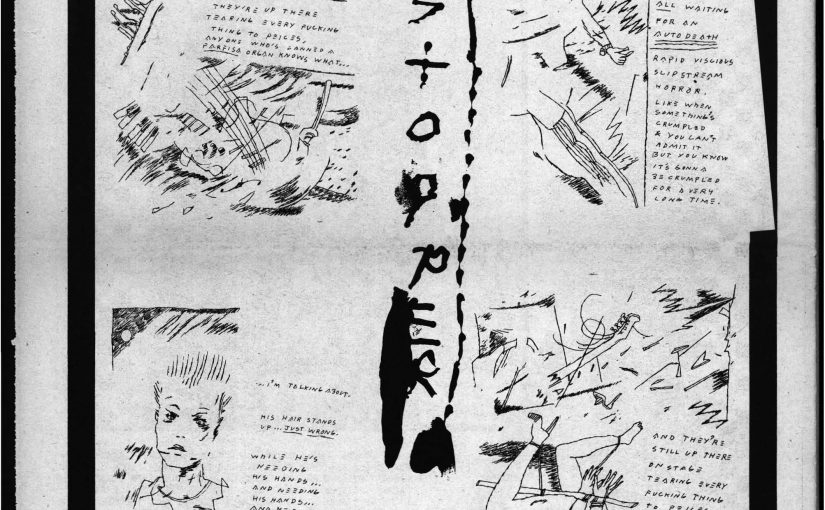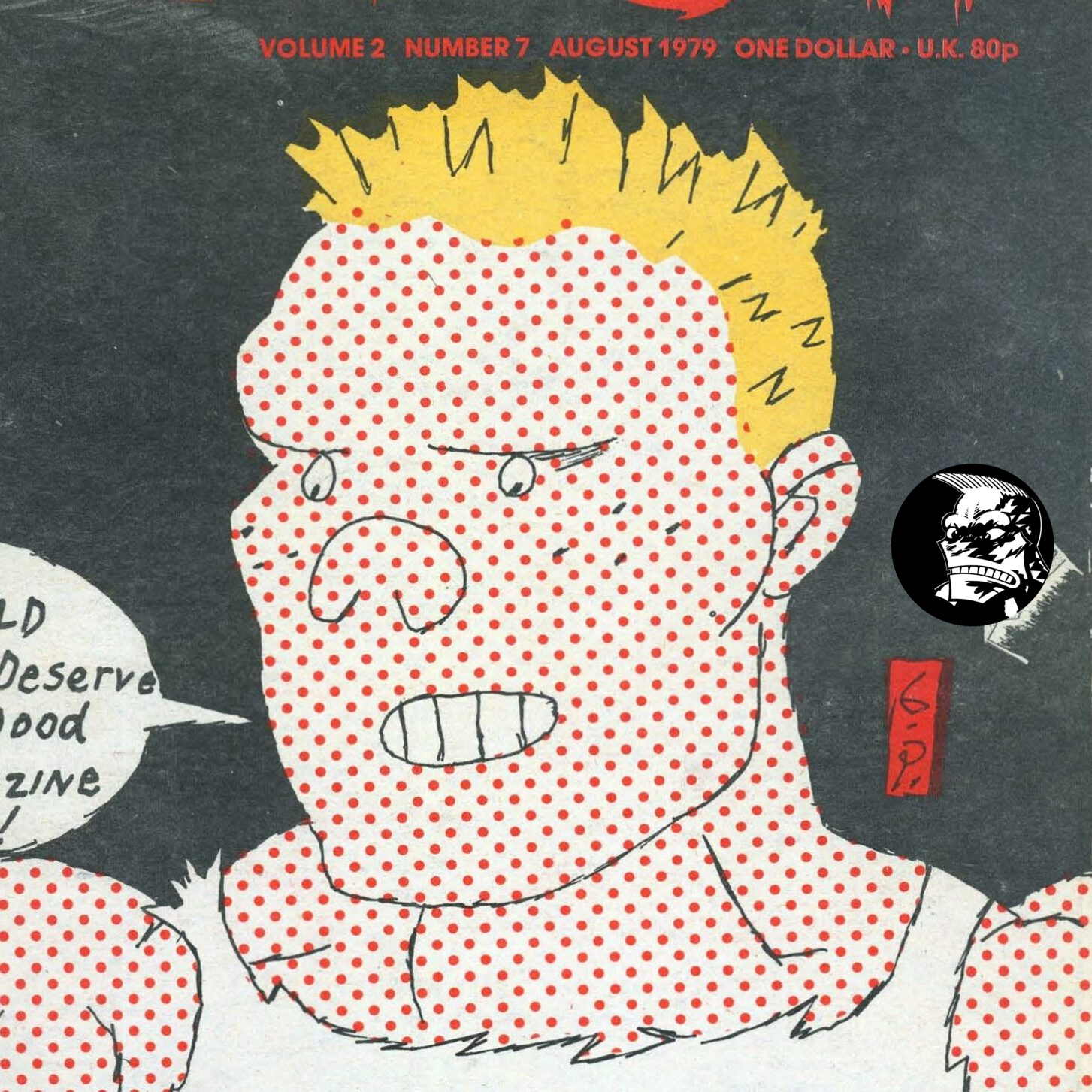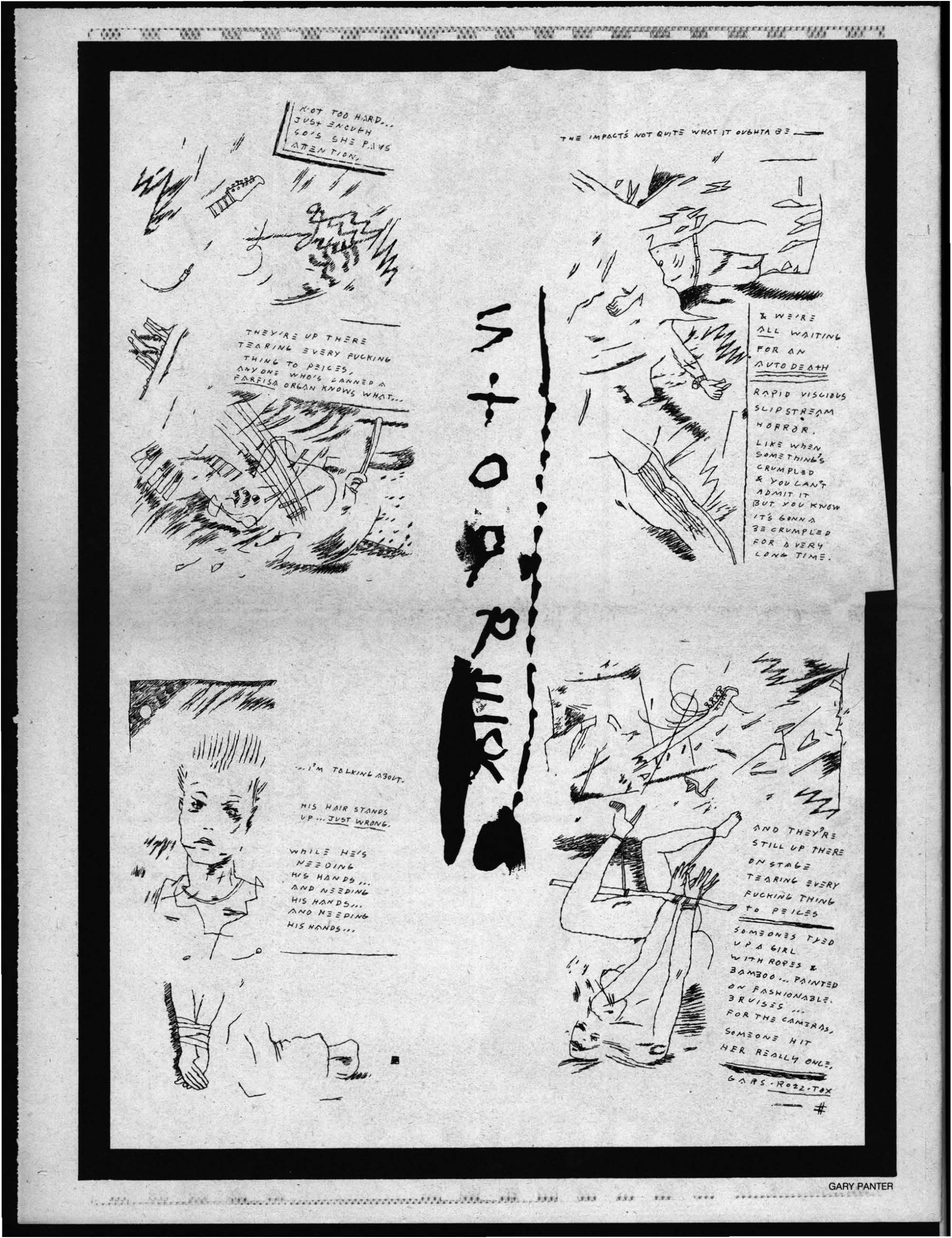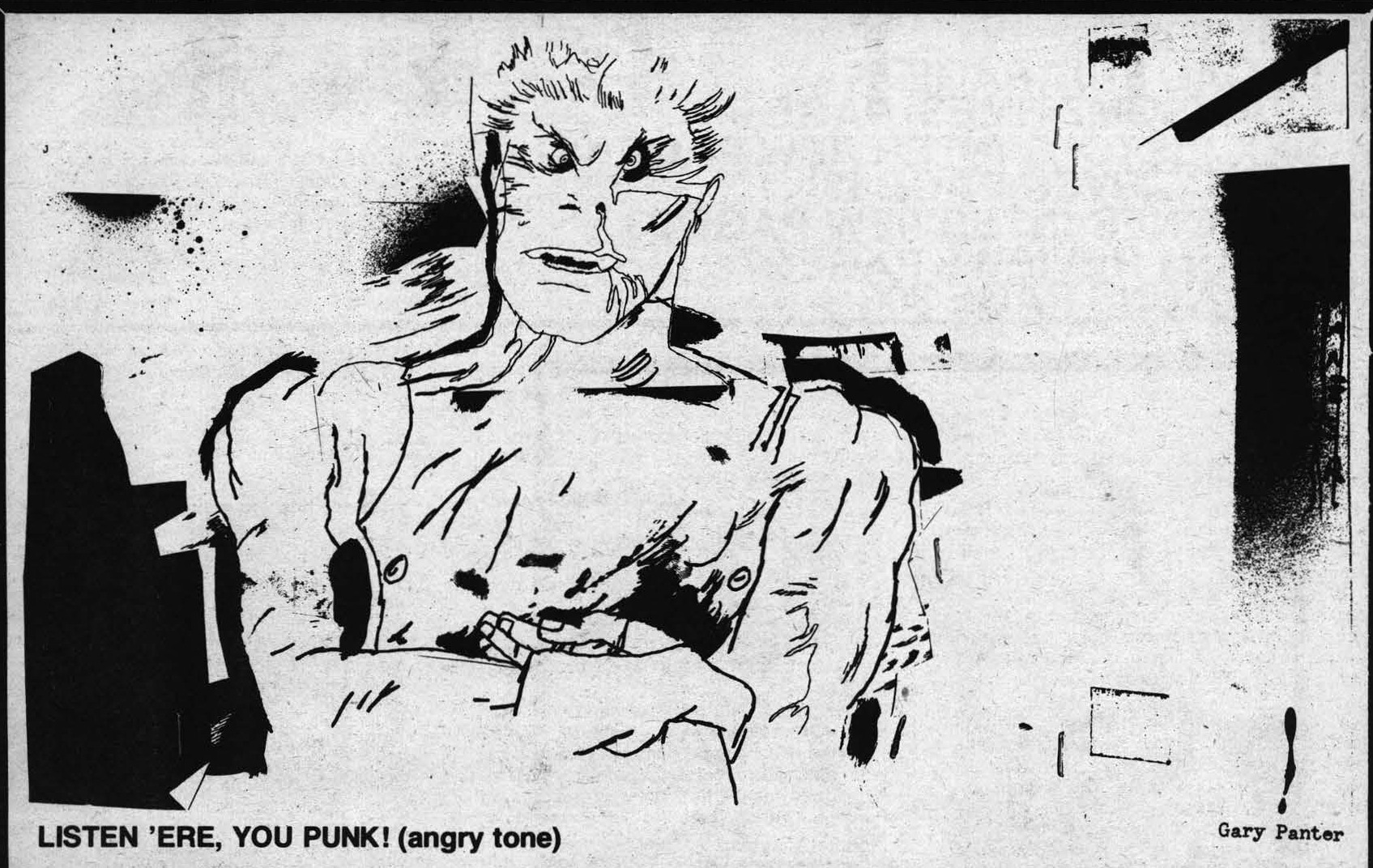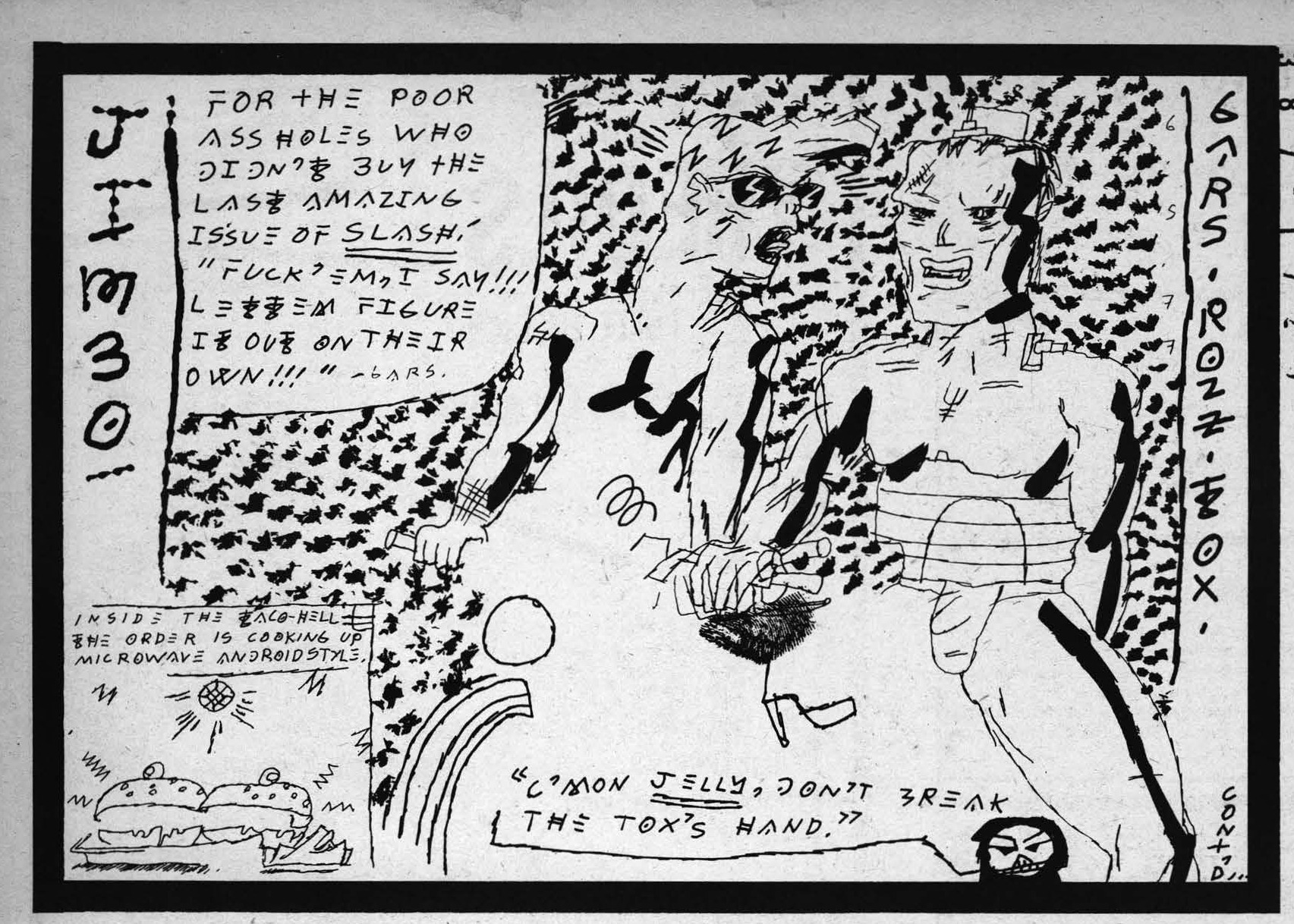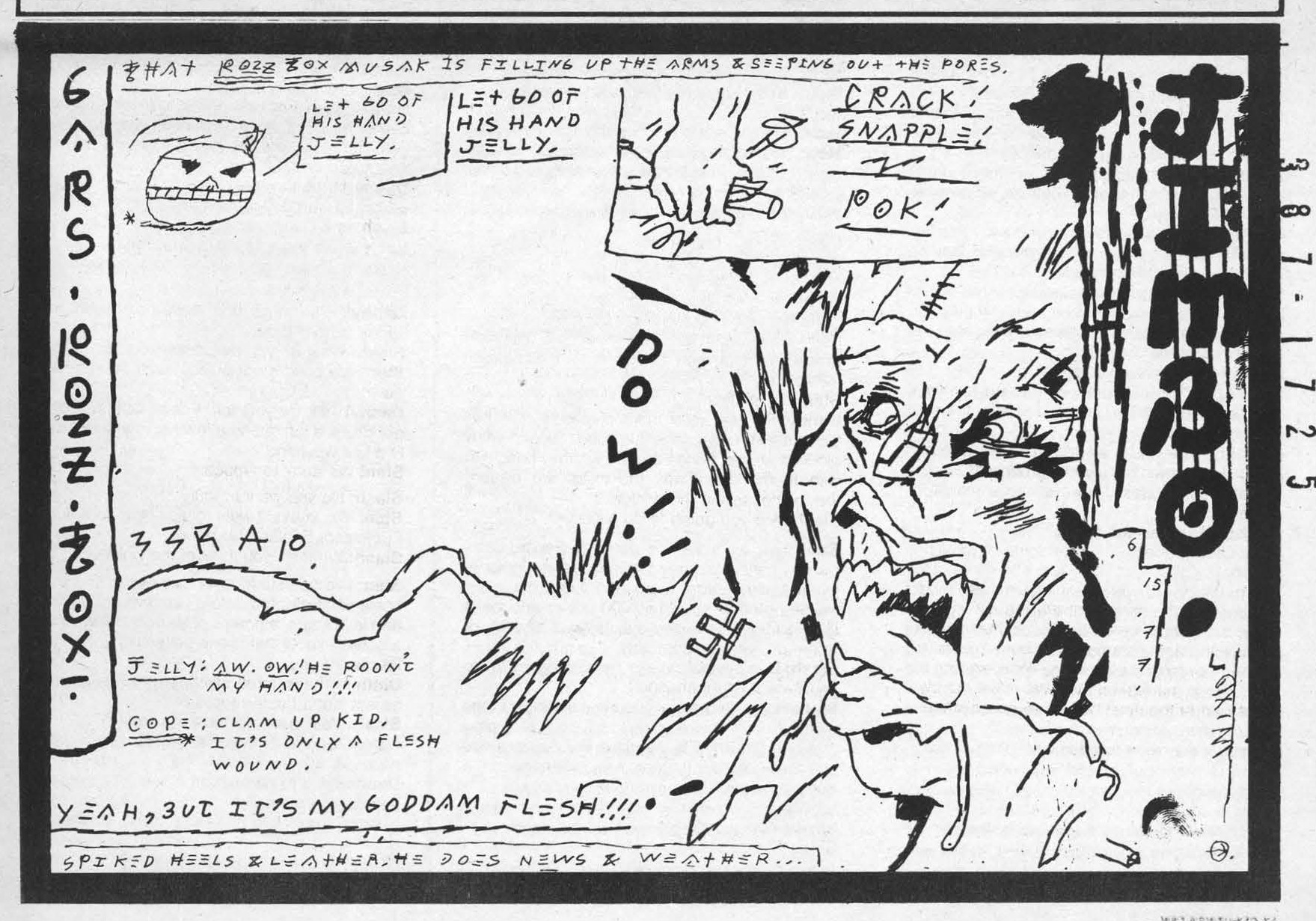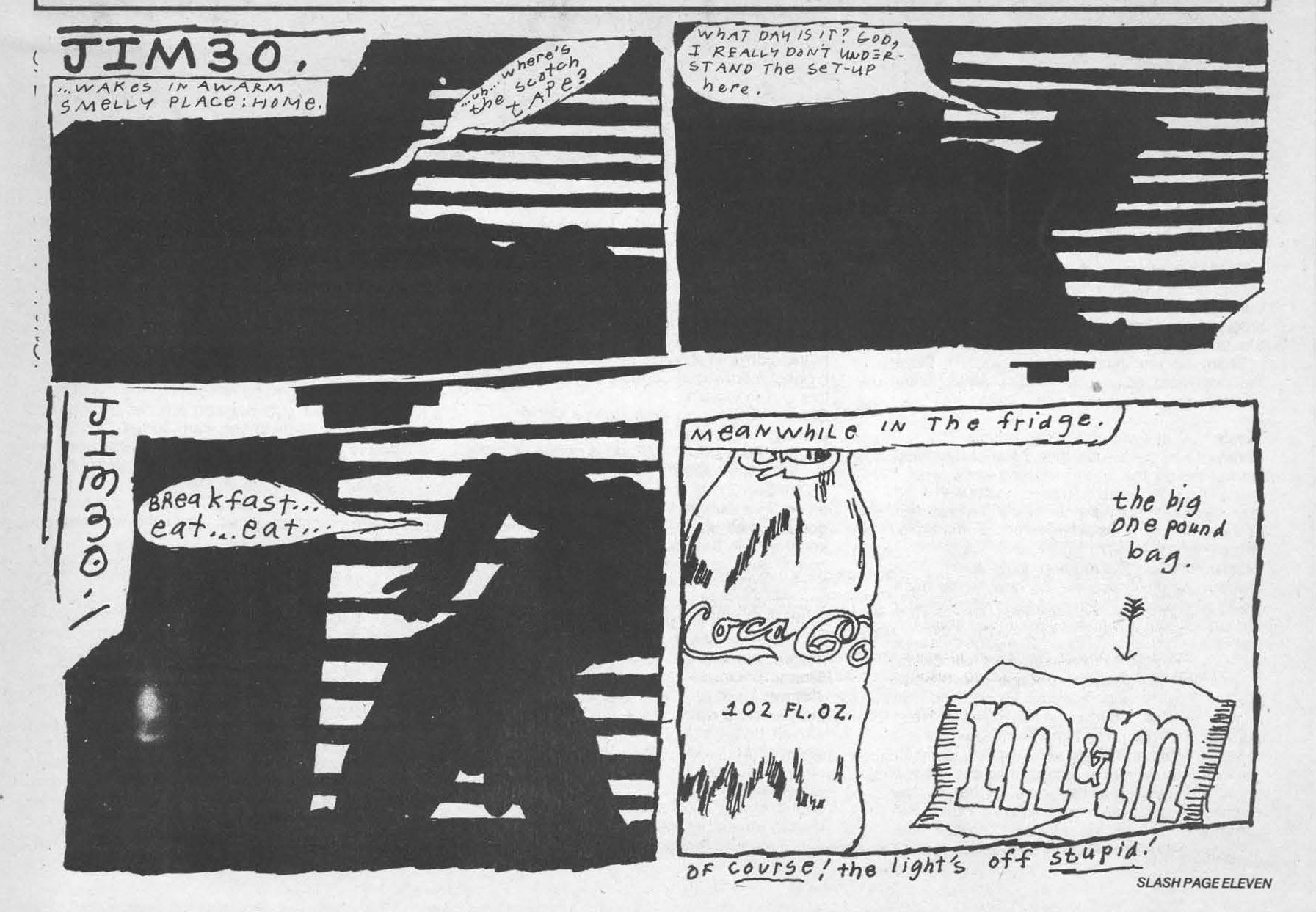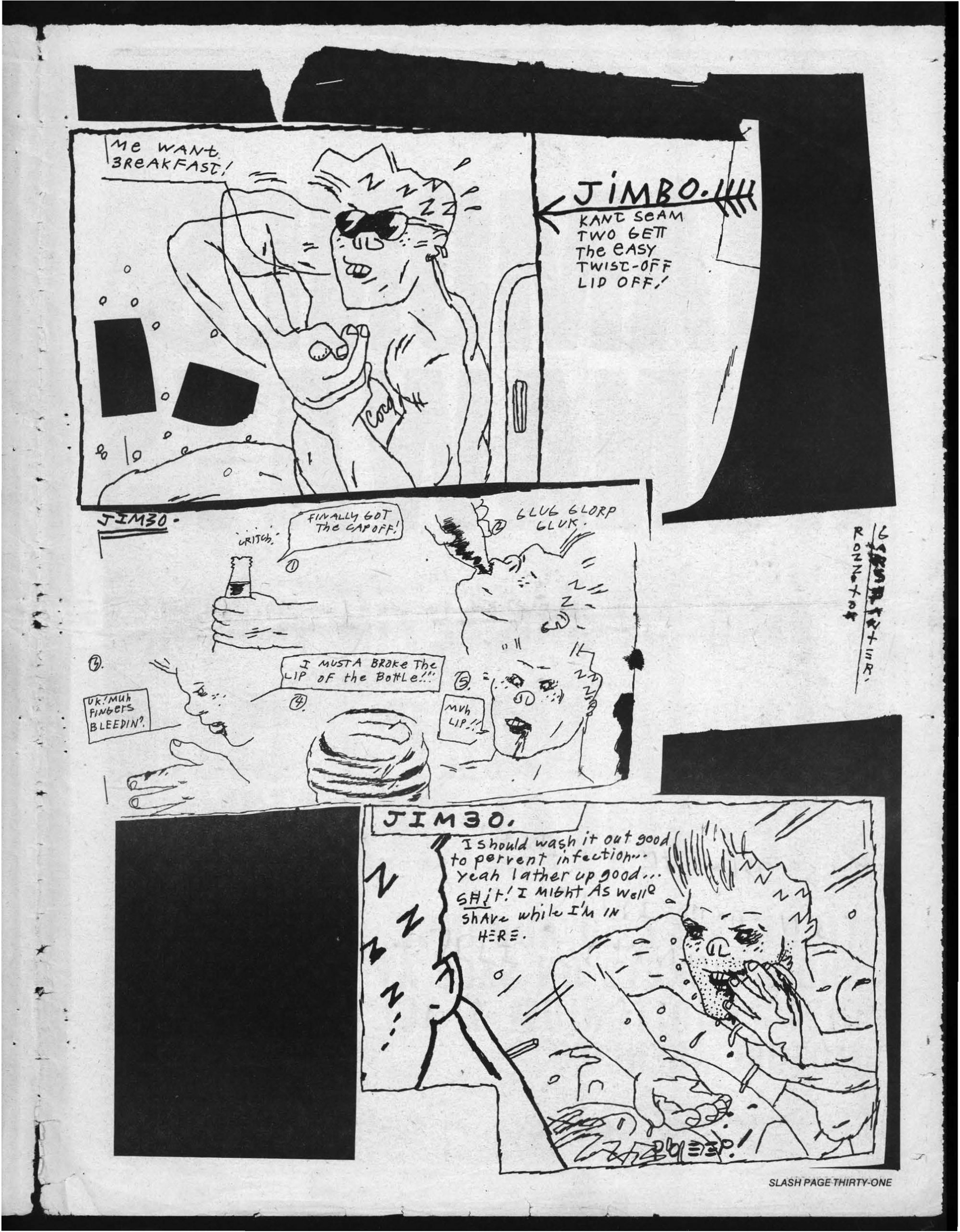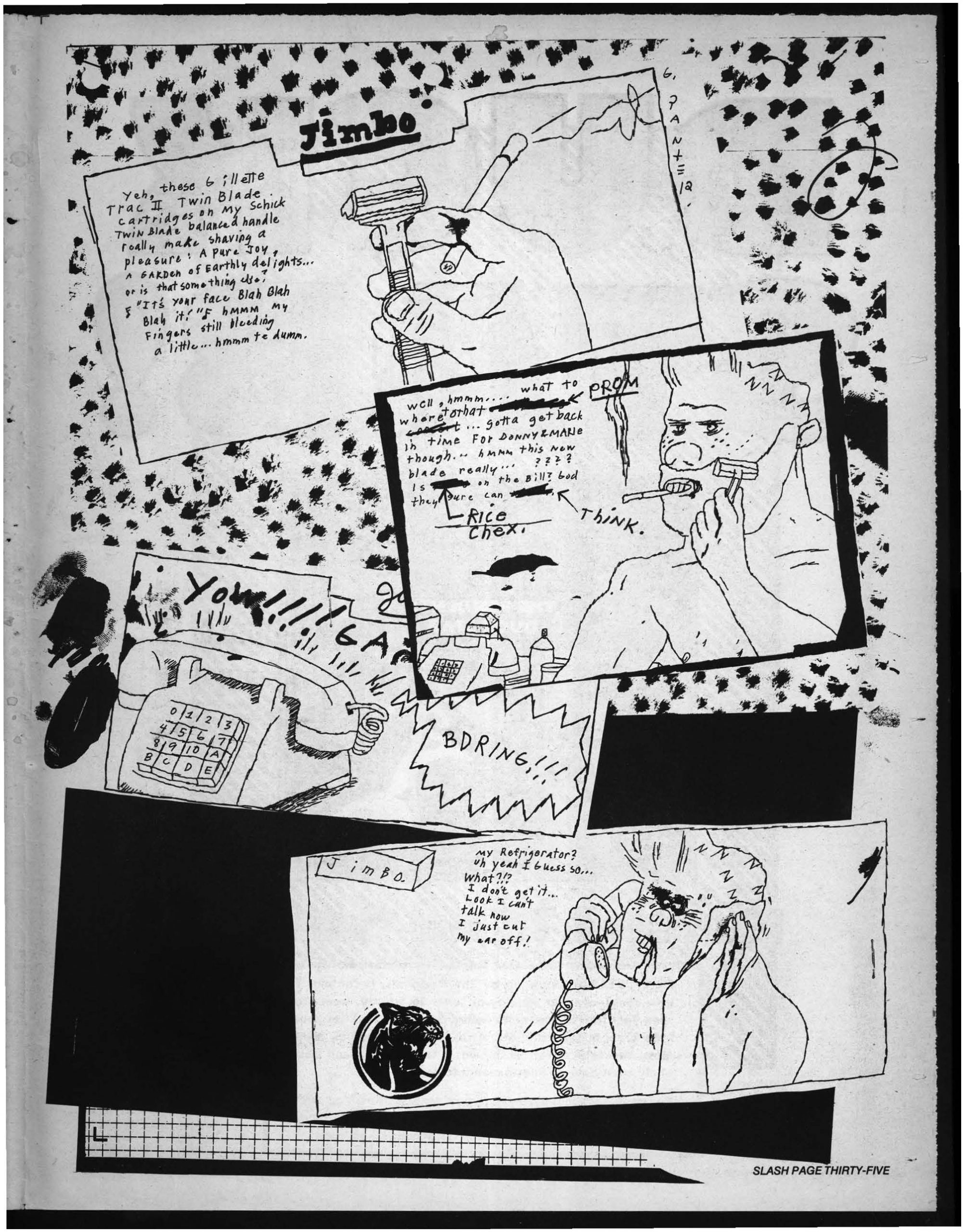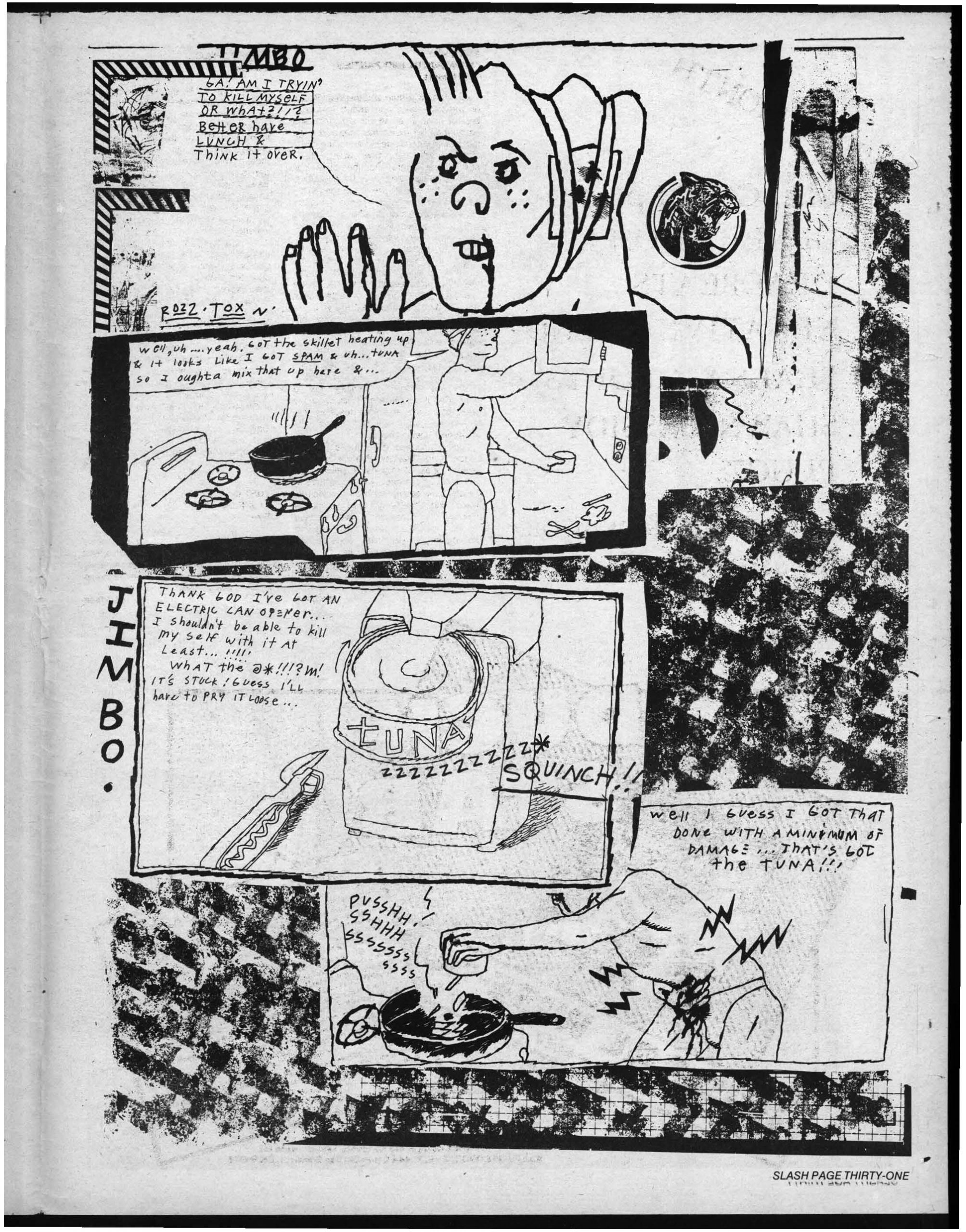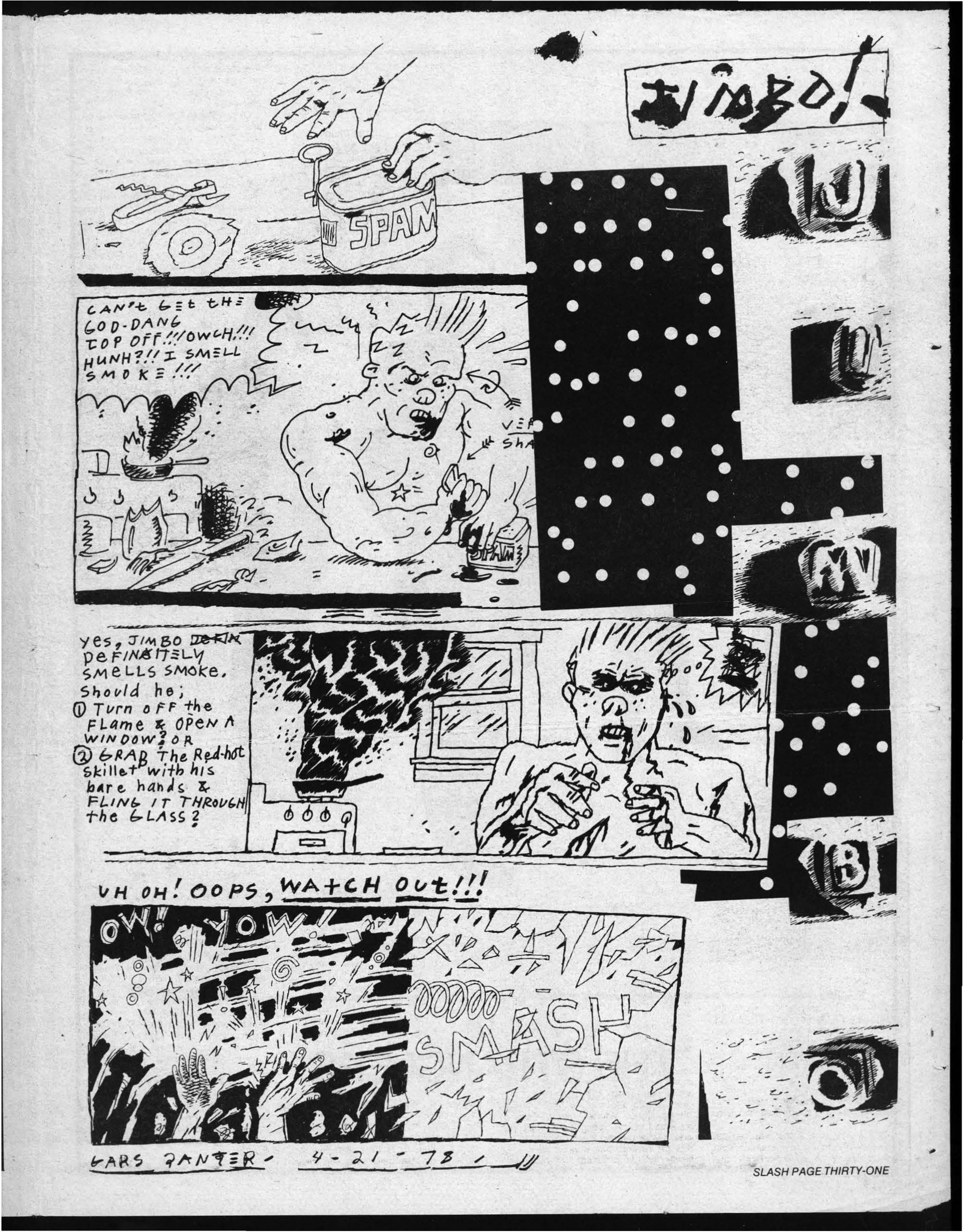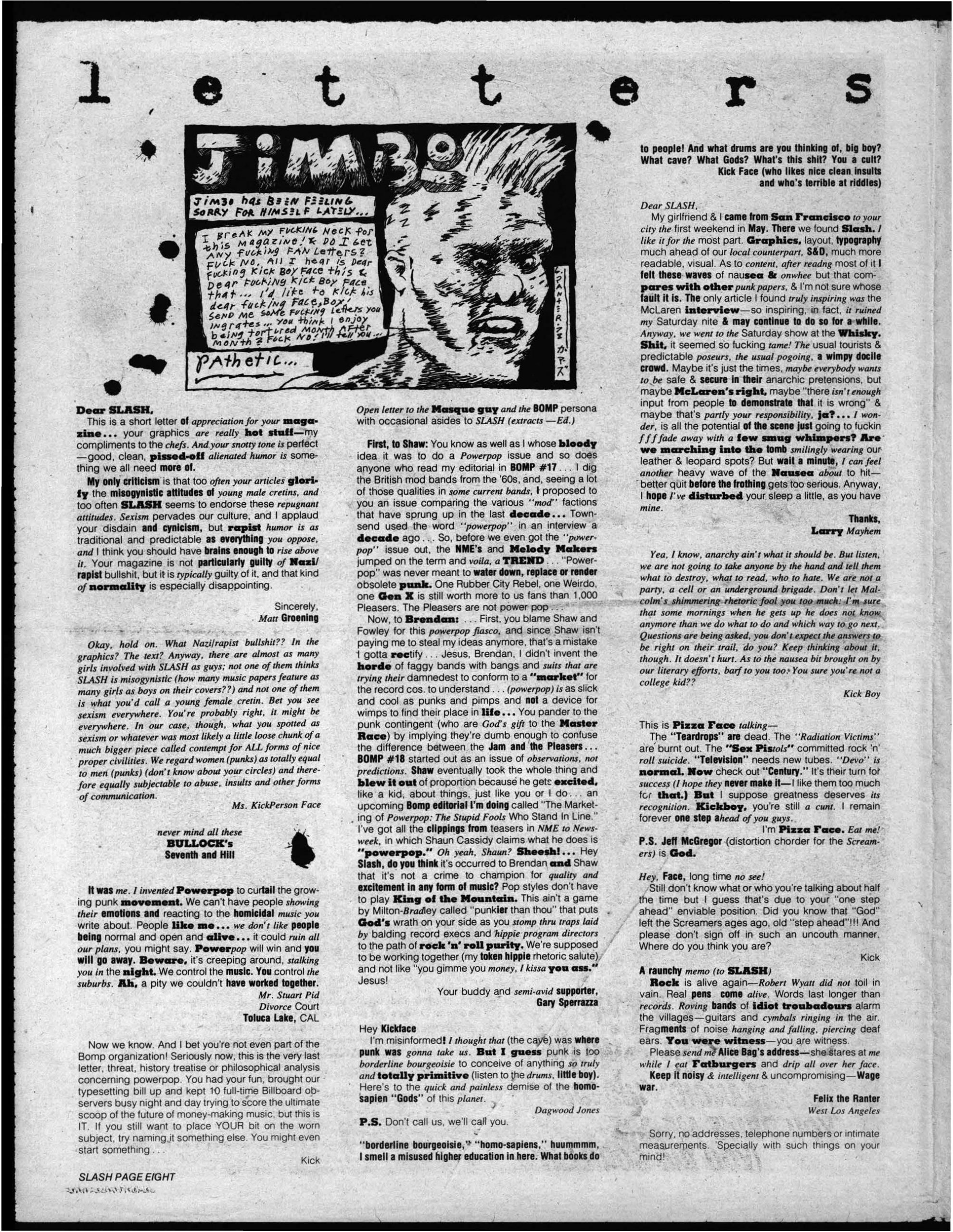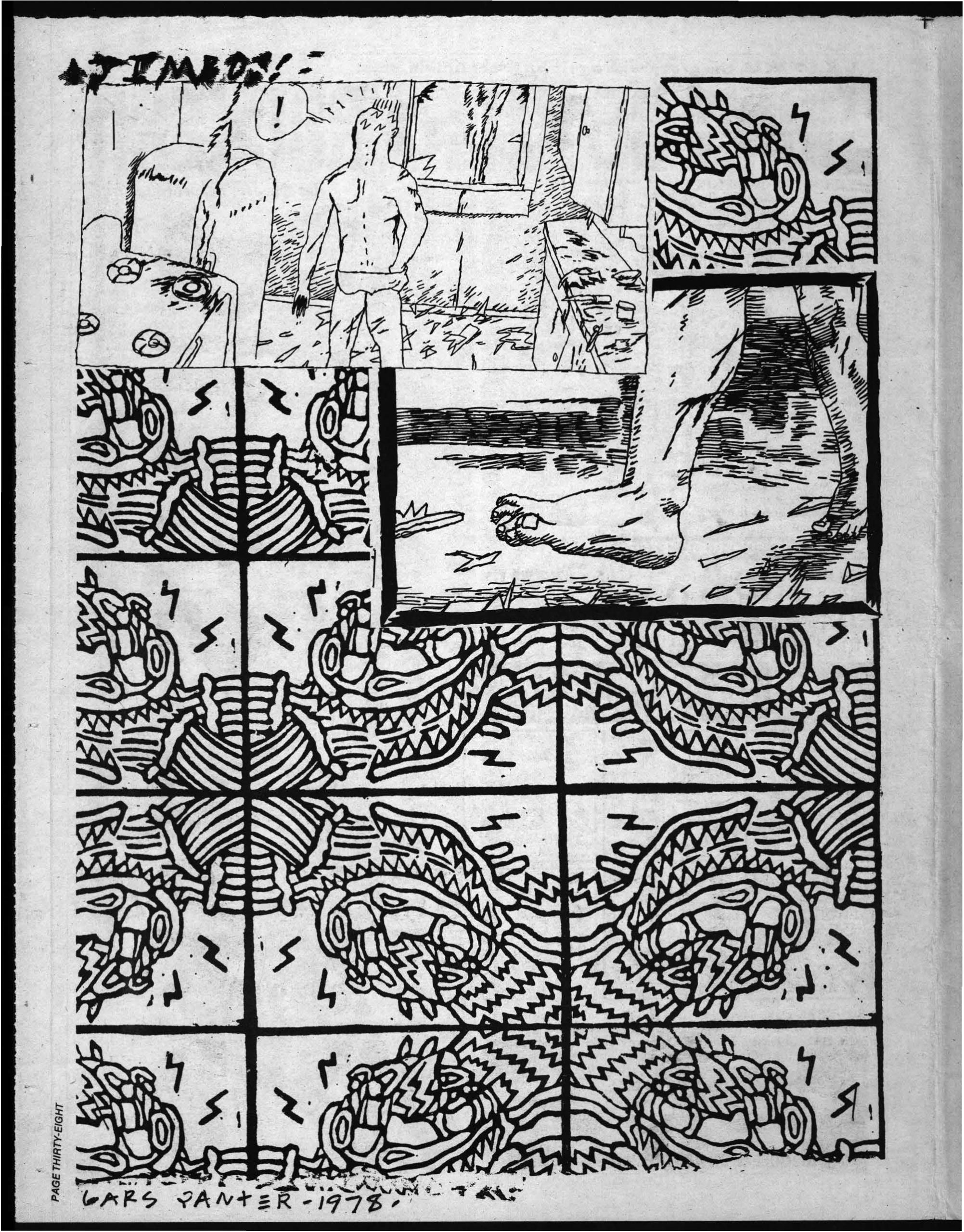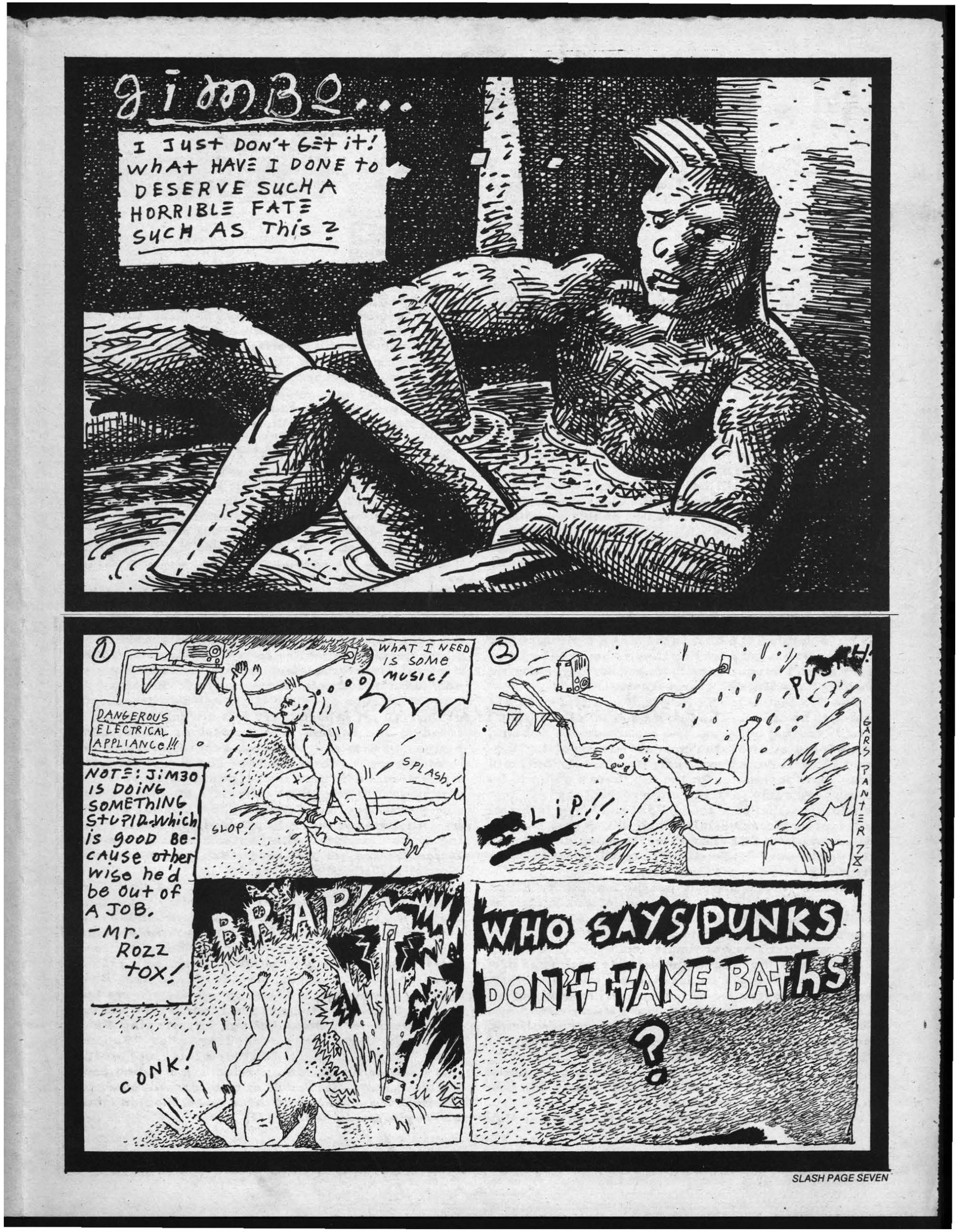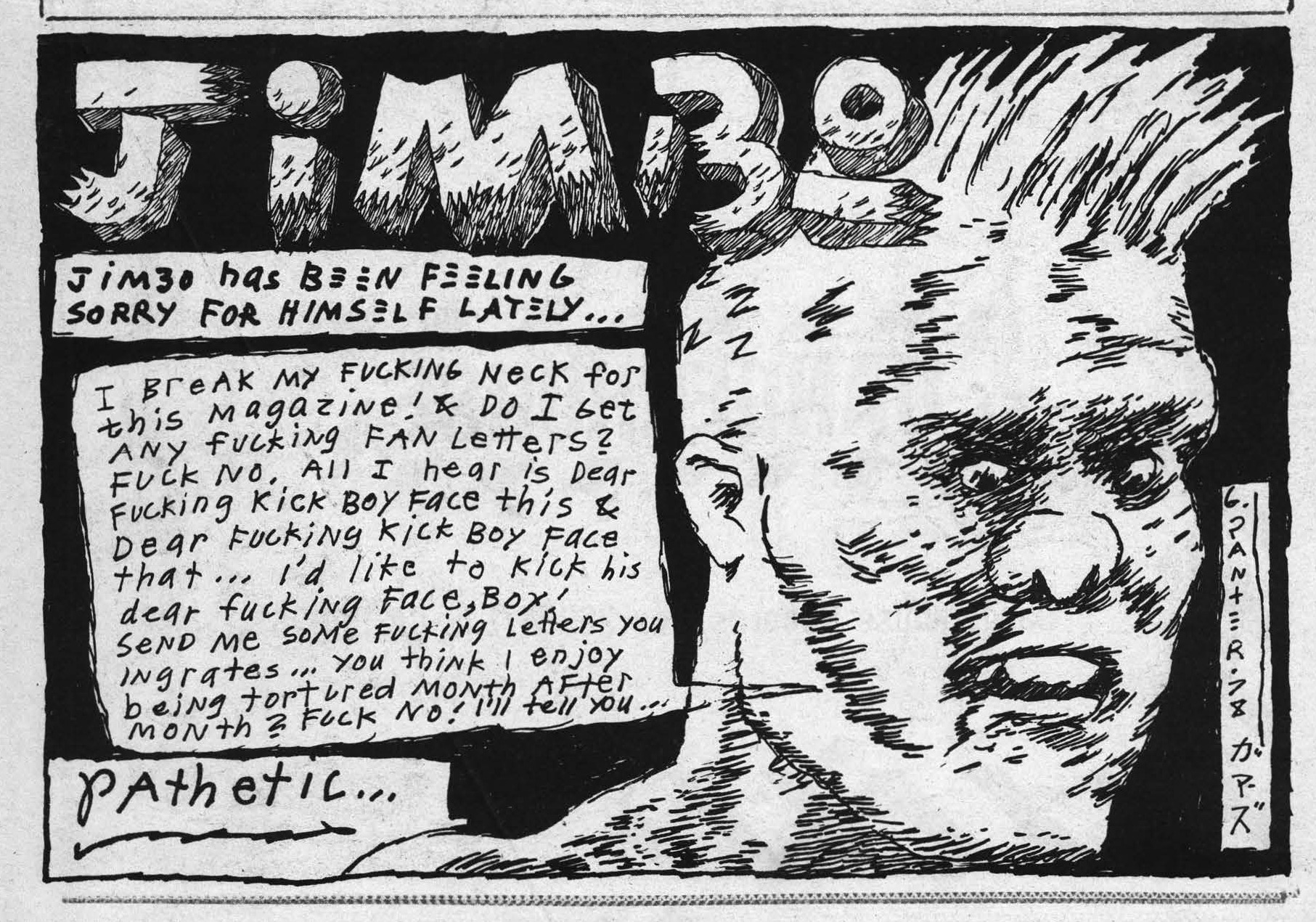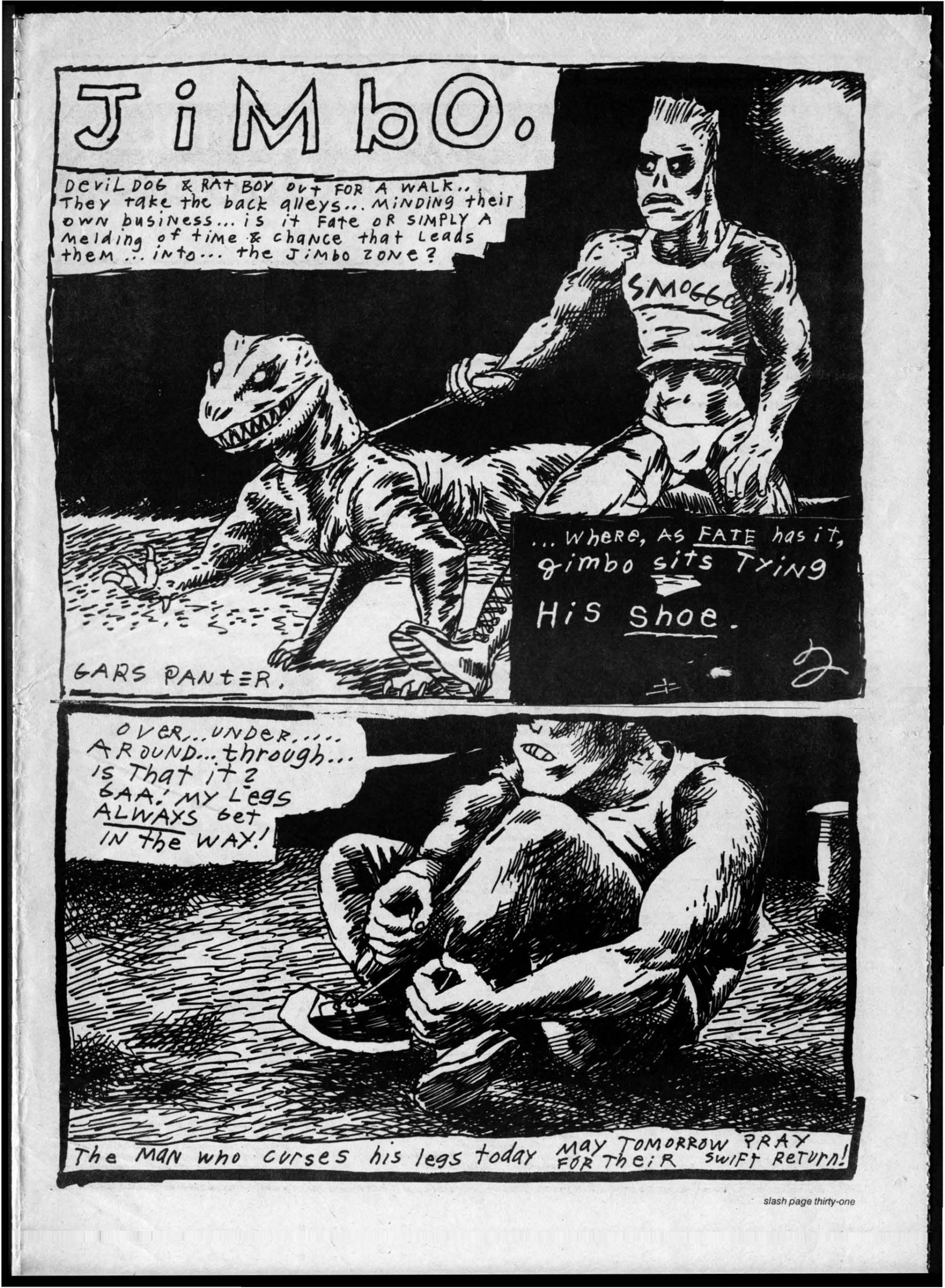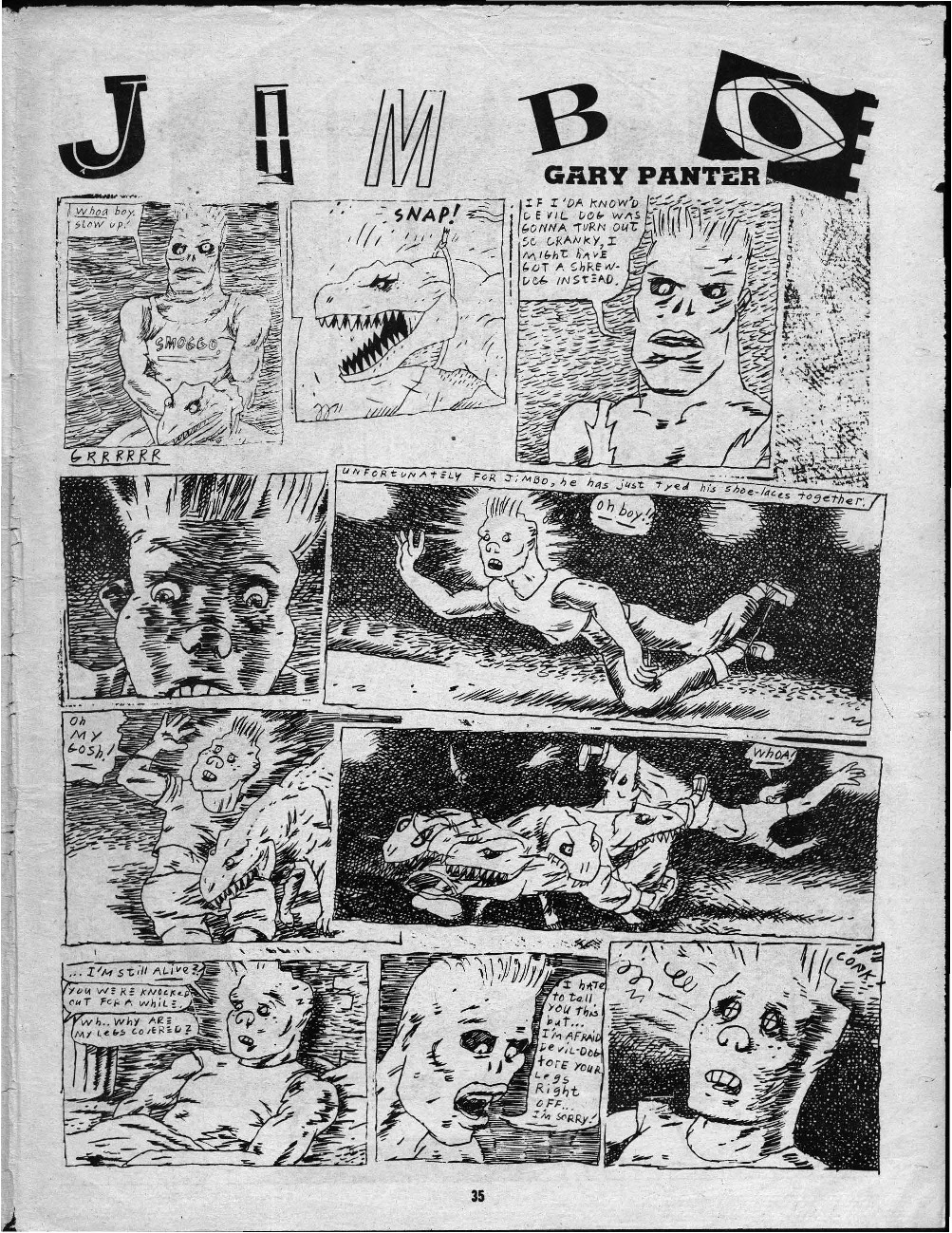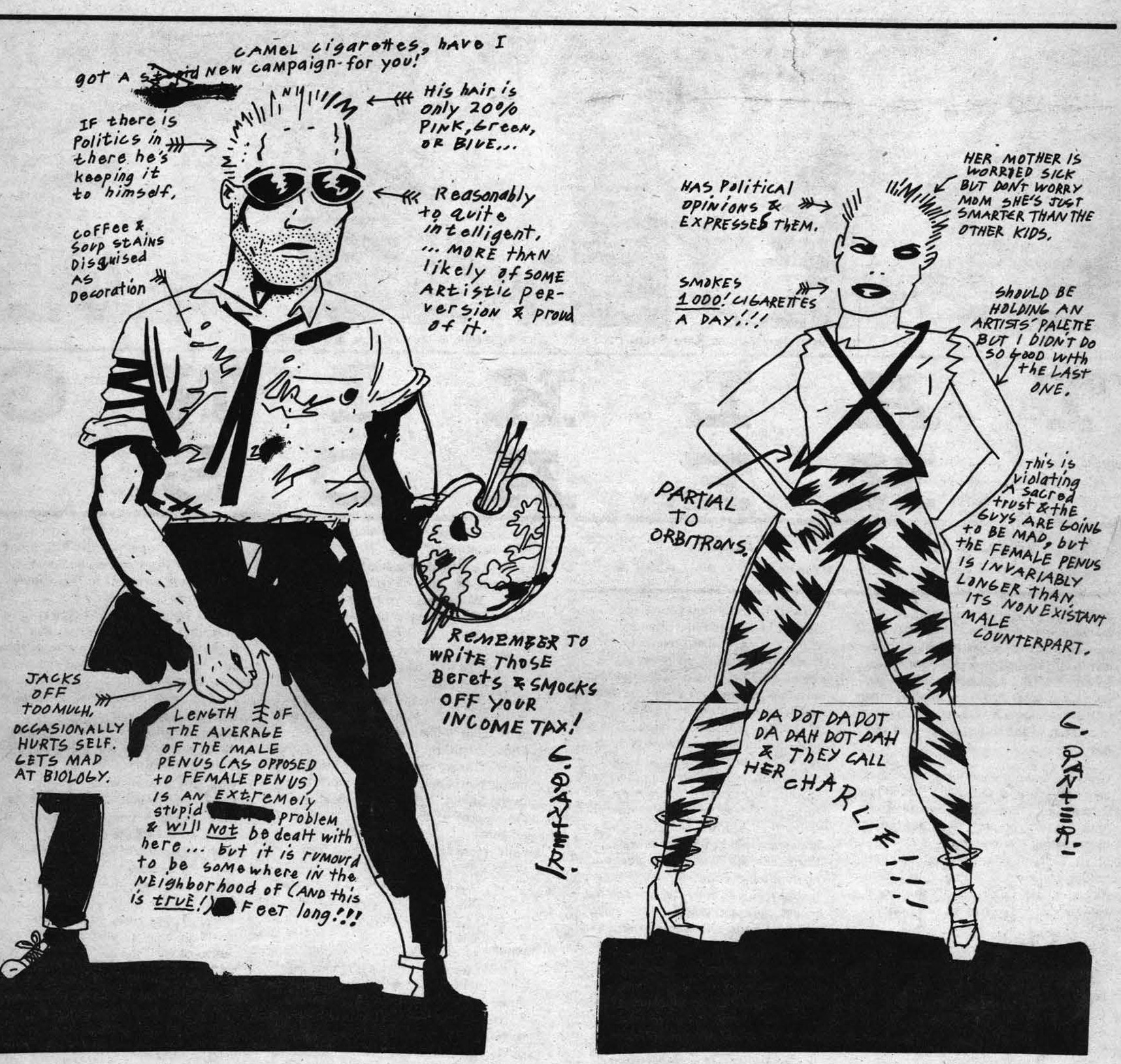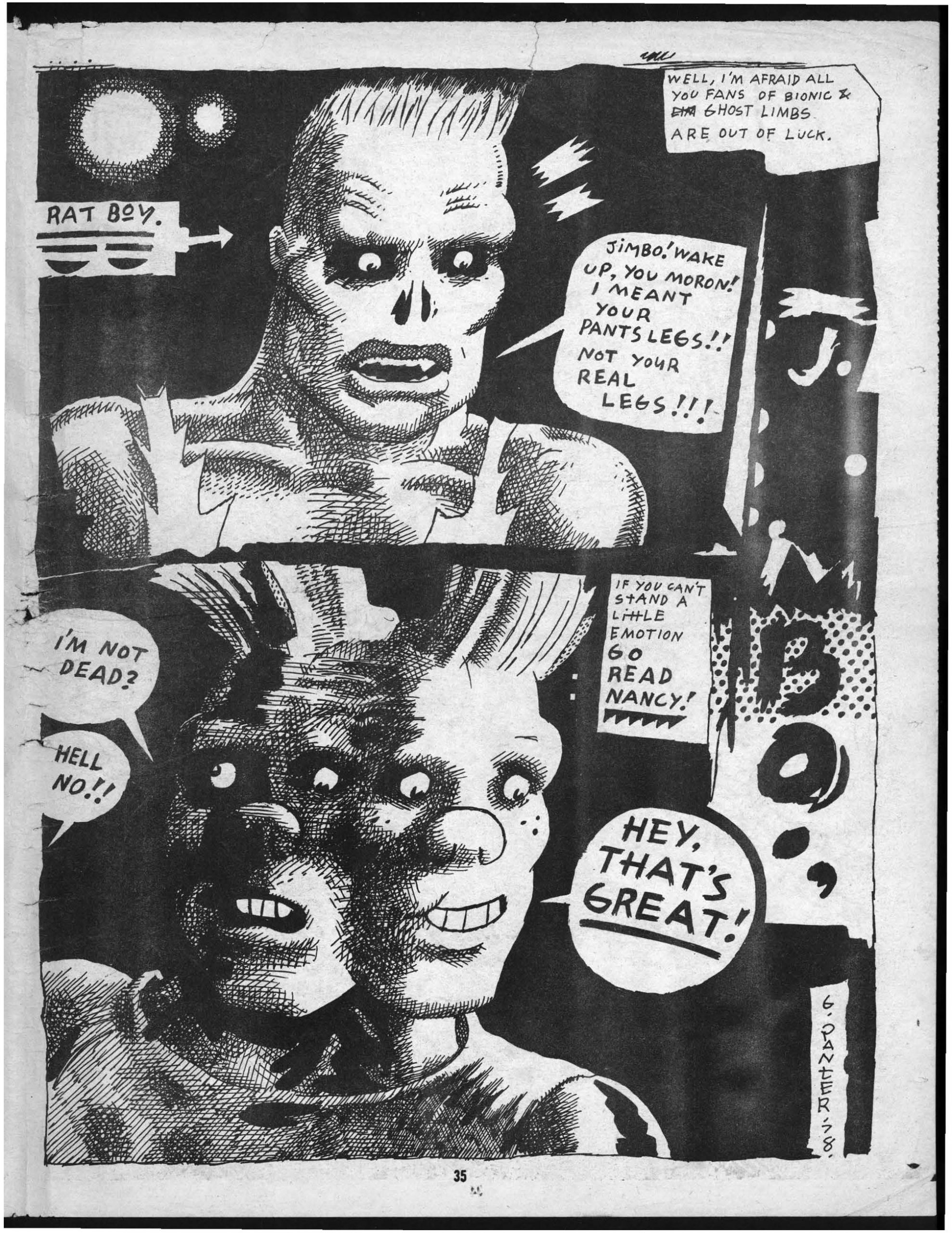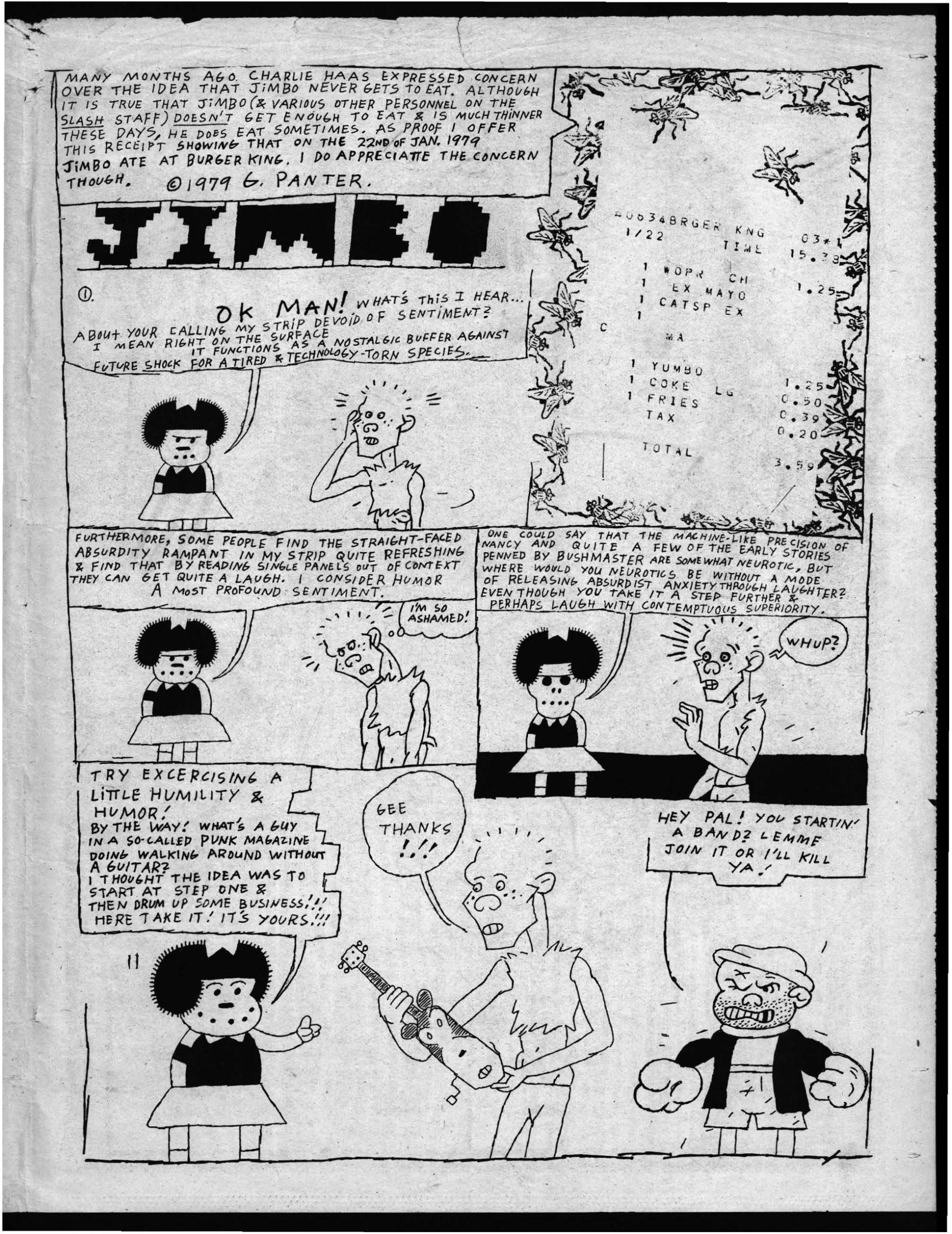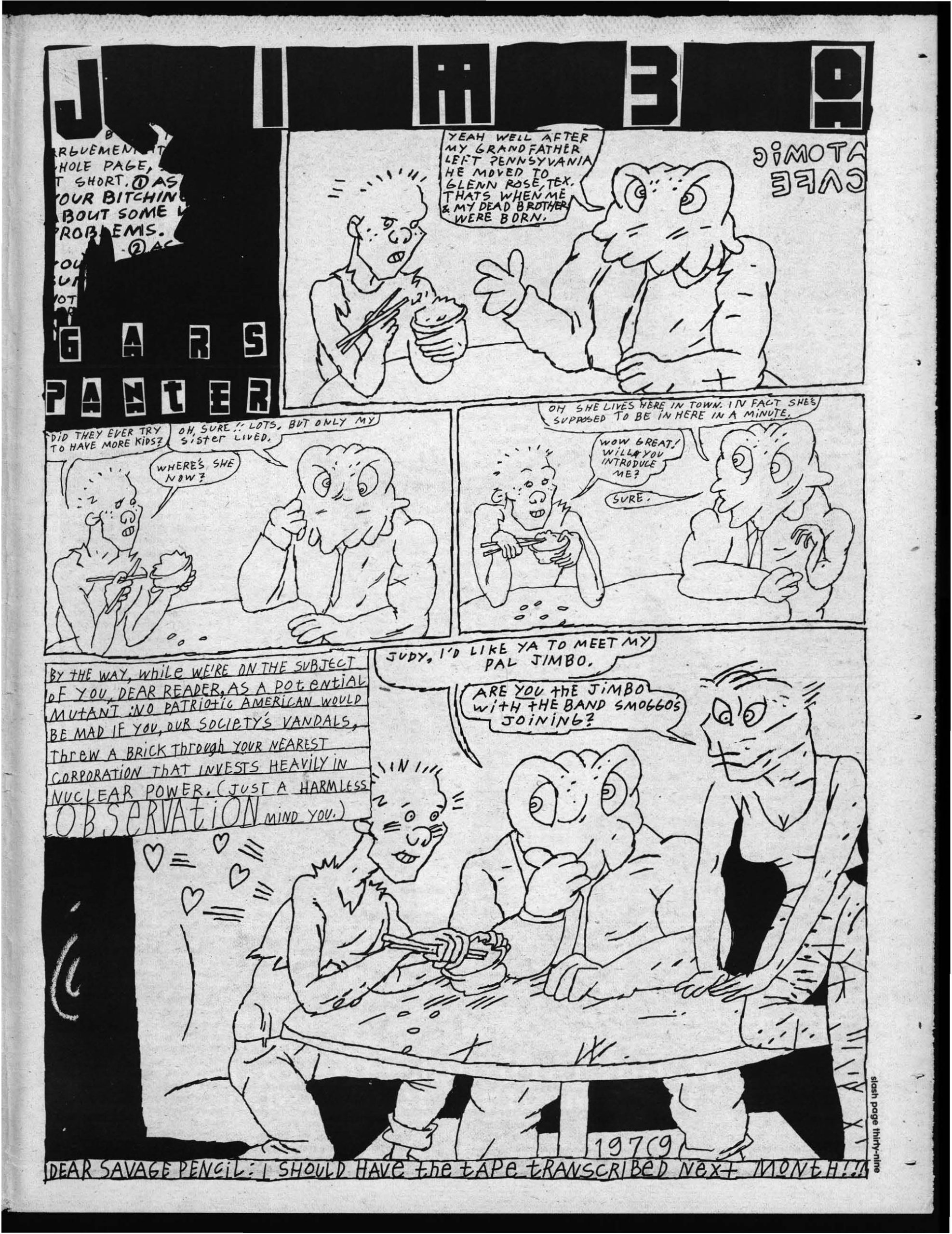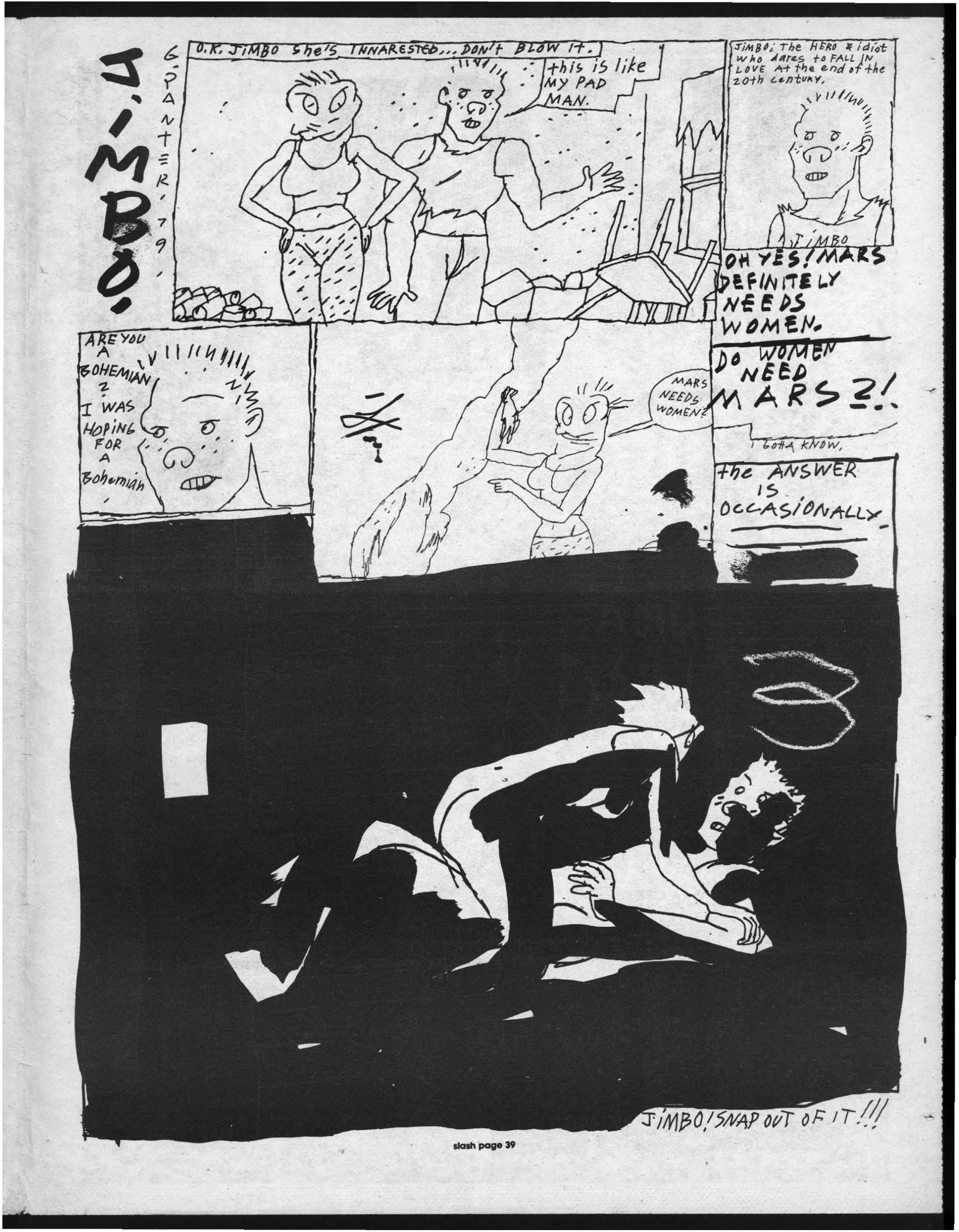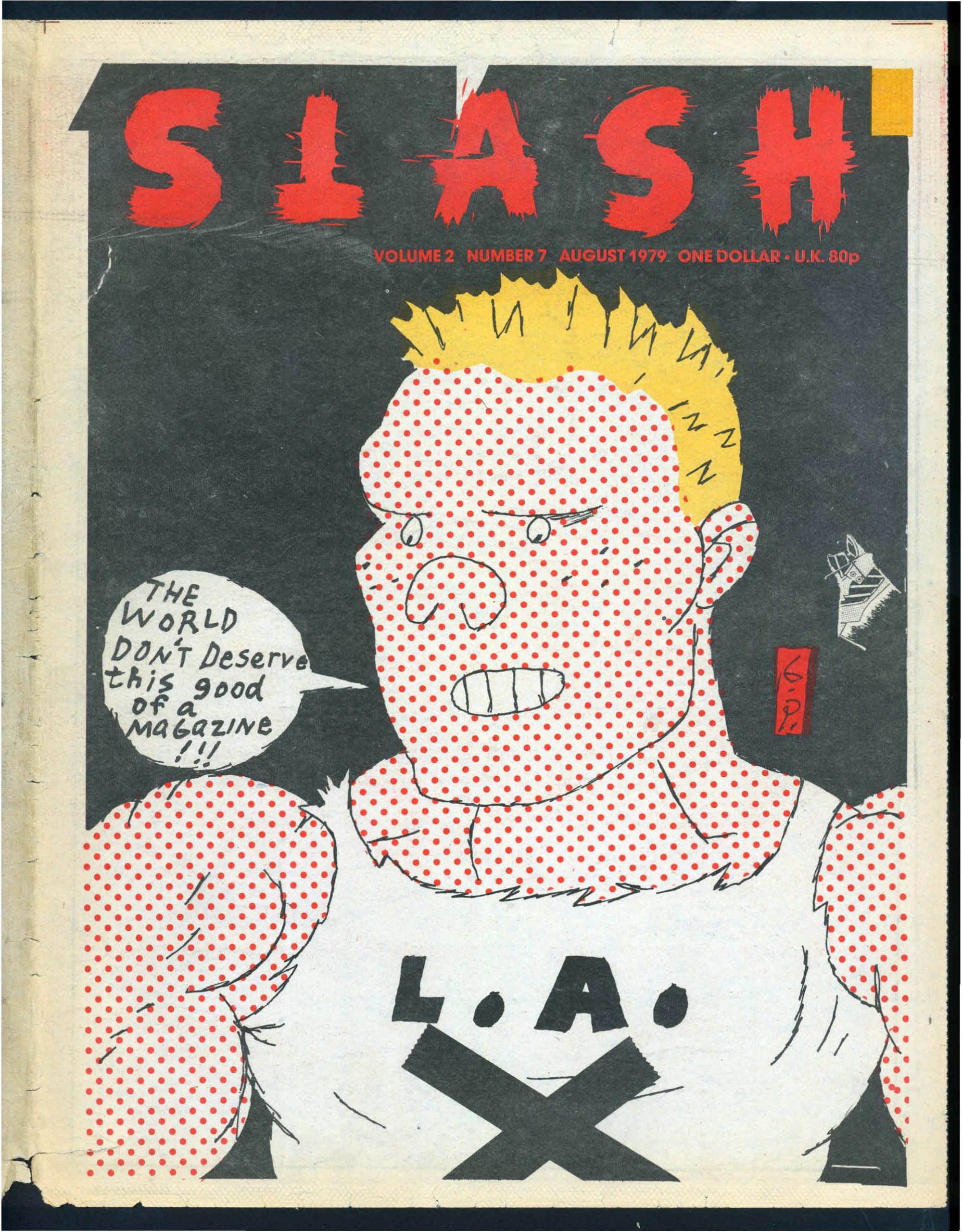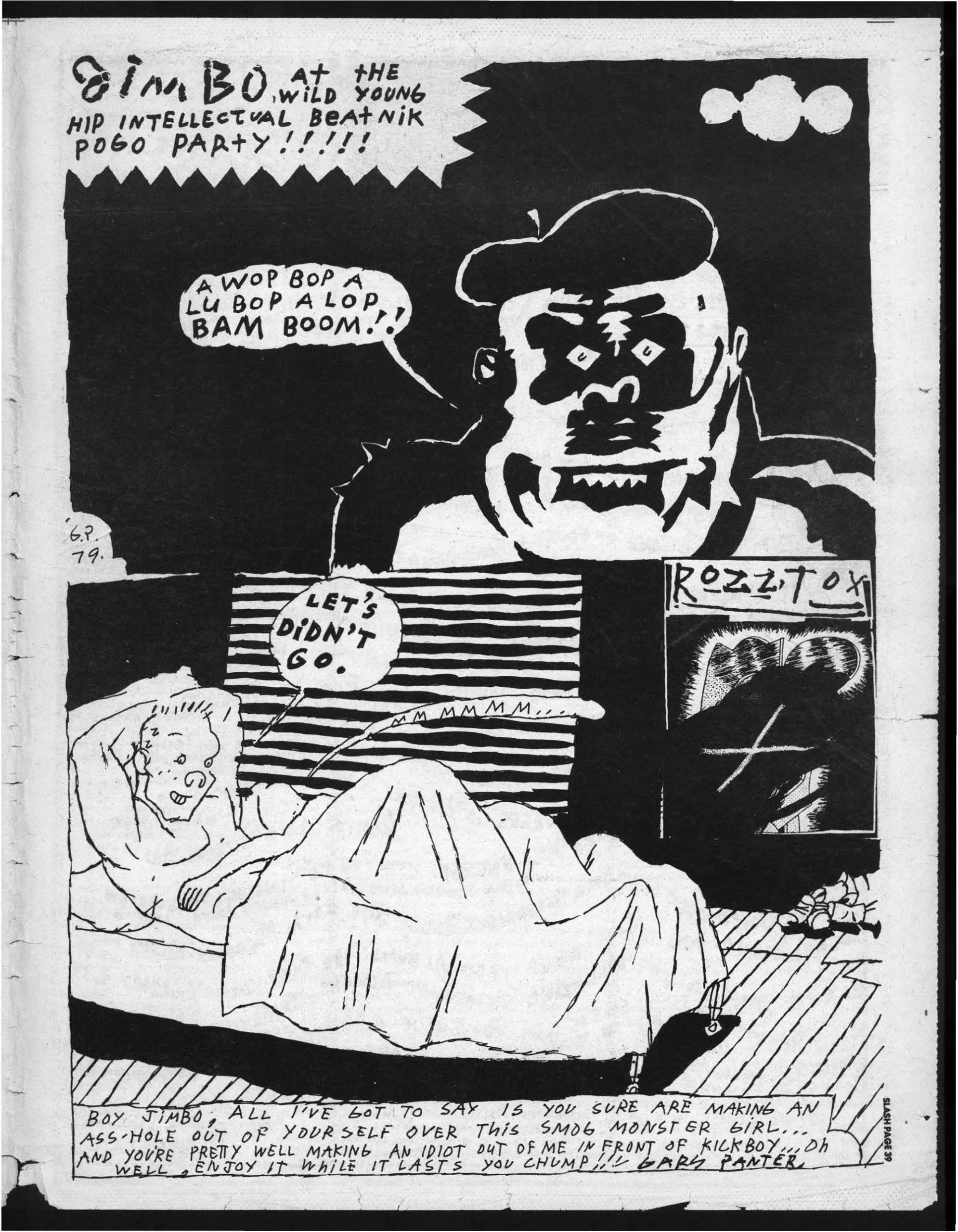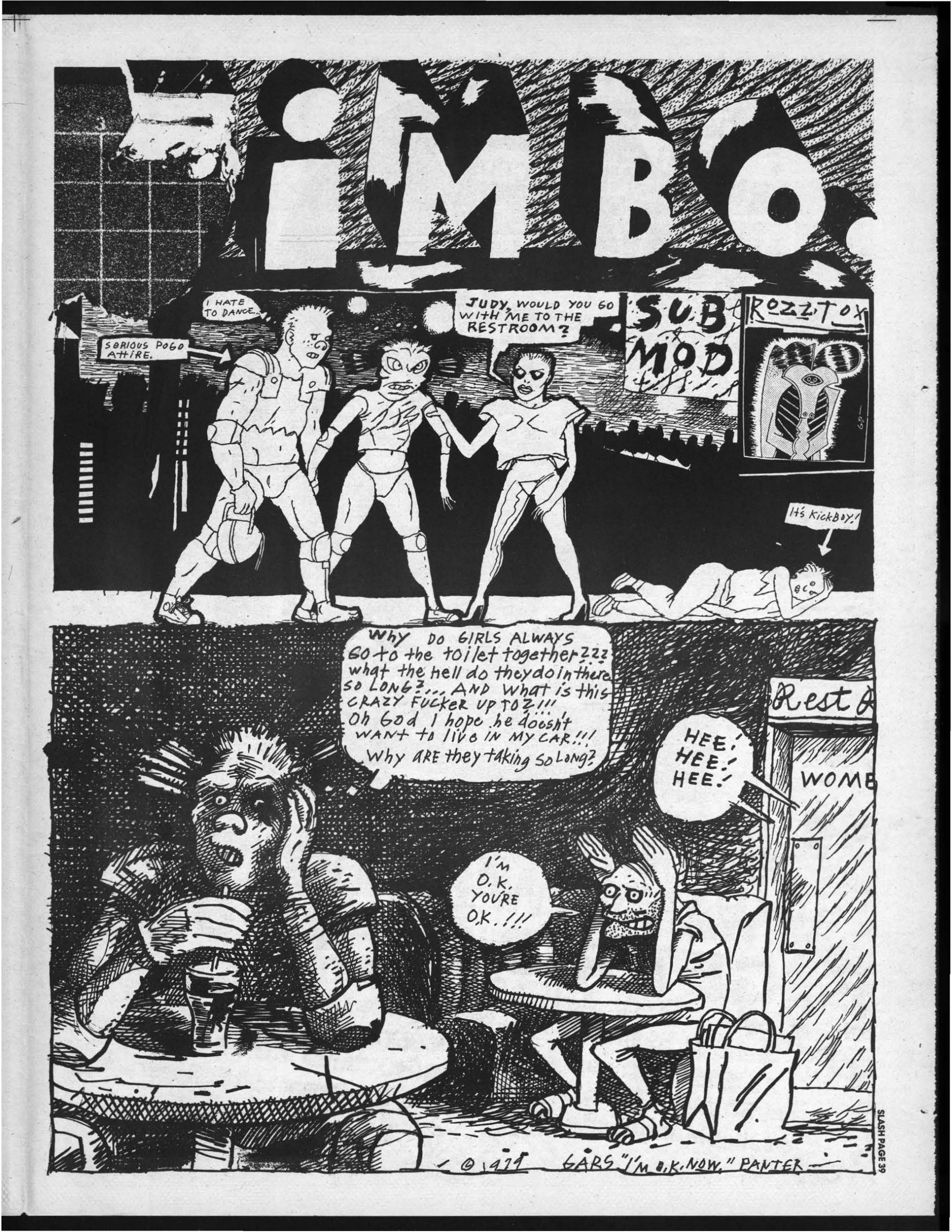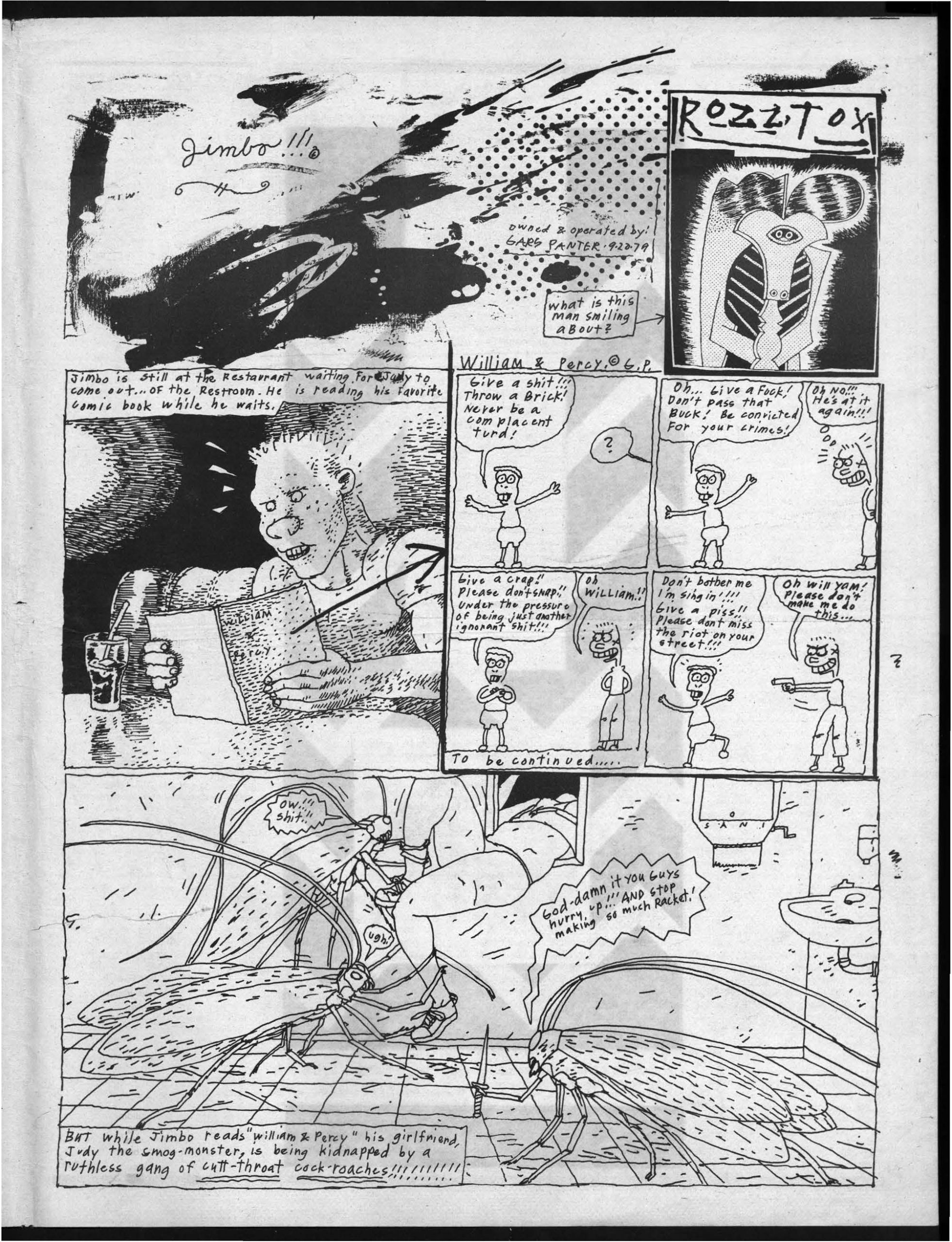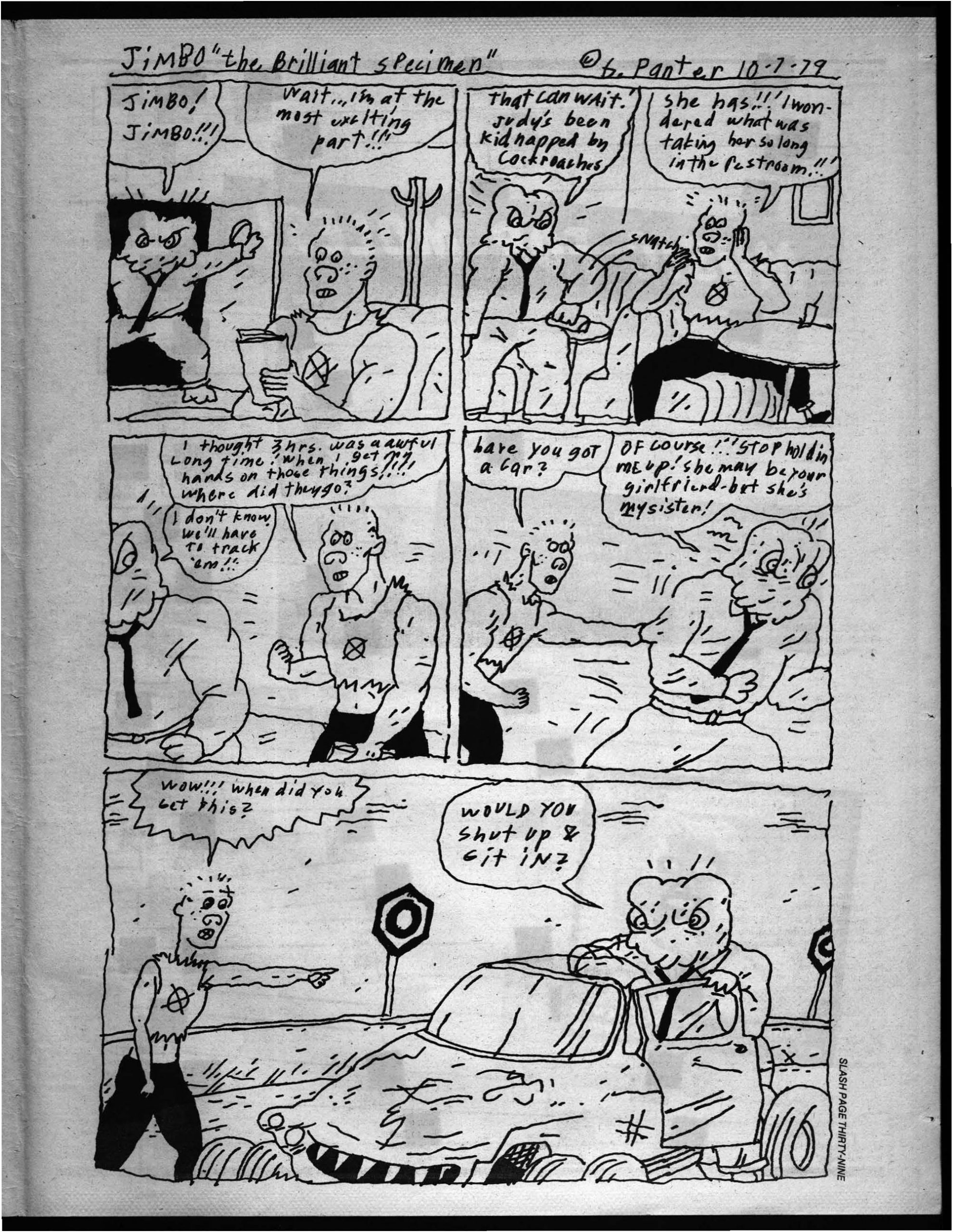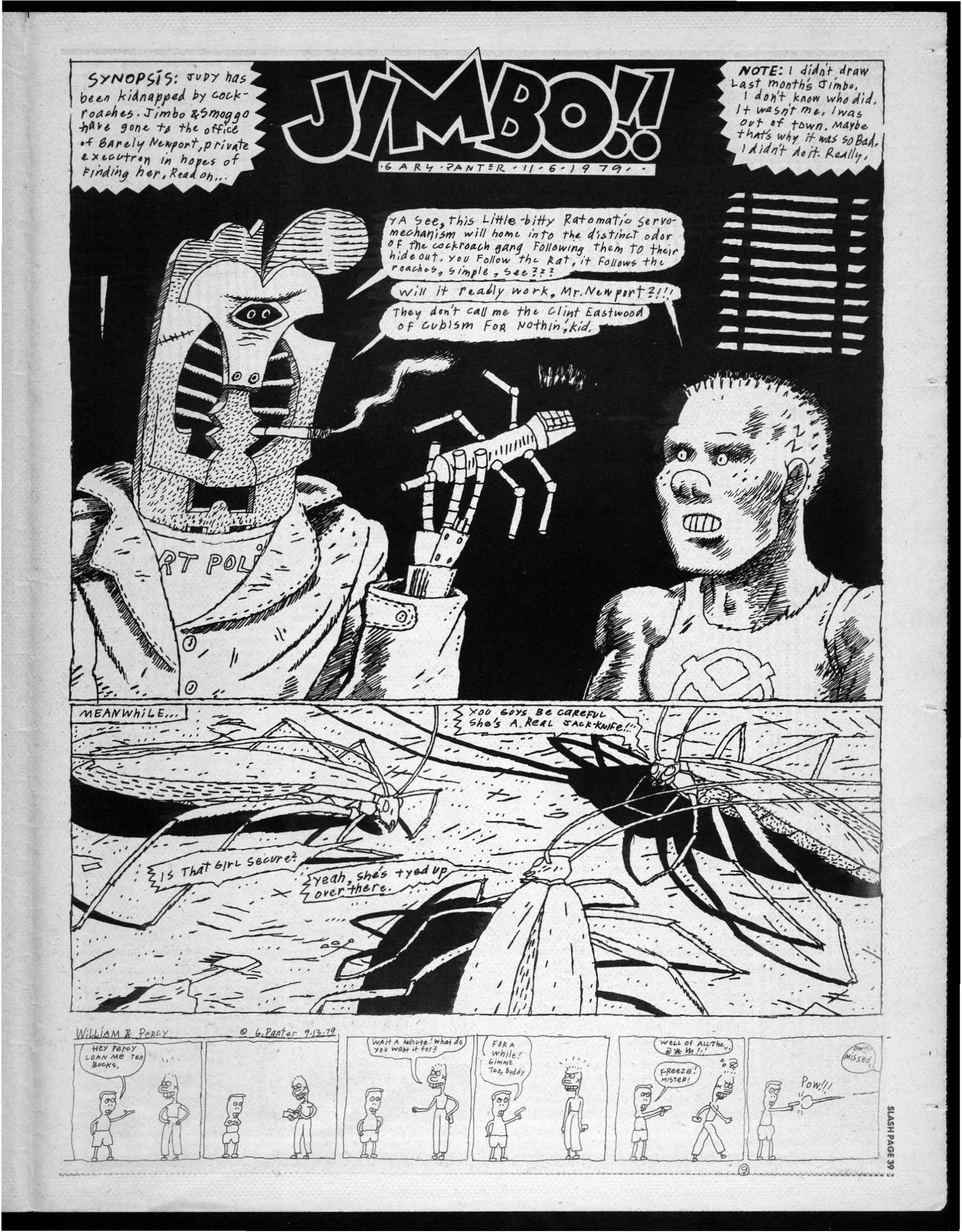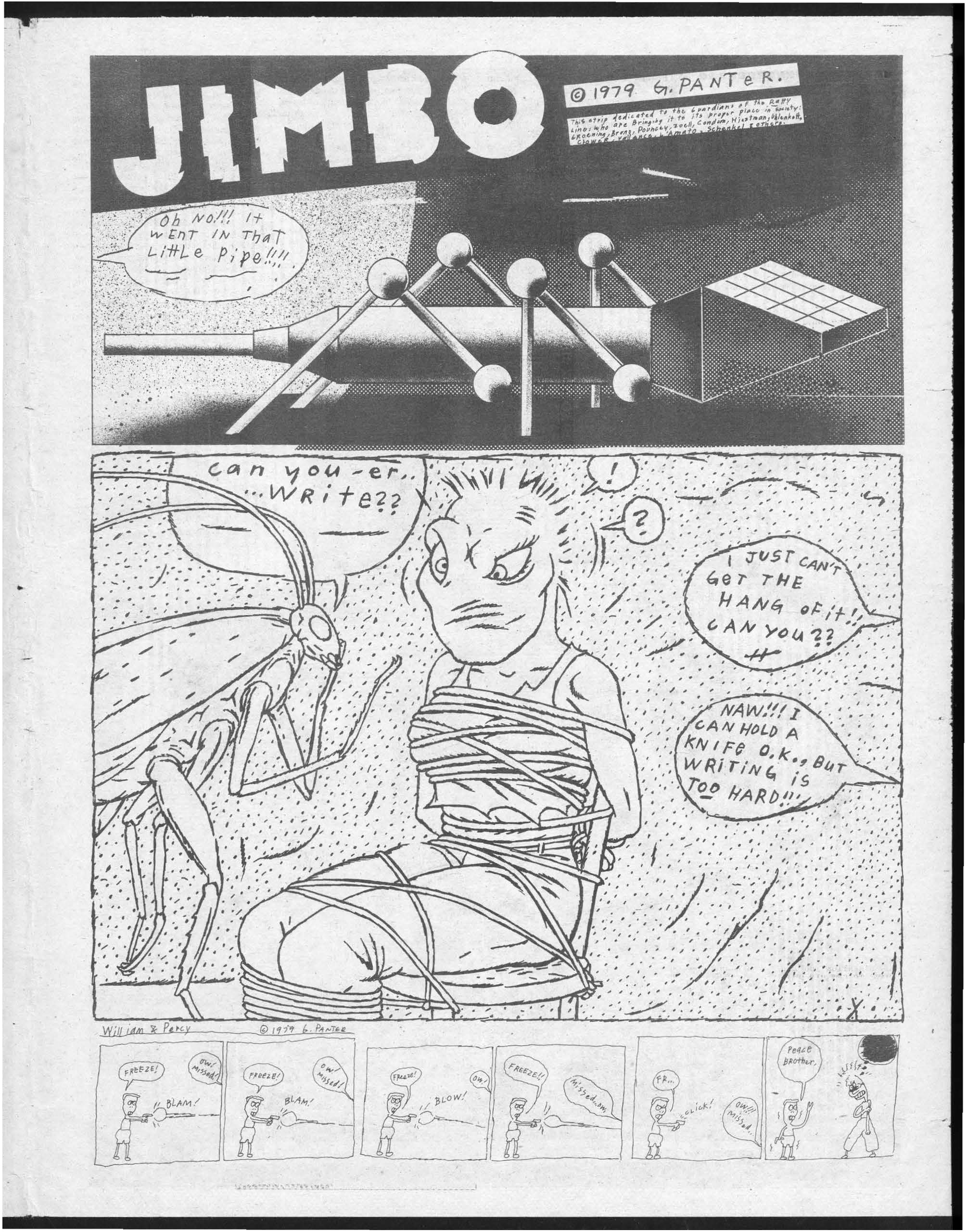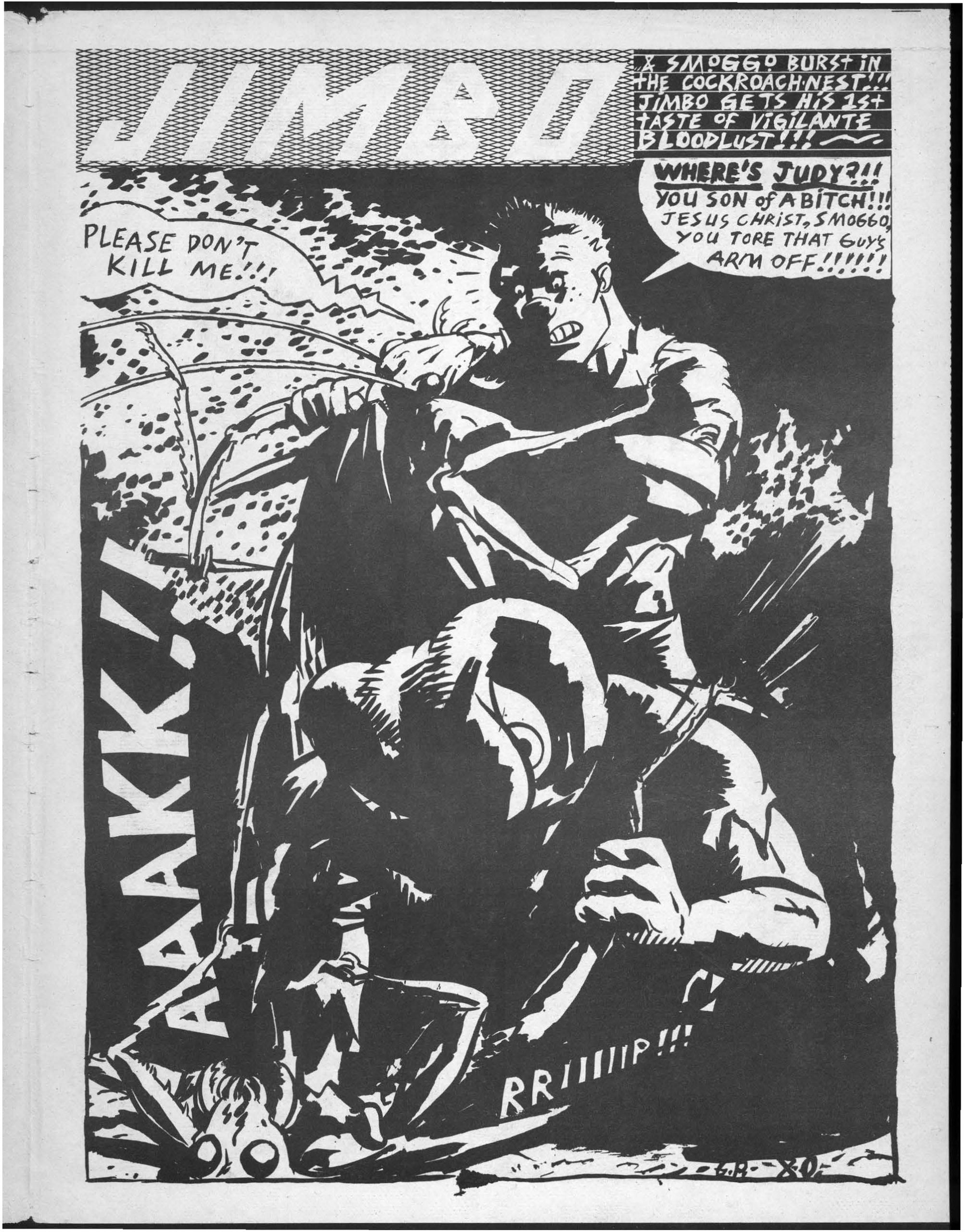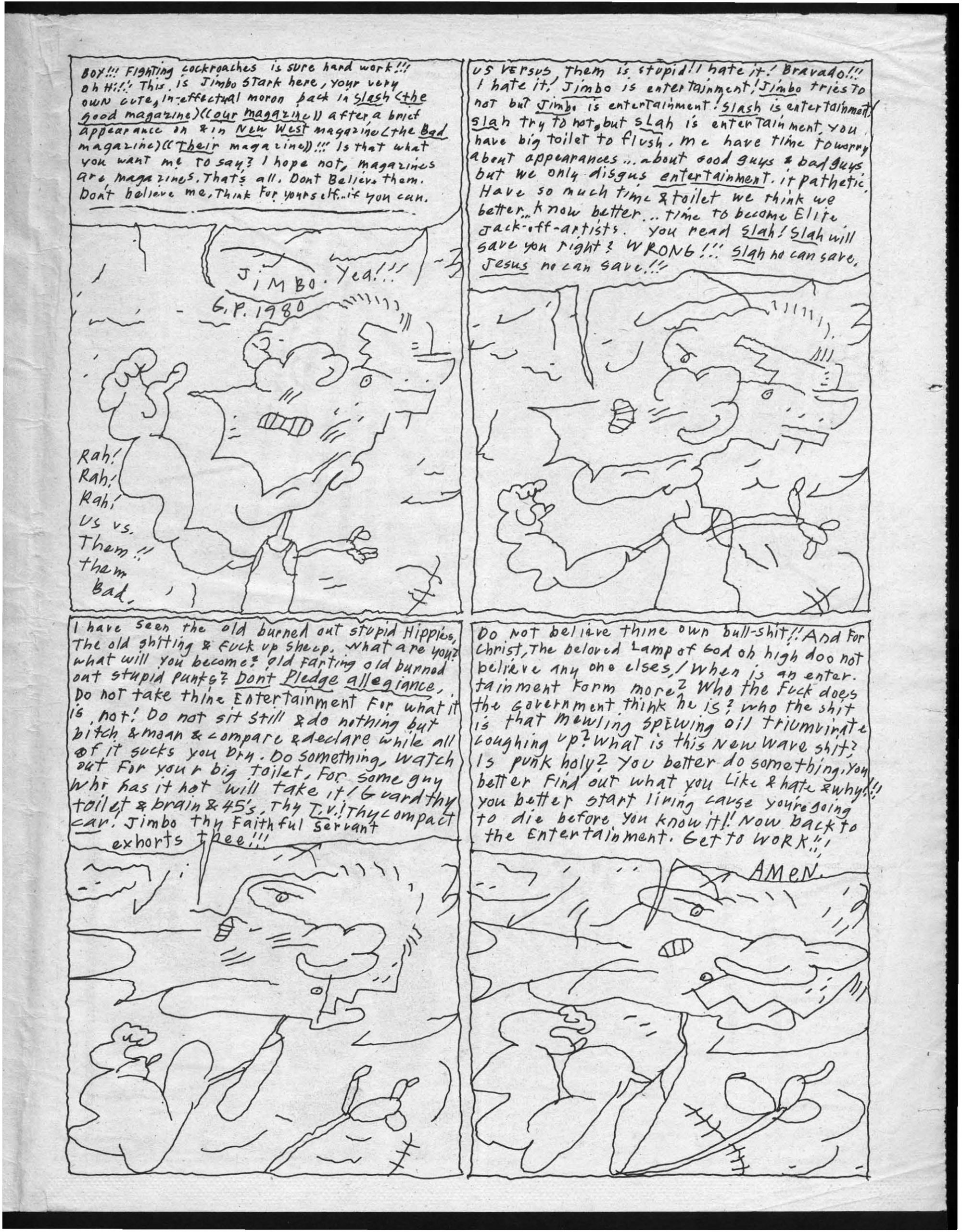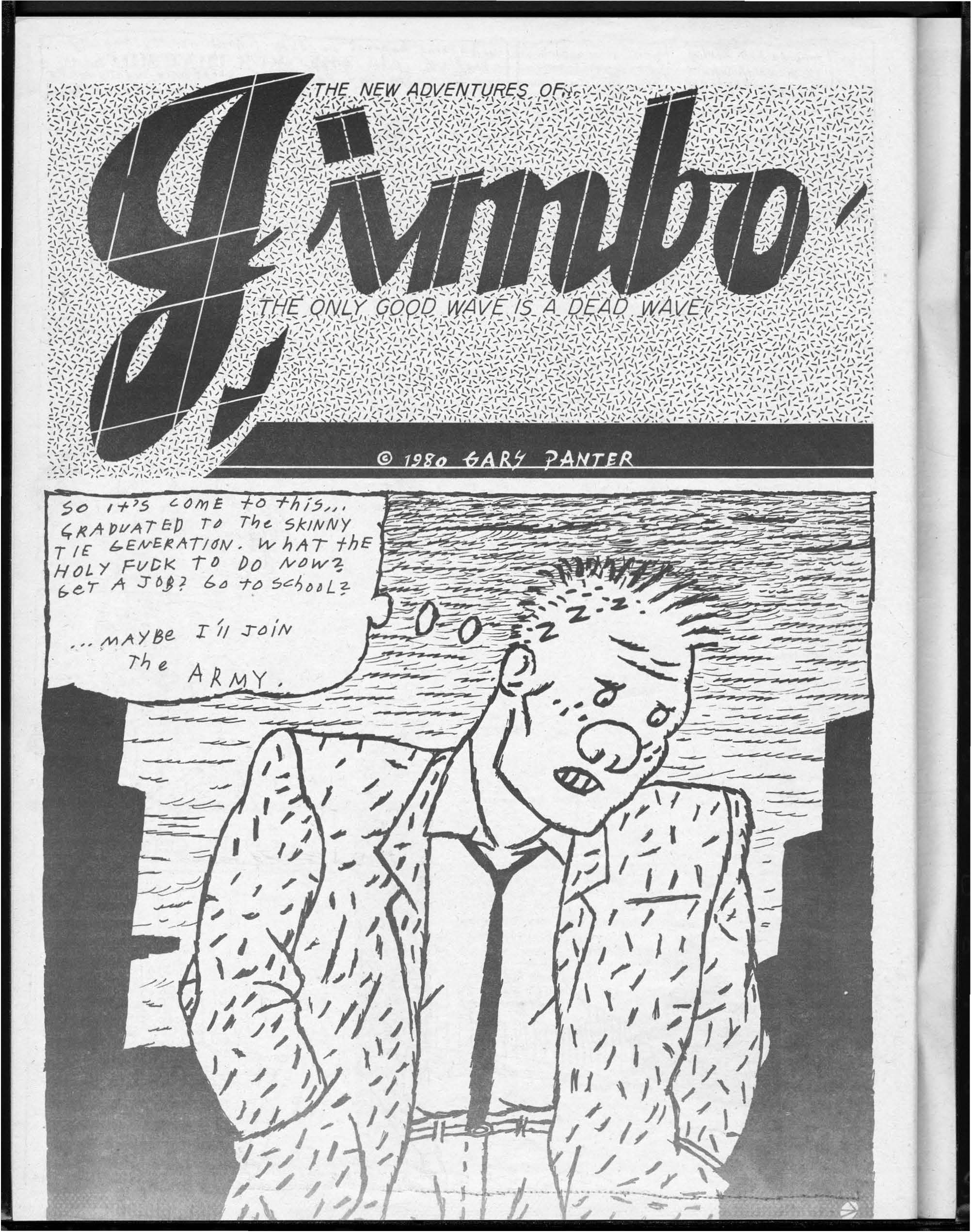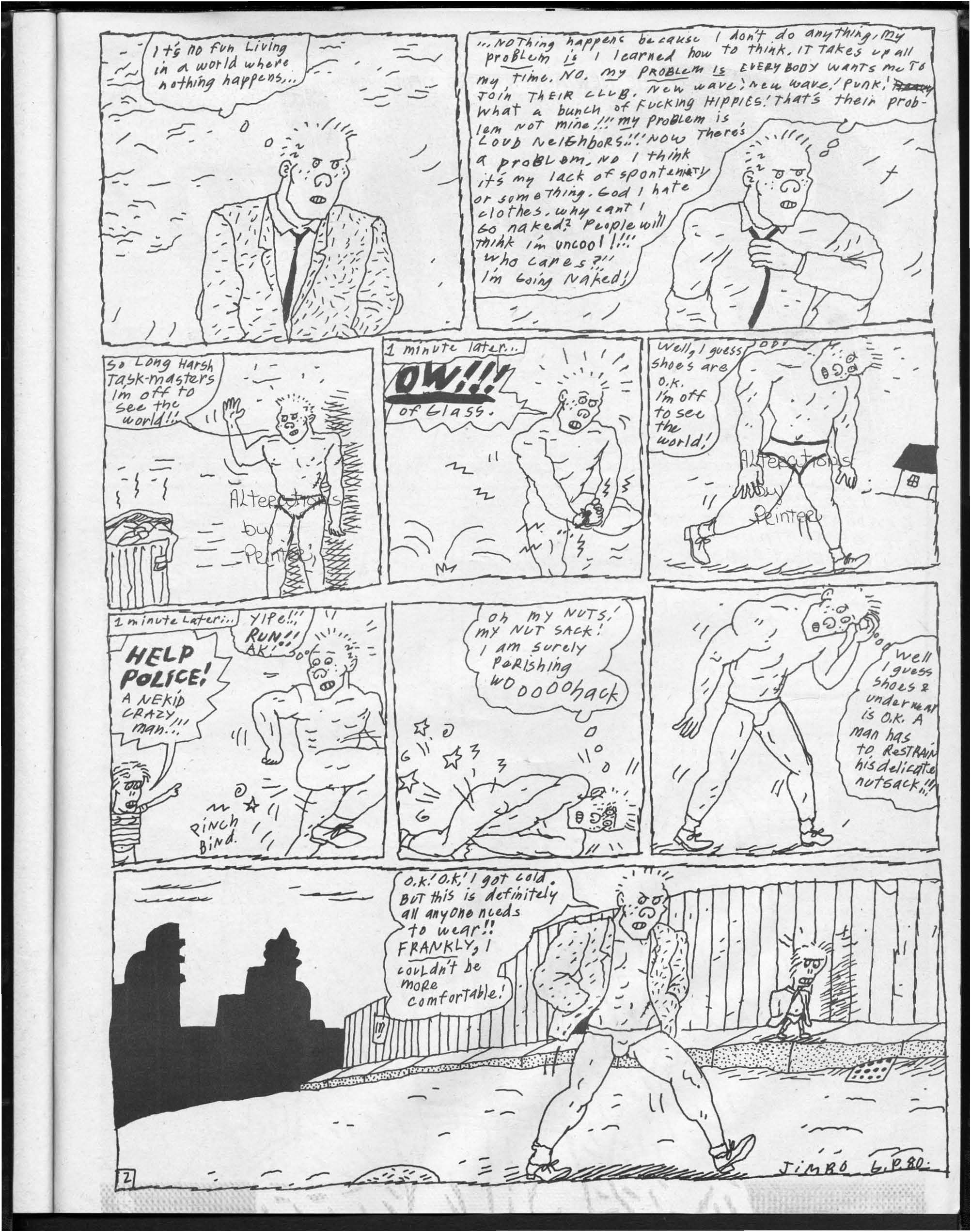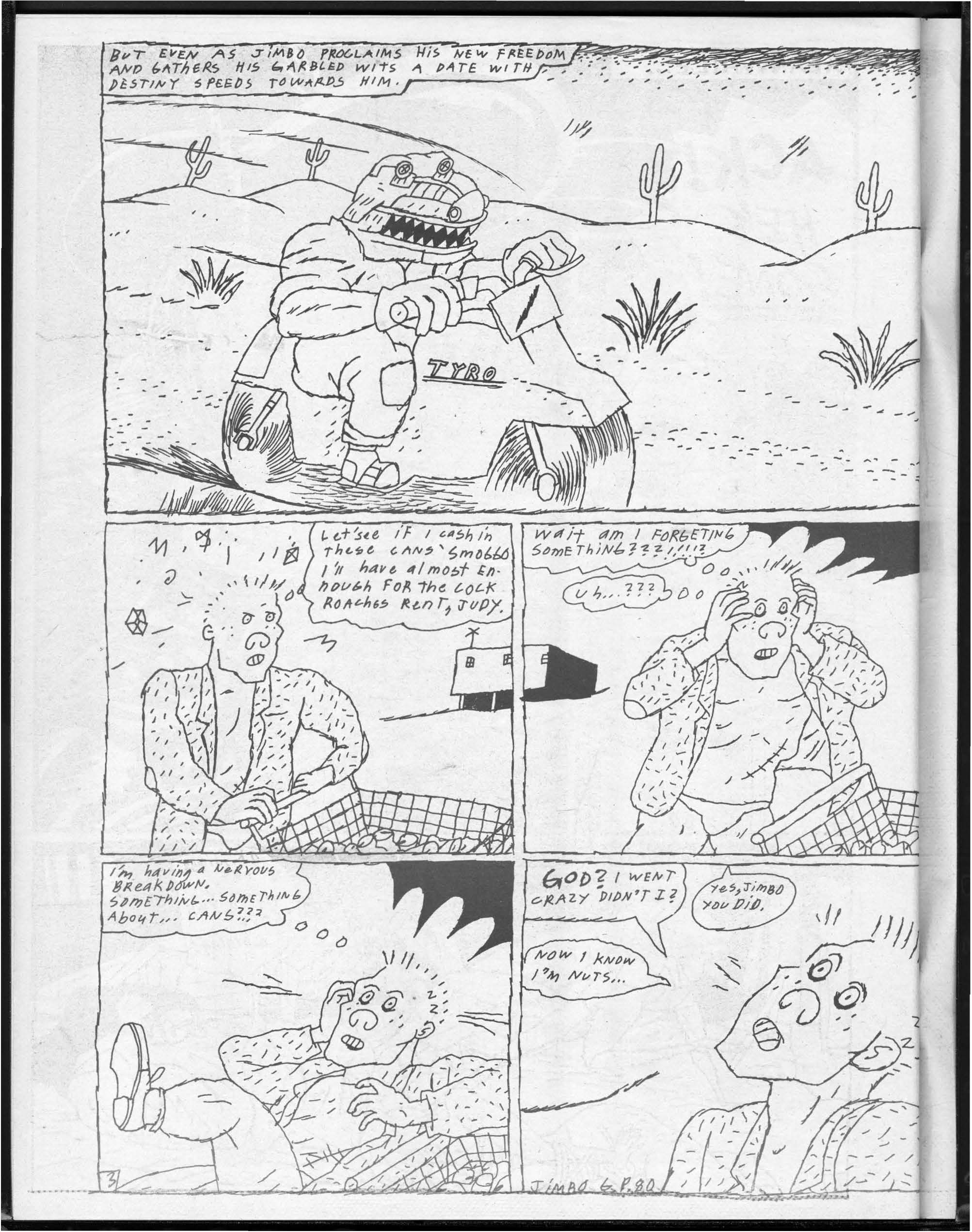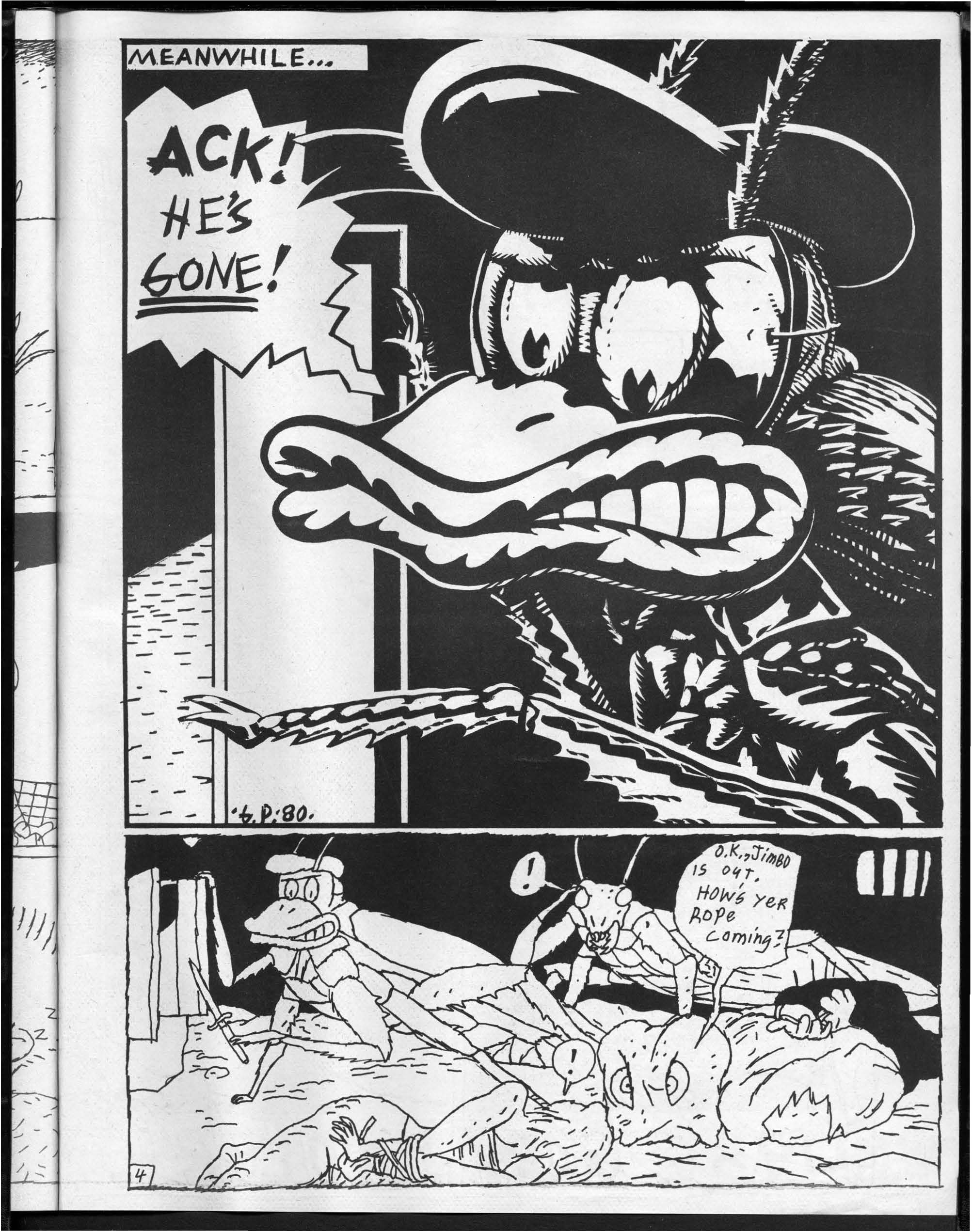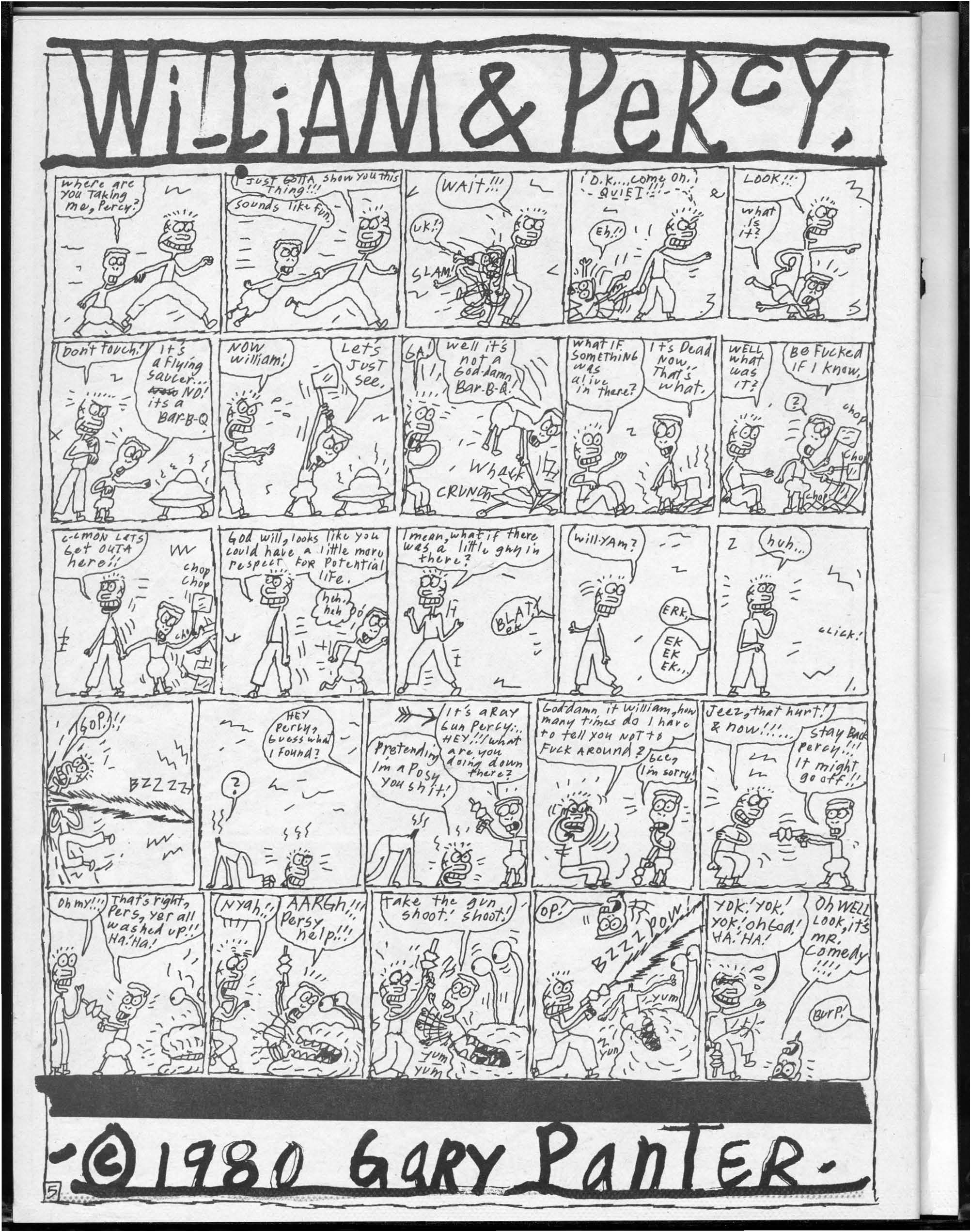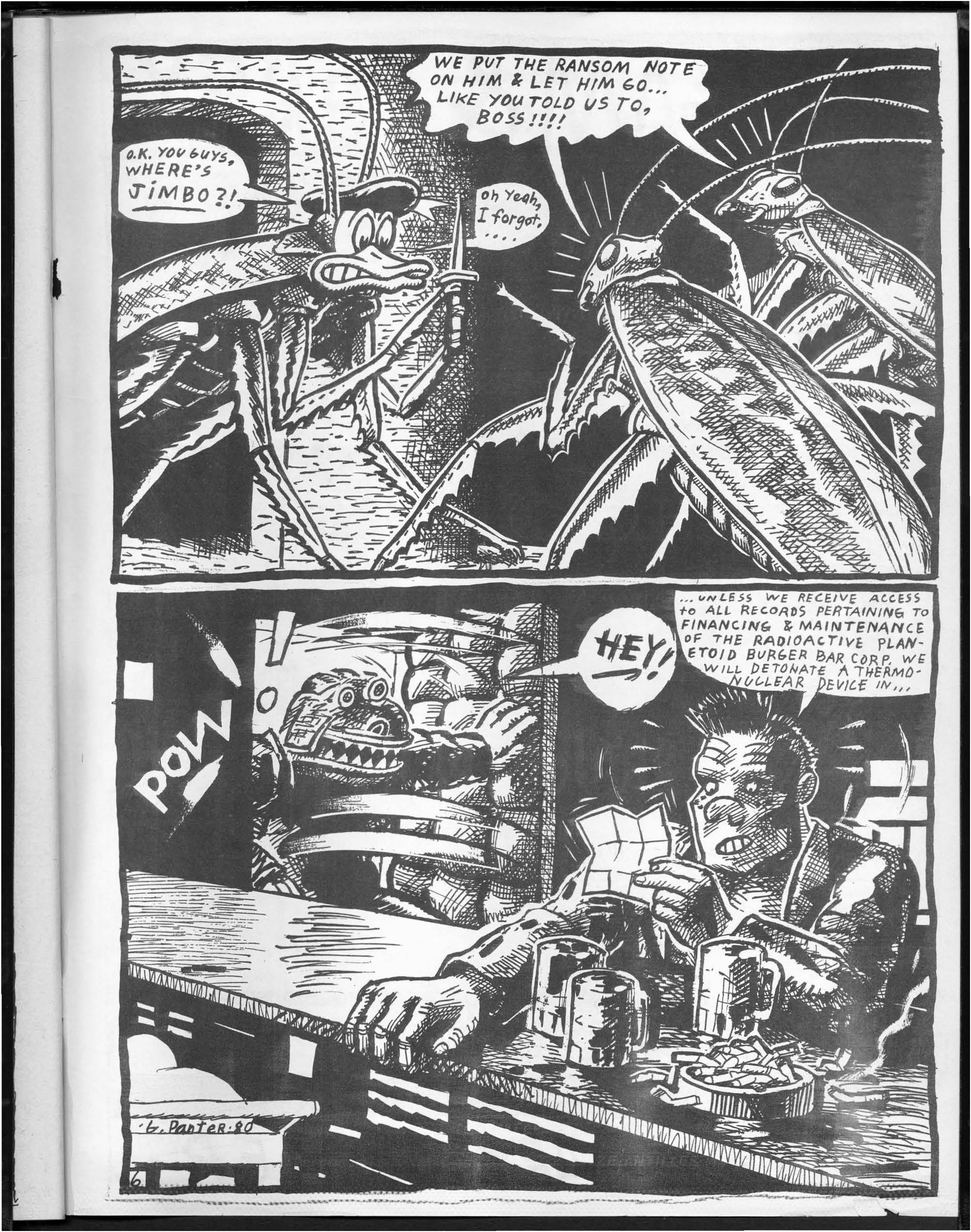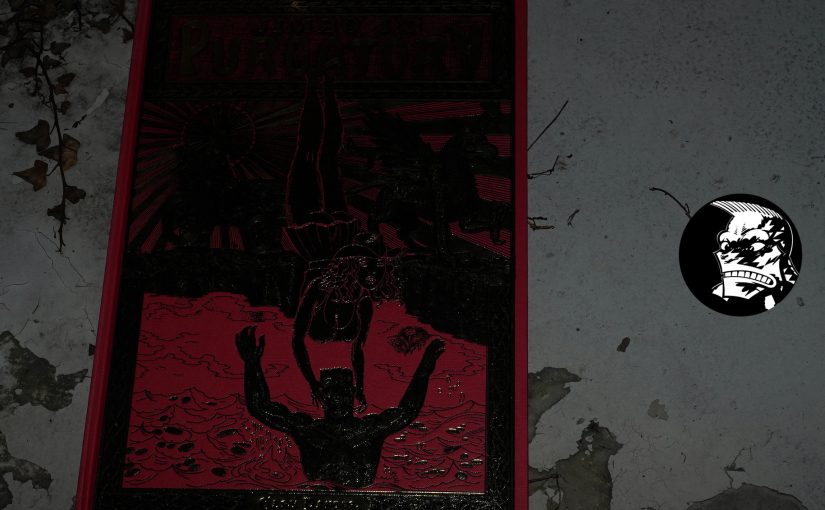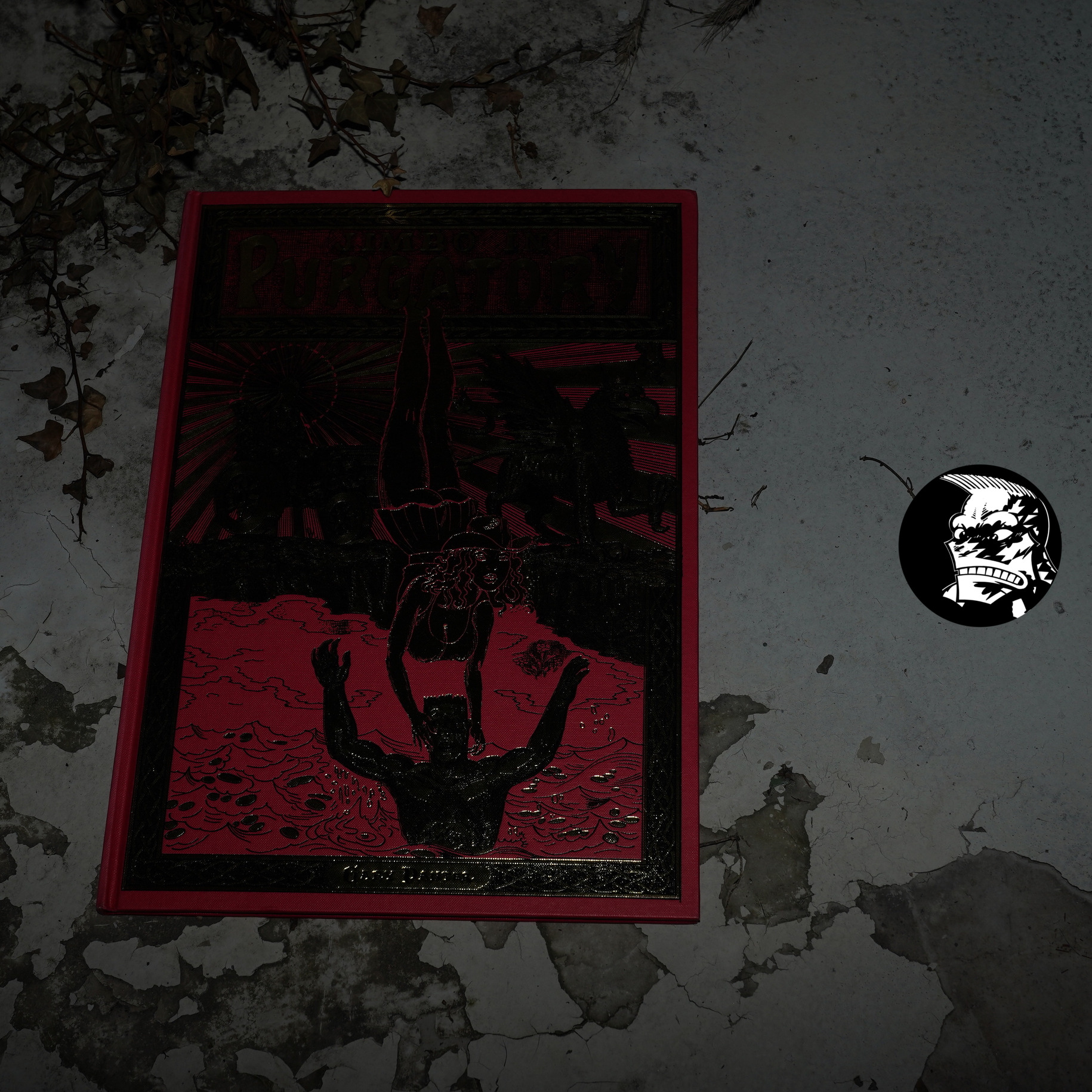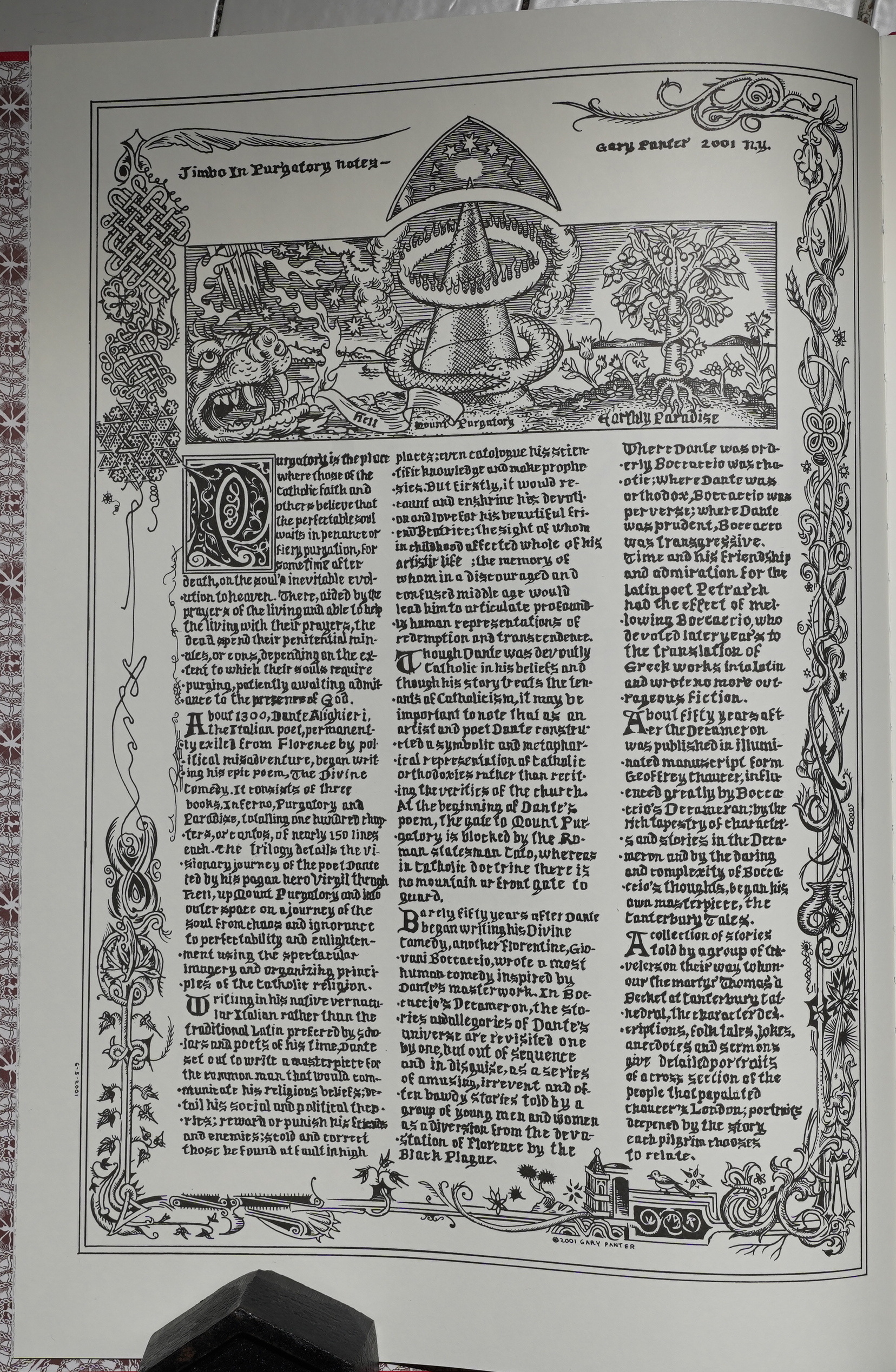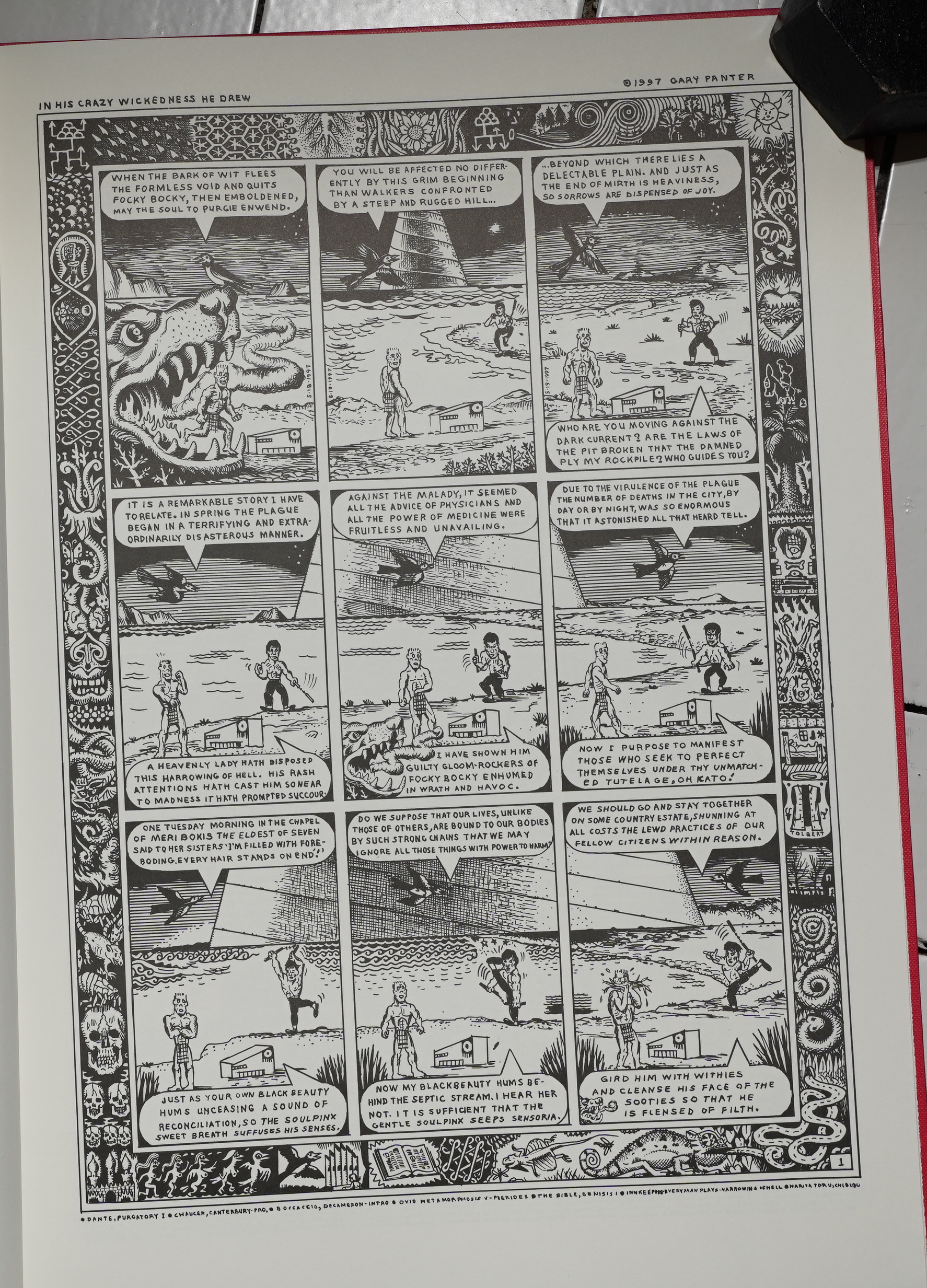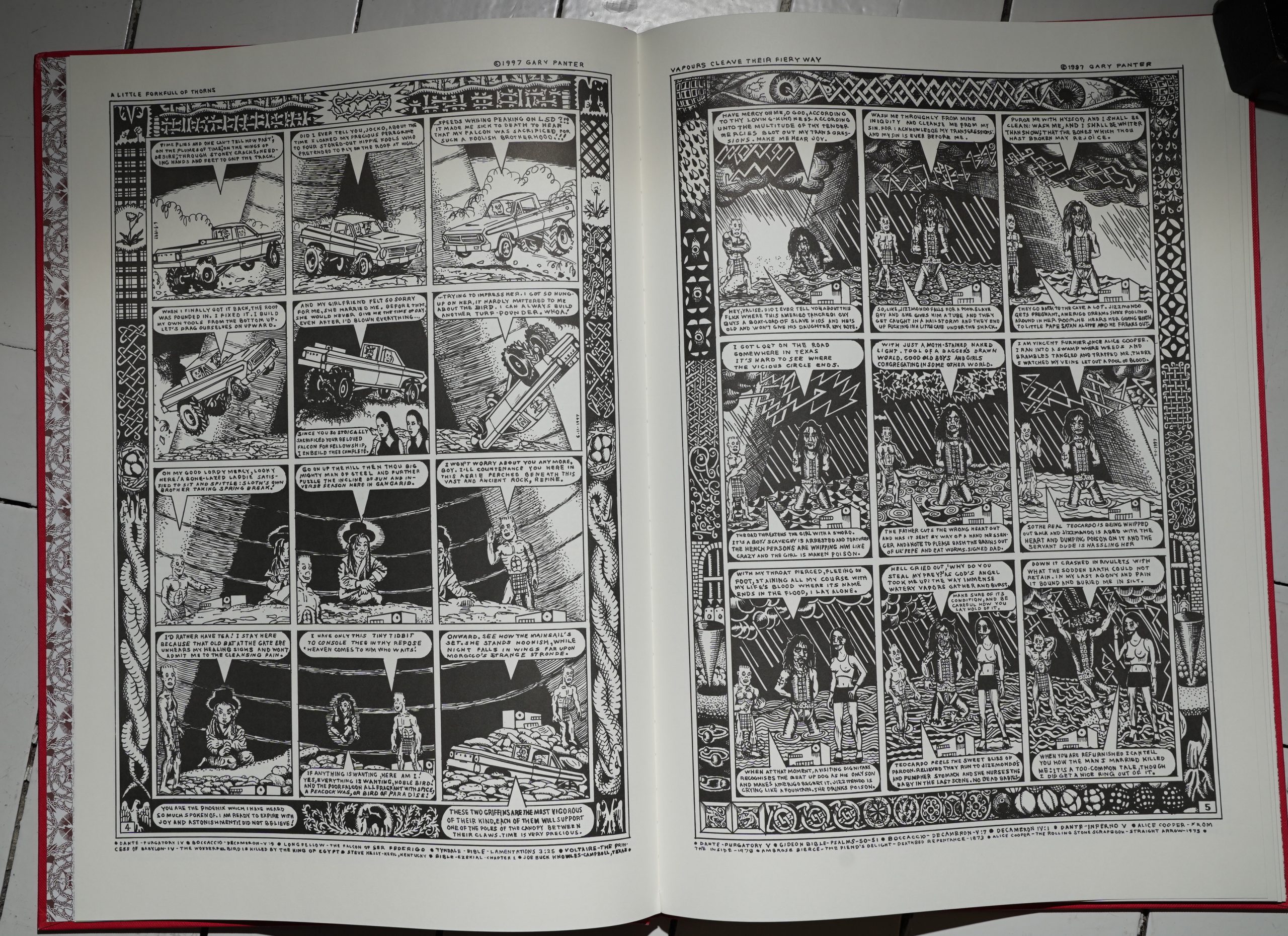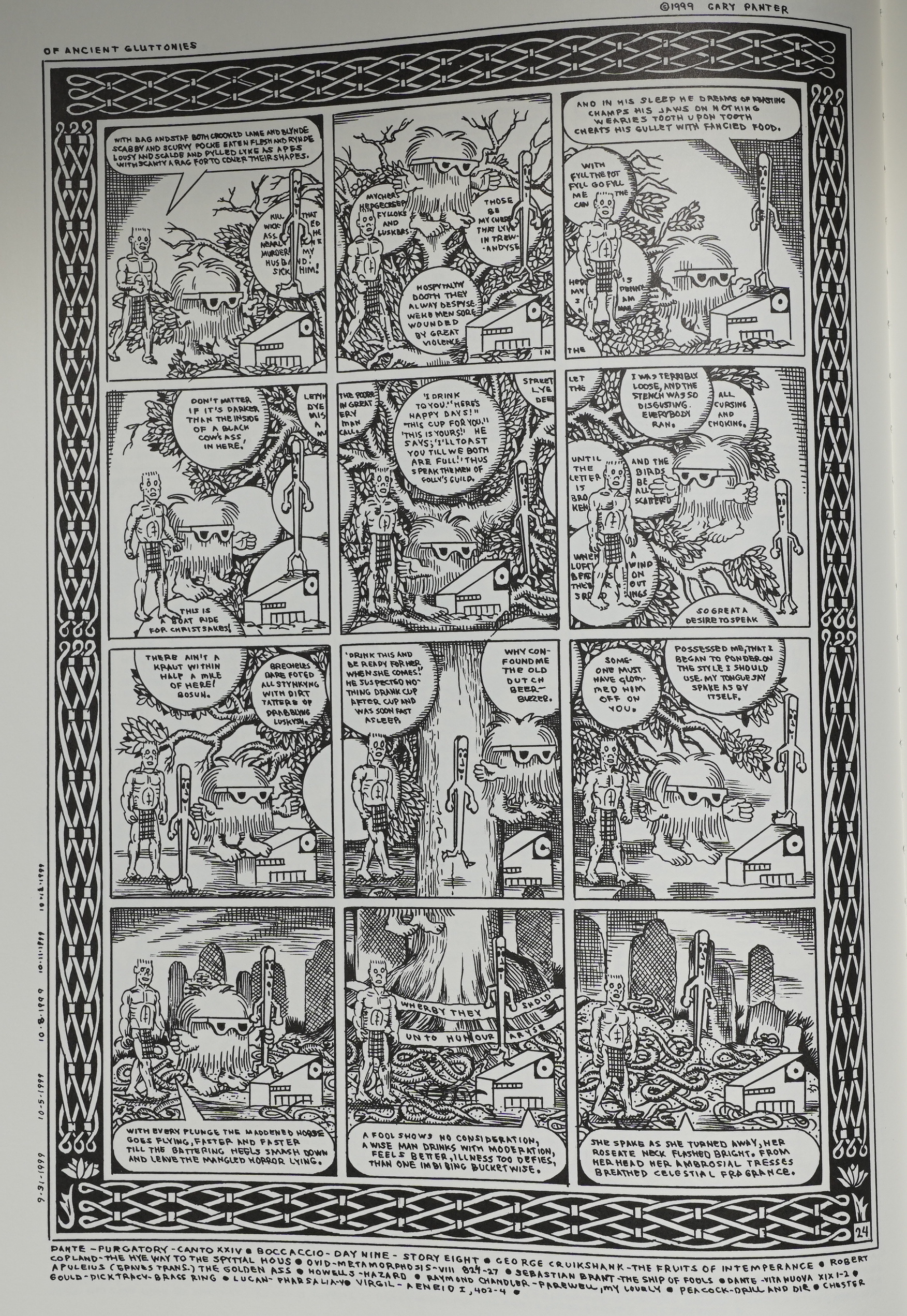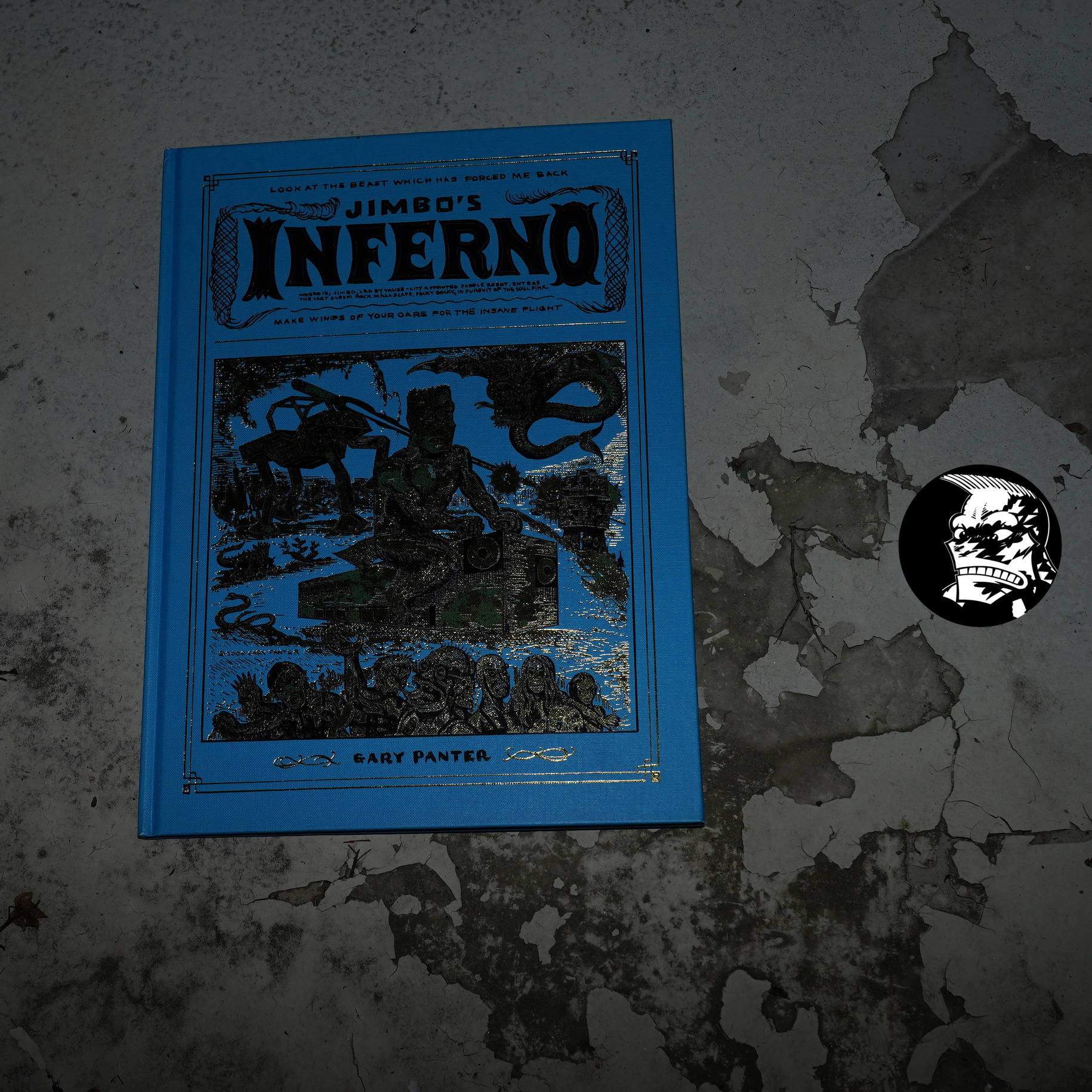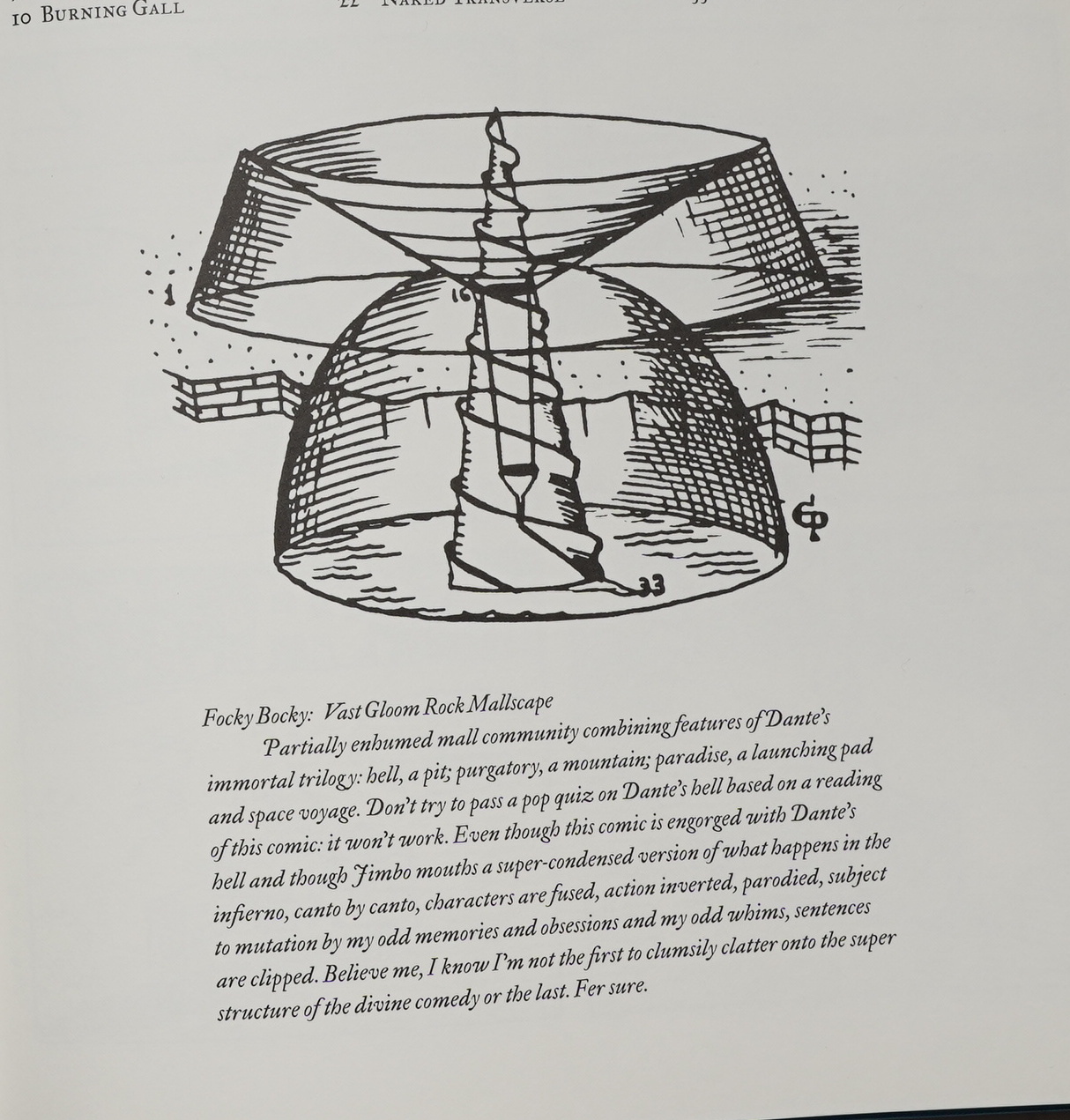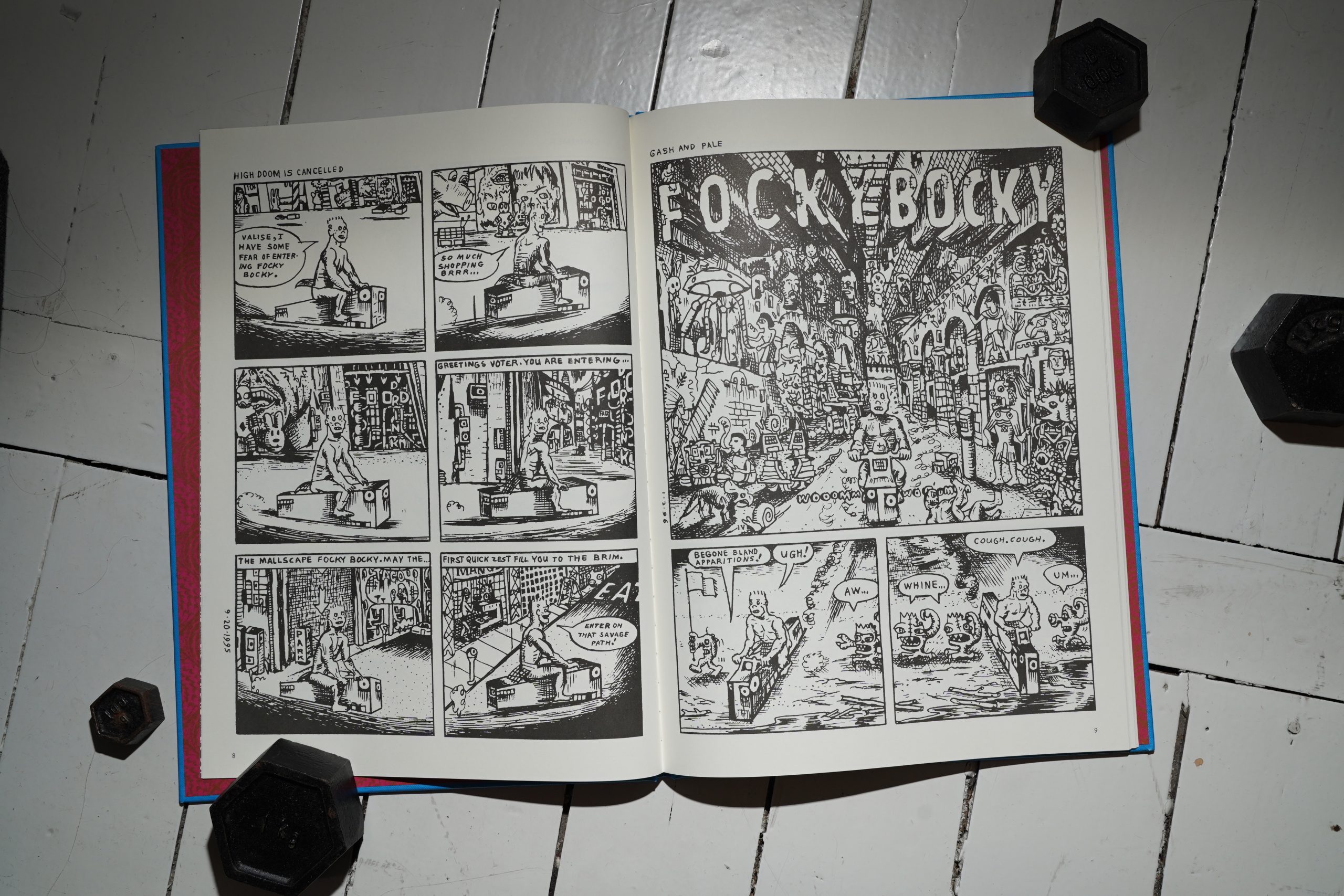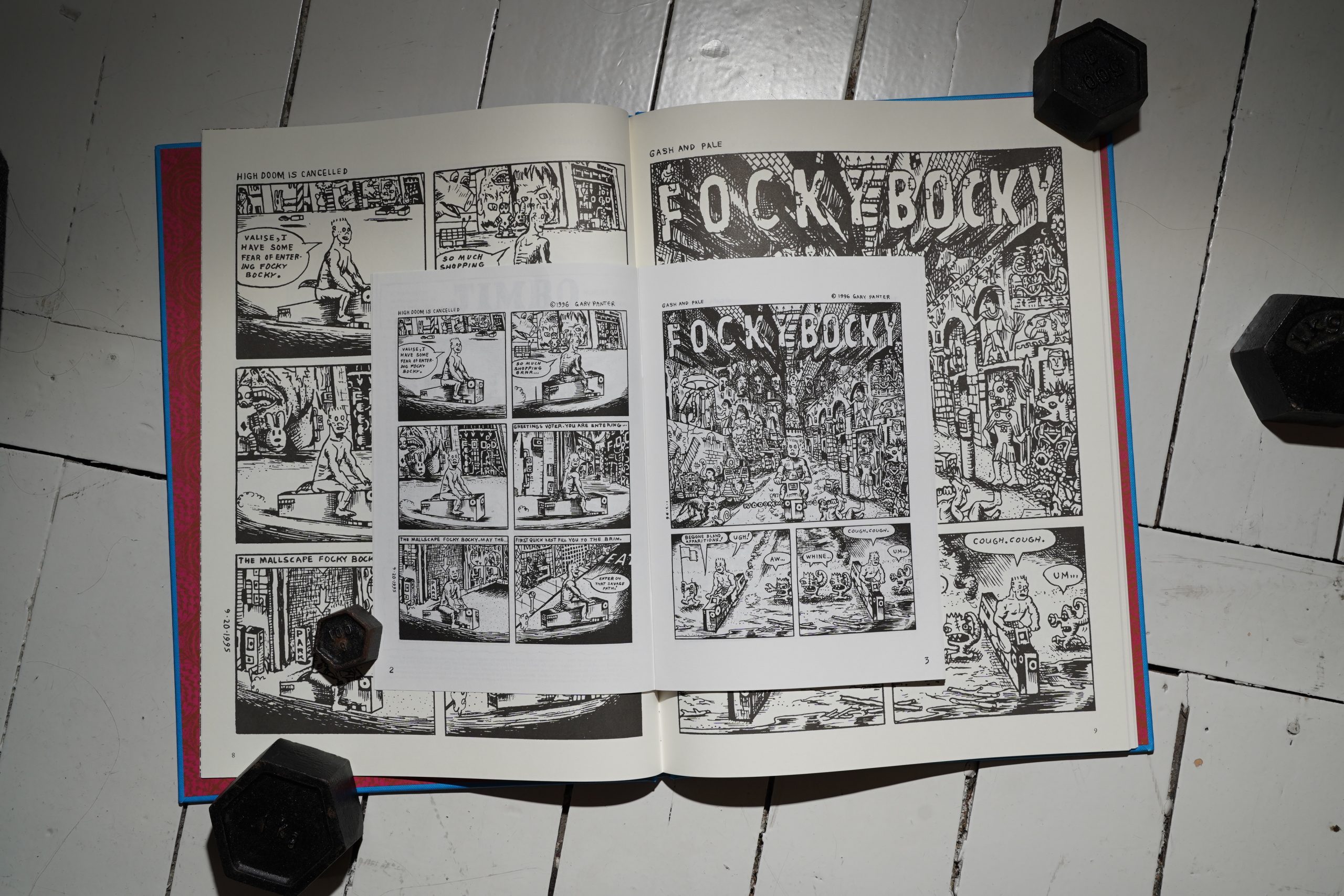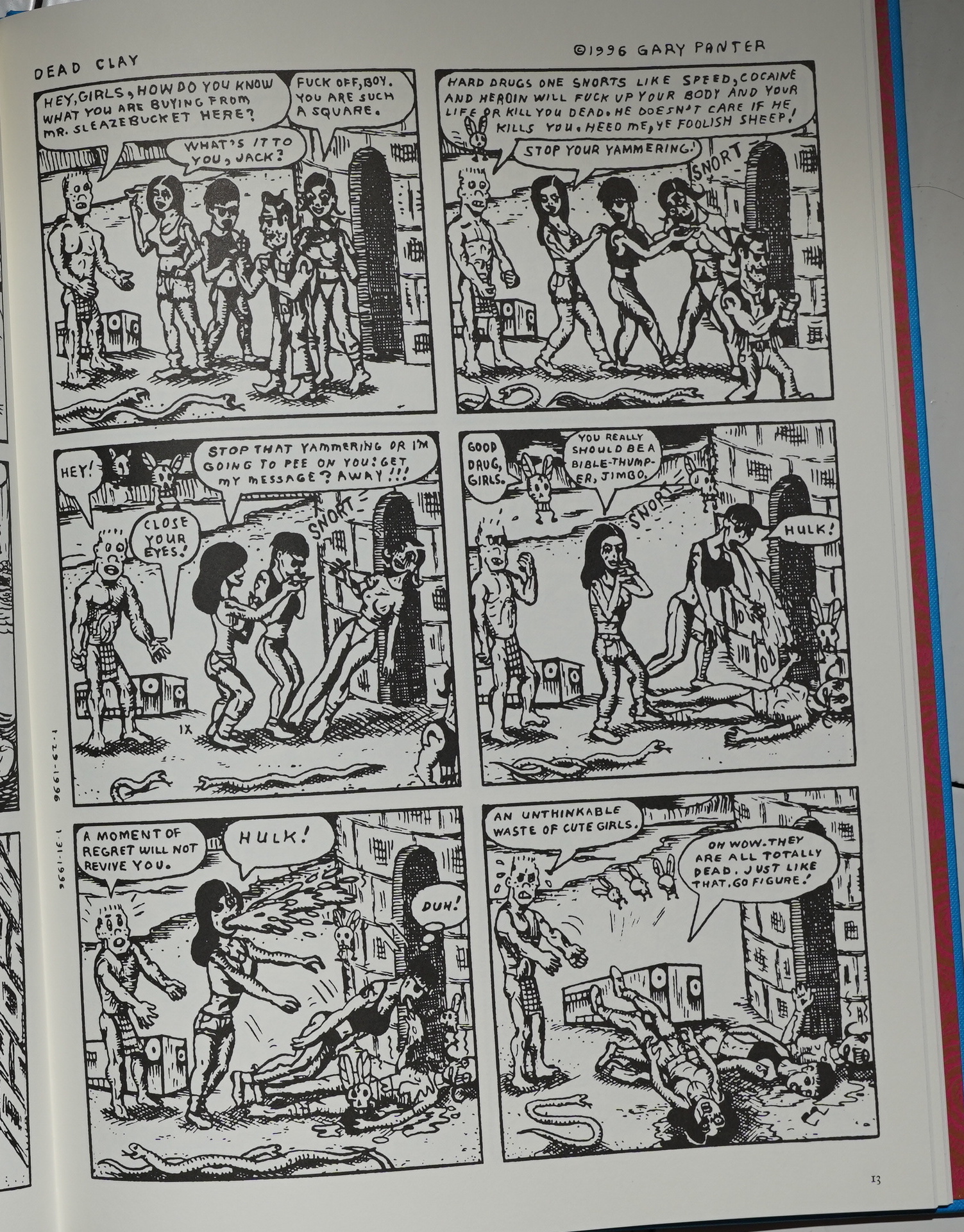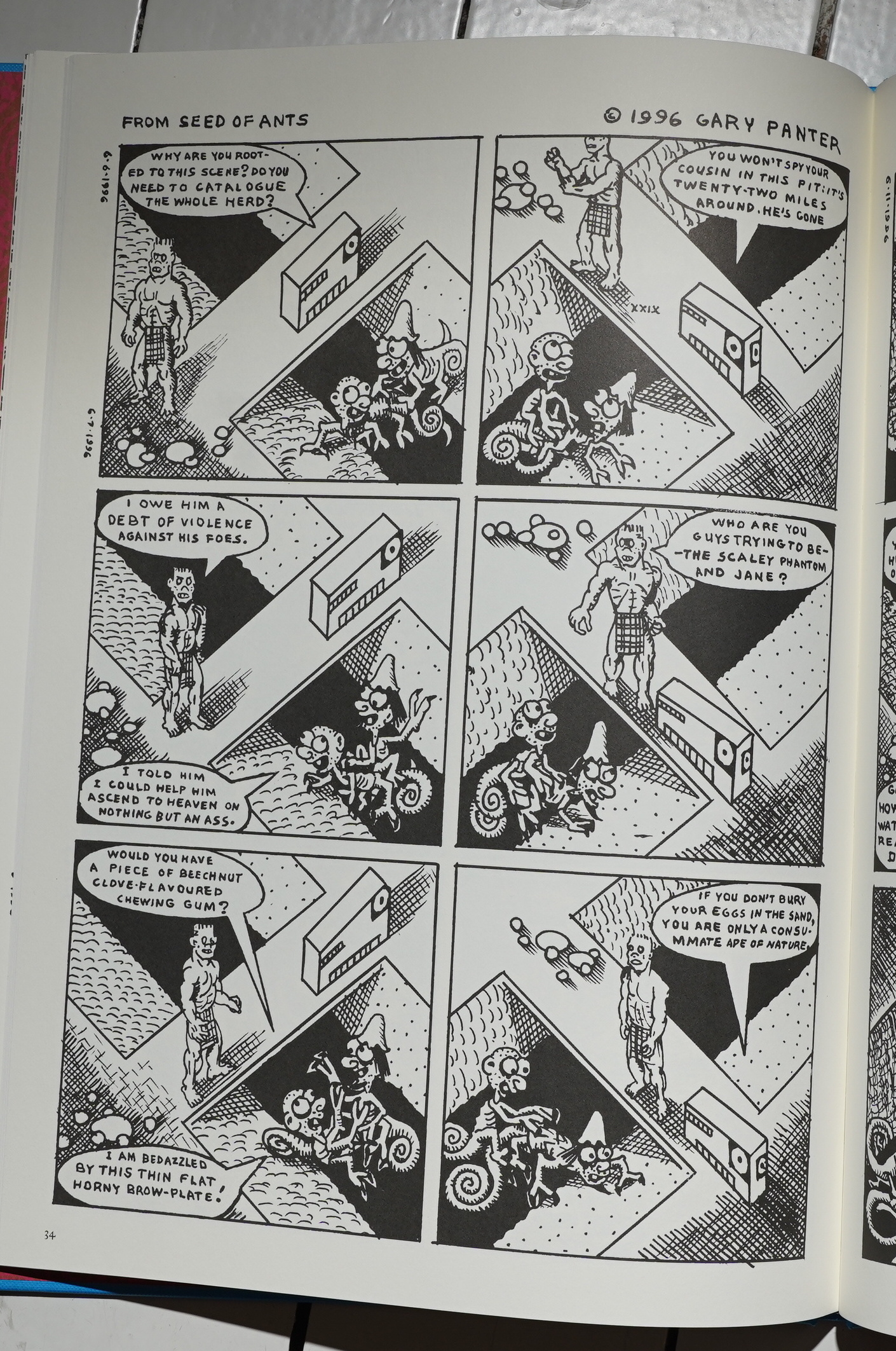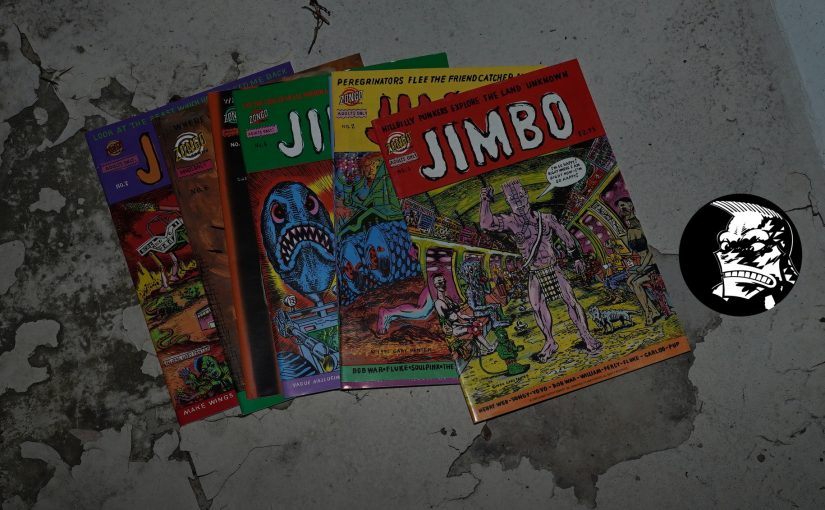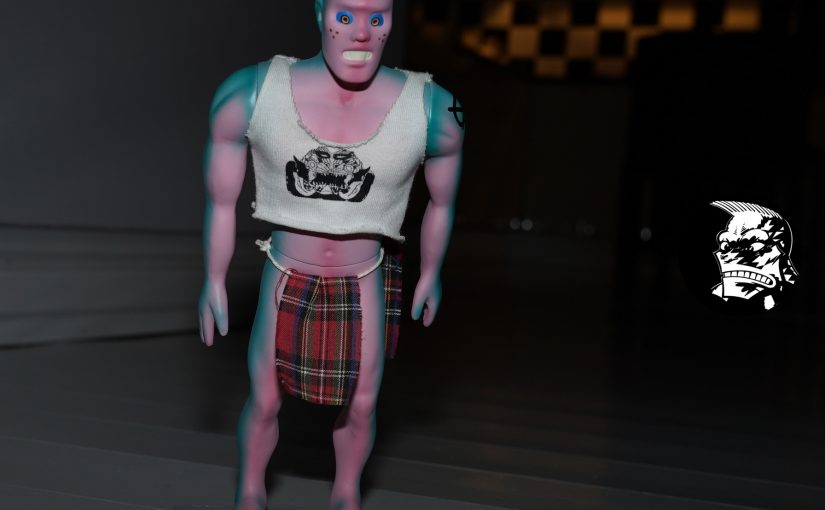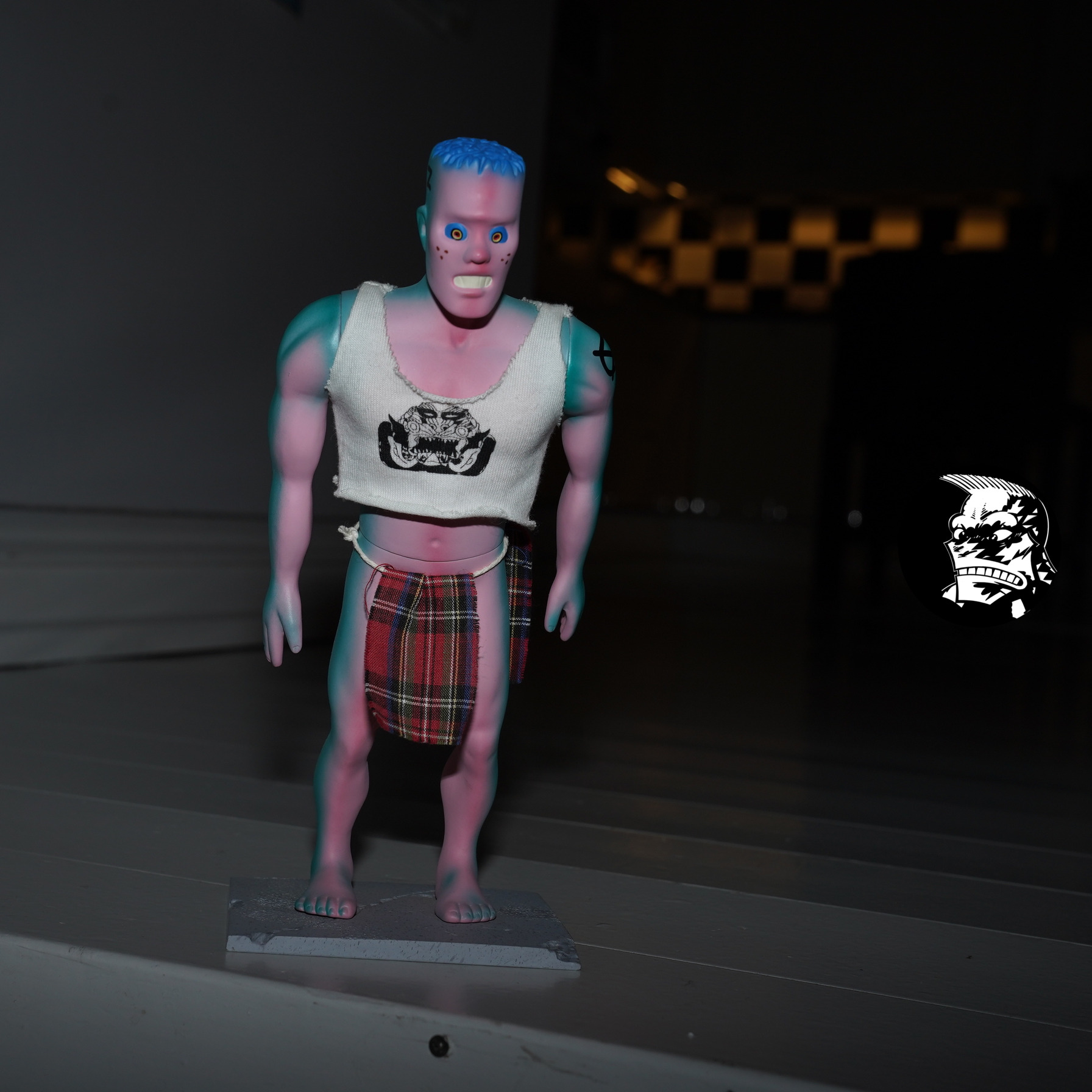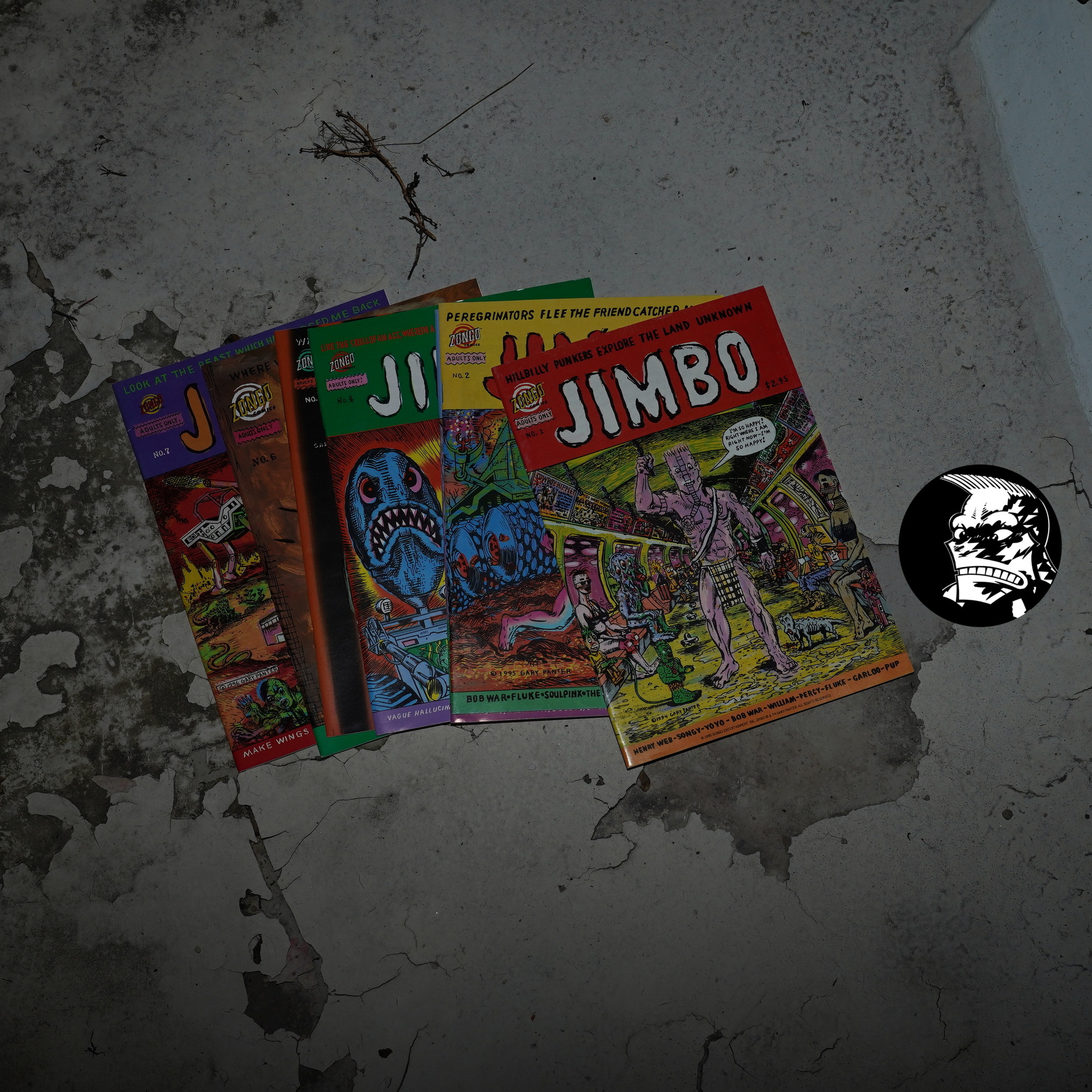
Jimbo by Gary Panter (168x242mm)
A Simpsons comics publishing entity had been established a few years earlier (Bongo Comics), and Matt Groening apparently thought that was a good setup for publishing some of his friends, so the Zongo imprint was established.
(It’s probably a good idea to keep these comics somewhat separate from the Simpsons ones.)
Only two series were published by the imprint — Mary Fleener’s Fleener, and this one.
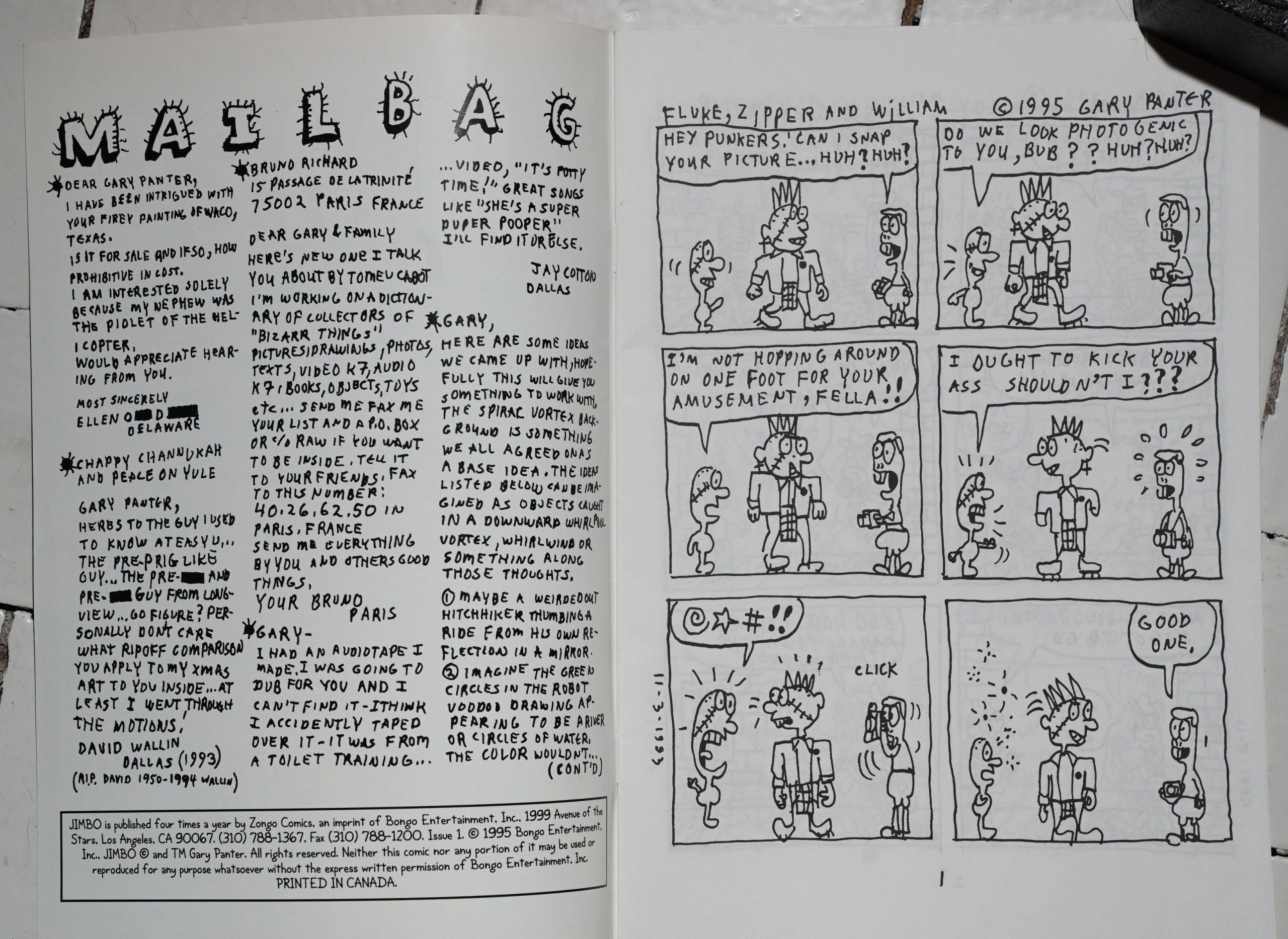
We don’t really get much of an introduction here — about what this book is supposed to be, or how it came to be. But the dates on these strips says that they were done in 1993, and they are the roughest Jimbo pages ever.
We’re allowed to guess, right? I’m guessing these were pages Panter doodled in between doing “serious” things.

It’s not just how the artwork looks, but also how there doesn’t seem to be much narrative consistency in the first issue (i.e., the first 32 pages).
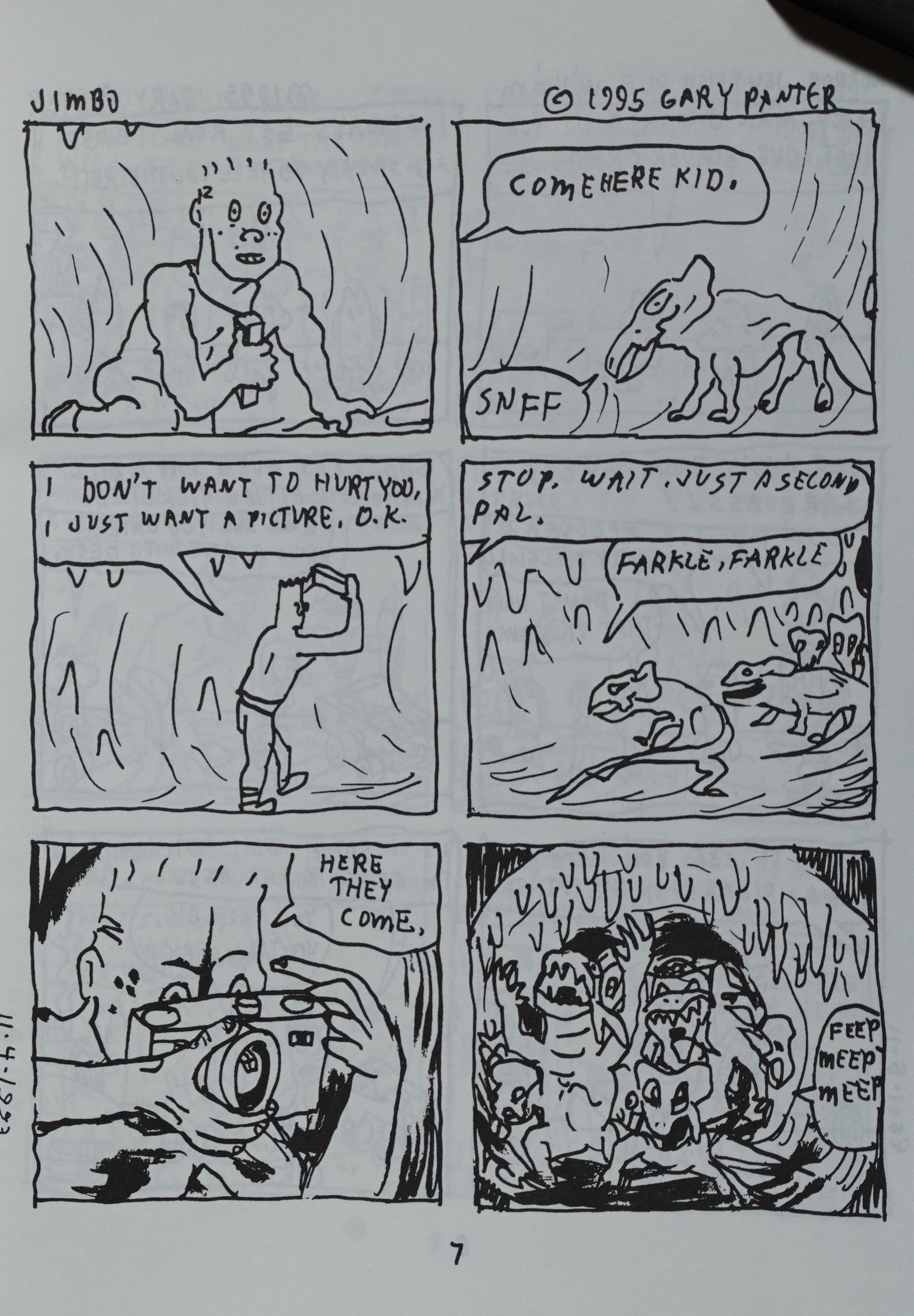
And then Jimbo pops in…
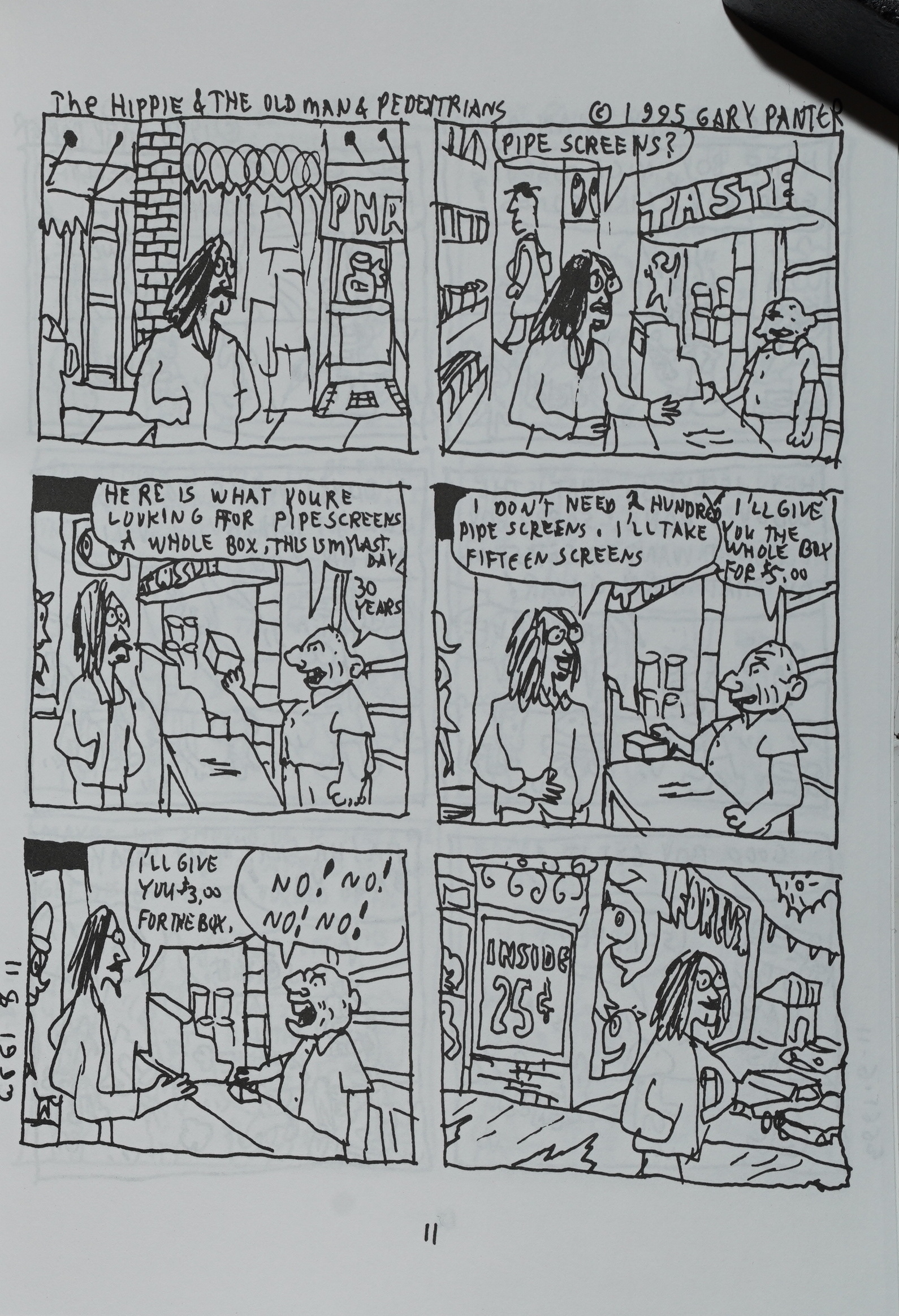
… and a random page about a hippie trying to buy pipe screens.

Which is something you put into a pipe?
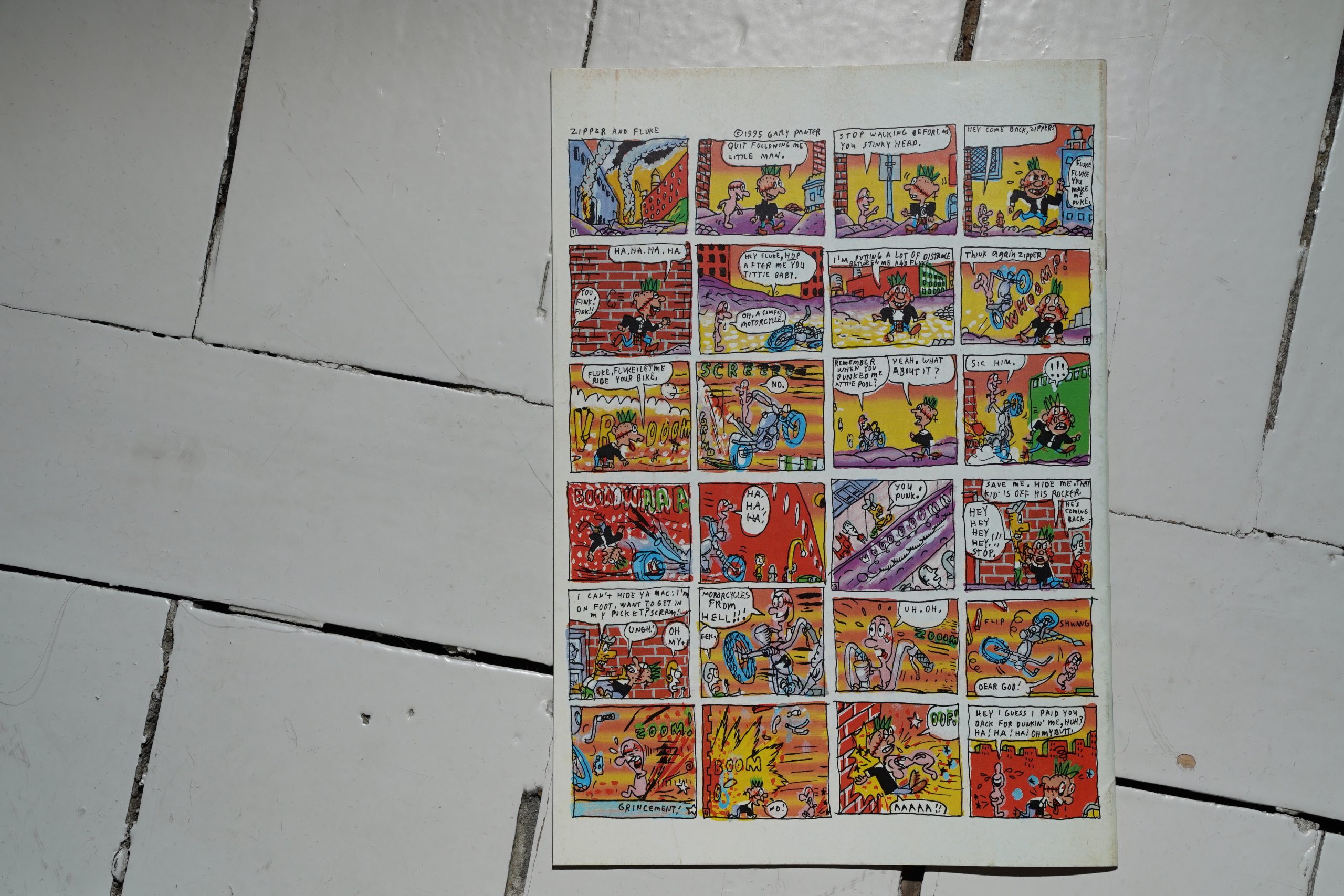
I mean, I don’t mean to sound so down on this thing — it’s amusing, but it’s disappointing if you were expecting something that had that sense of vitality and importance that the first Jimbo sequence had.
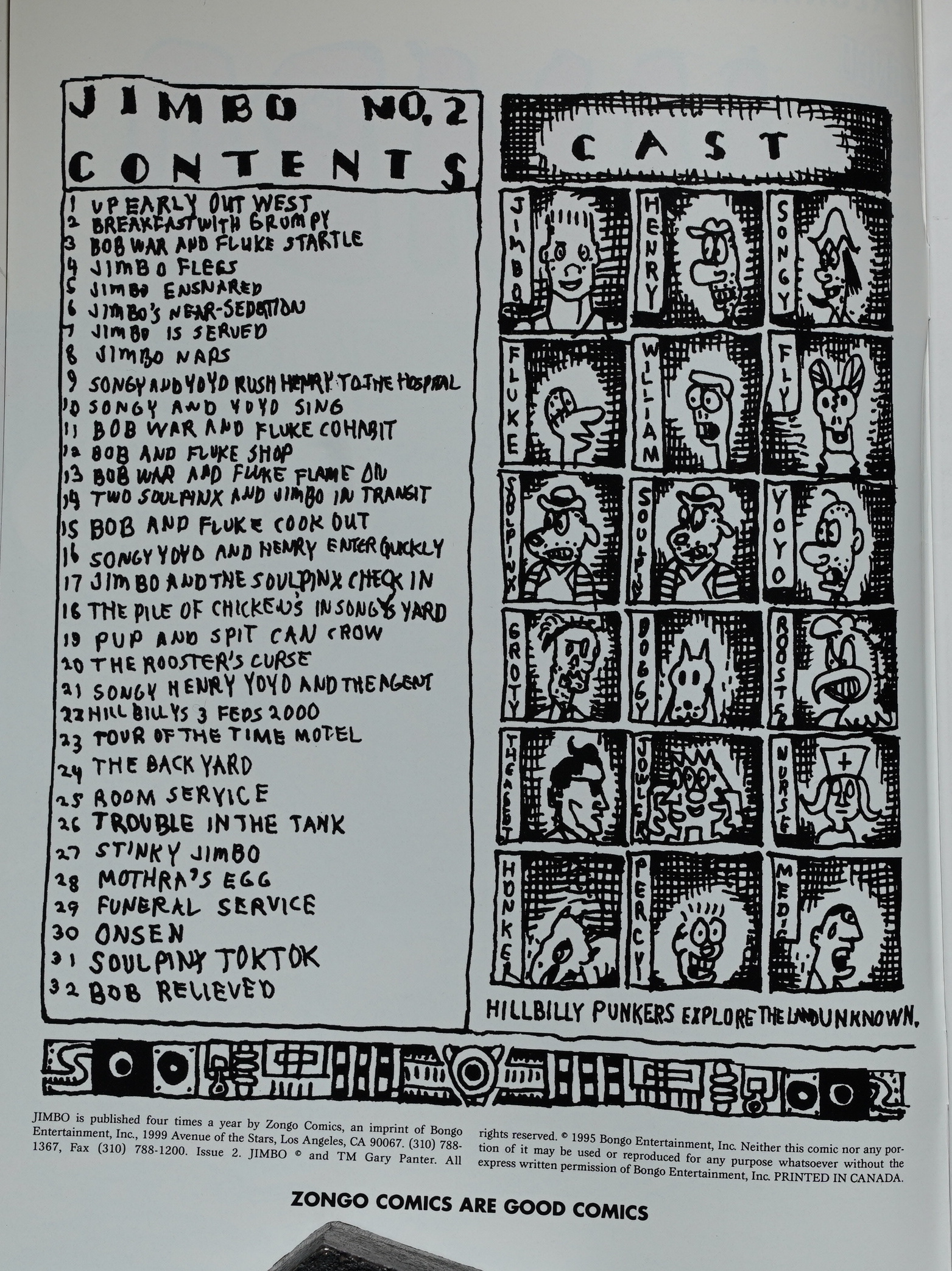
But then things change. By the second issue, it seems like Panter is starting to take what he’s doing more seriously.

The artwork becomes more interesting — not as obsessive as a decade ago; it’s got a pleasing dashed-off quality to it — but it seems more thought through. And the storylines start to cohere — we’re following three groups of people, and some of these storylines intersect.
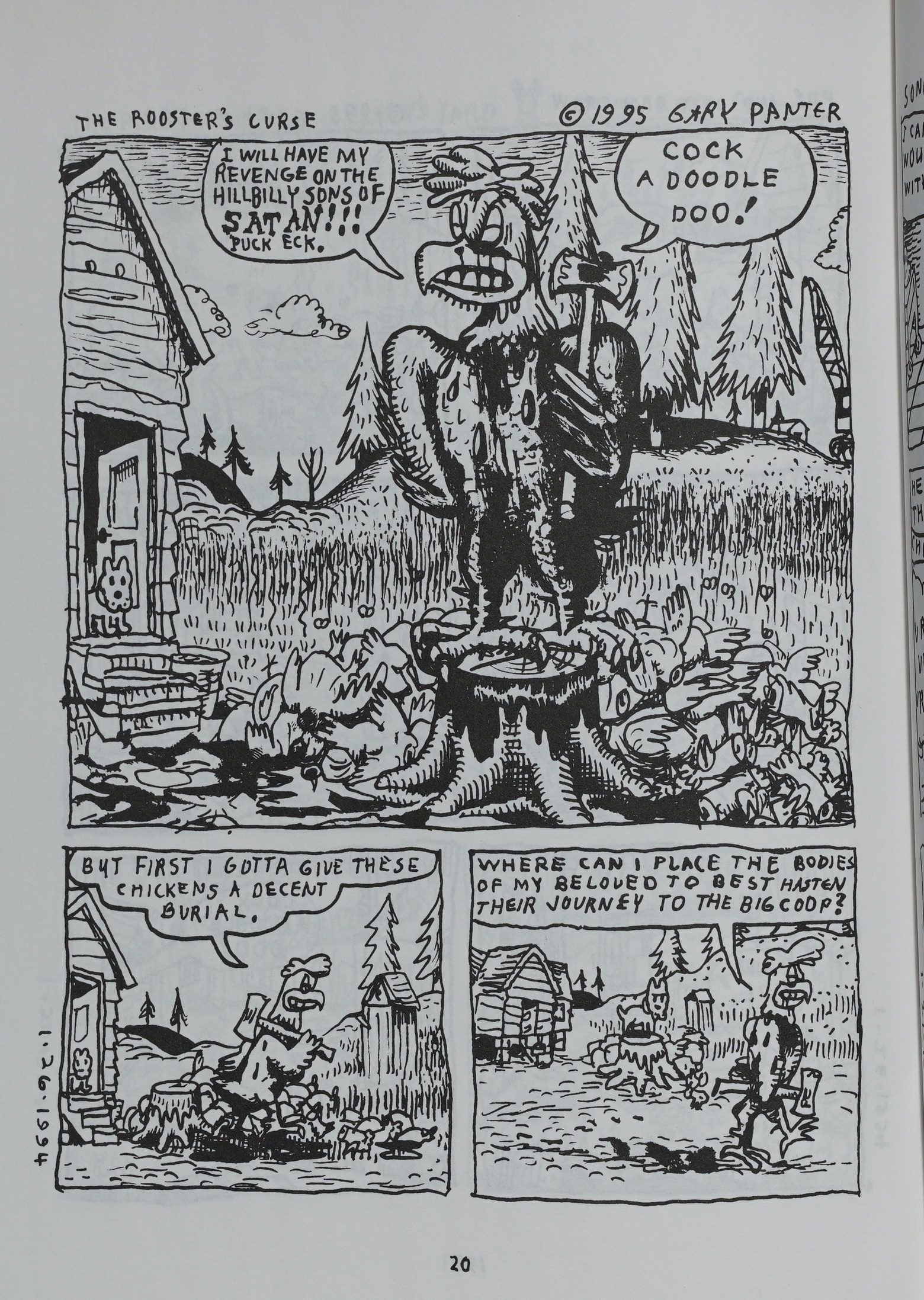
And then it’s just a really entertaining read from there on out — the plots are way loopy, but also seem to have some heft to them.
We’re still allowed to guess? OK, here’s my guess: Panter started this as a goof, but then got into it. And after he finished this 128 page epic, he showed it to Groening who then said “hey! let’s publish this!” (According to the dates on the strips, the story was finished before the first issue was published.)
I’m just guessing. Perhaps some googling will be informative…
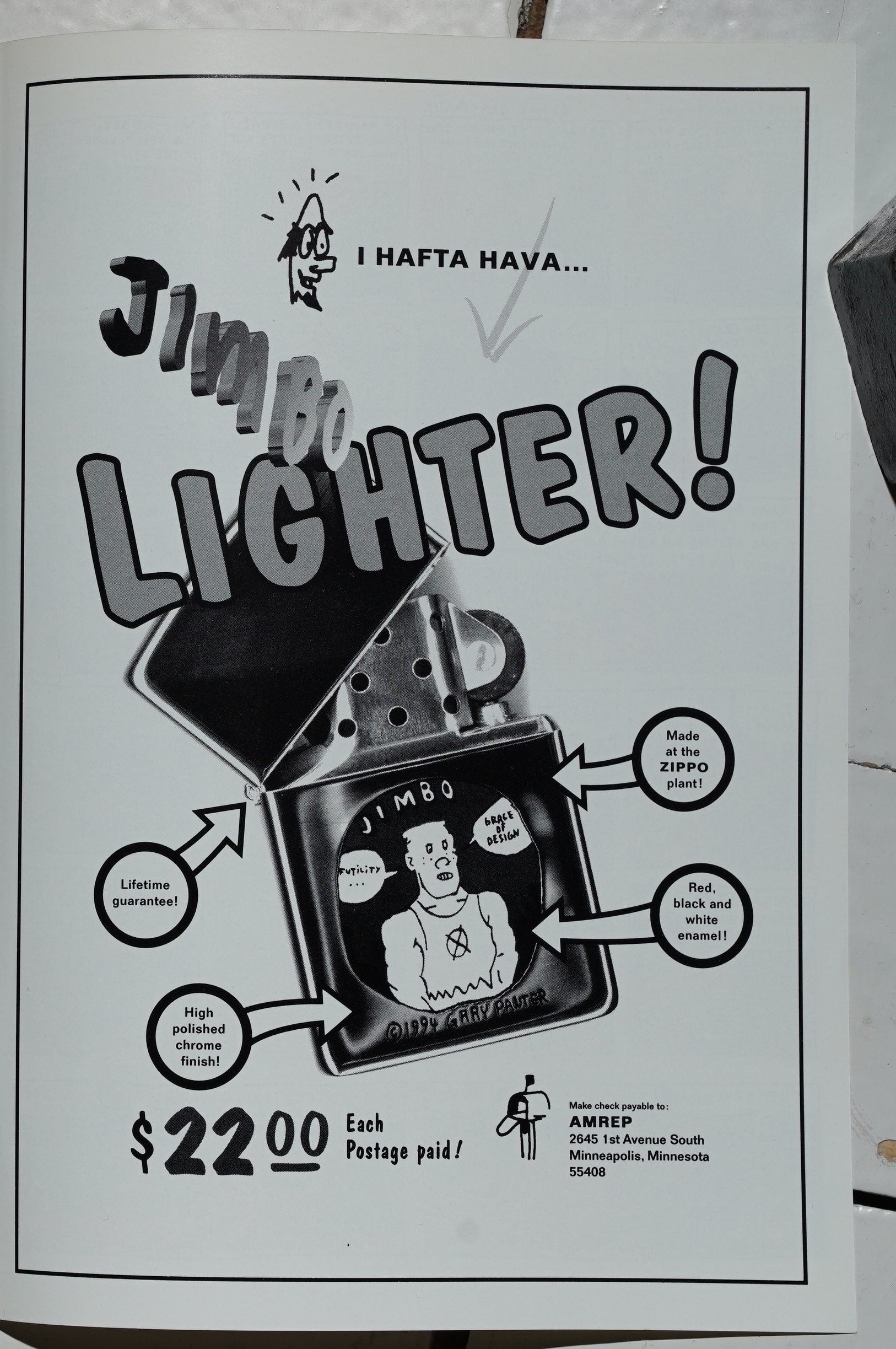
If only I smoked, then I would have bought that lighter.
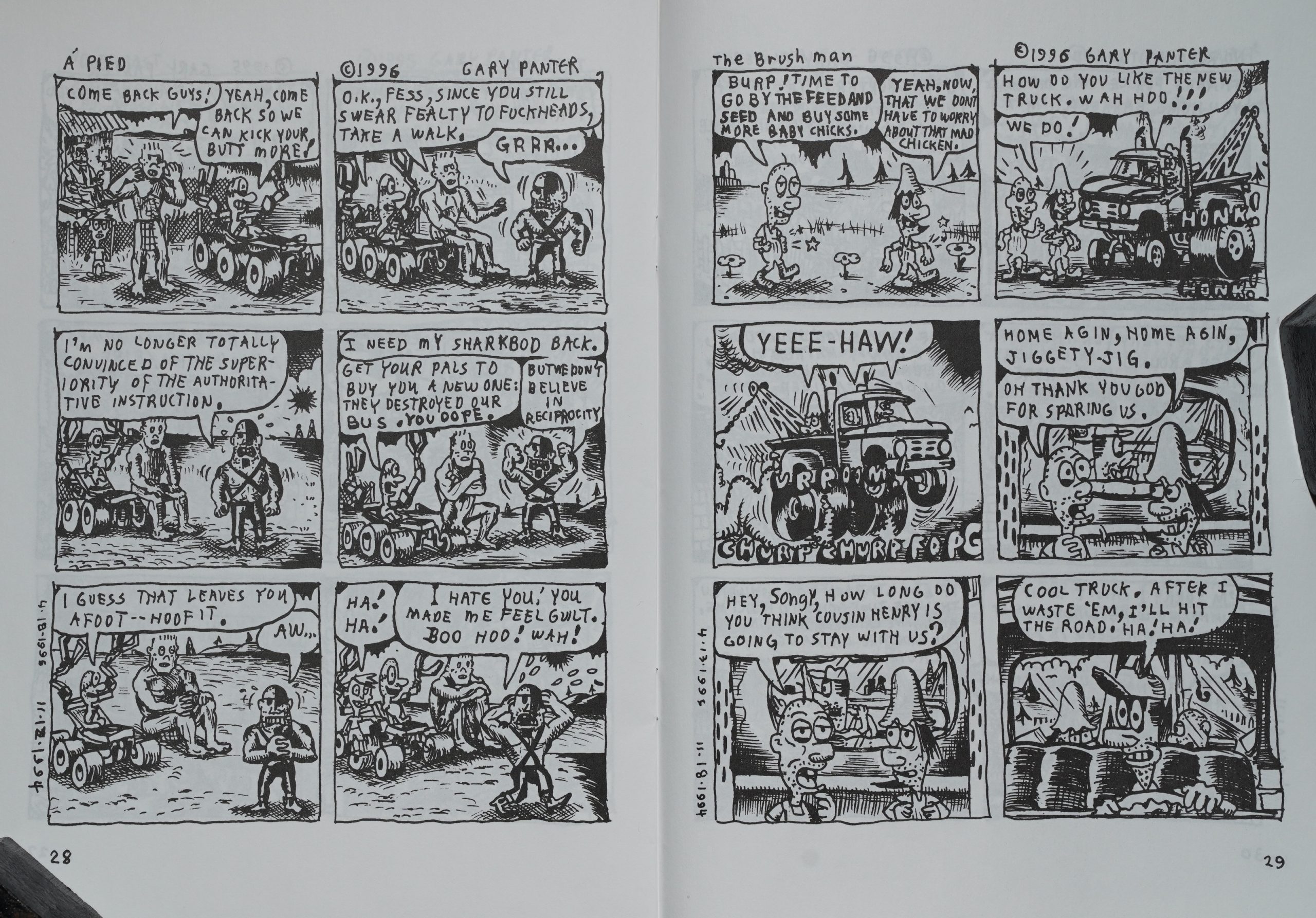
Panter even manages to bring all the different storylines to something resembling a conclusion, which I didn’t really expect.
These four issues have never been reprinted. Very strange — it’s probably the most straightforward and straightforwardly entertaining Jimbo sequence there is.
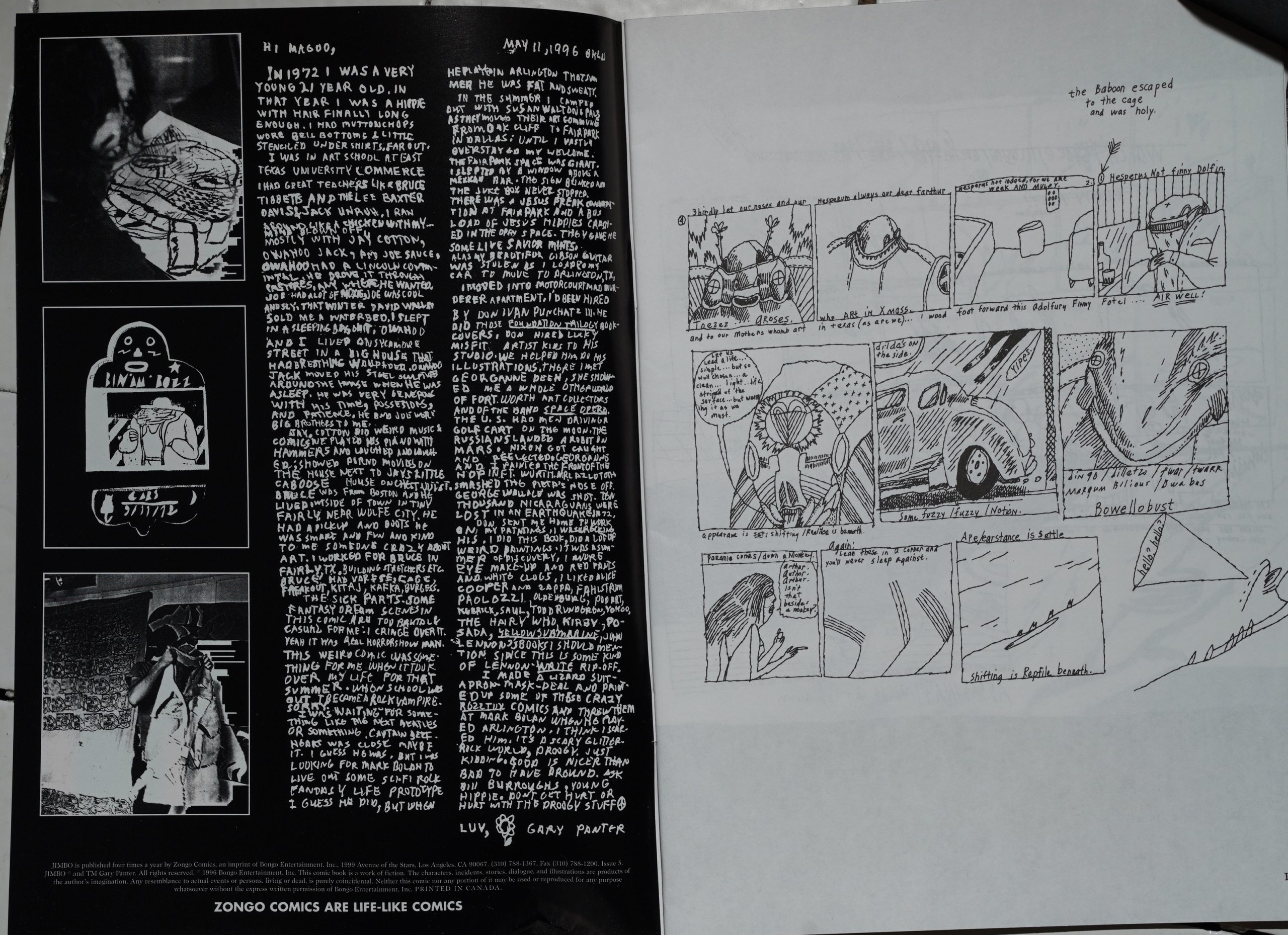
But there’s three more issues to go. Number five reprints work that Panter did in 1972, while still in art school in Texas.
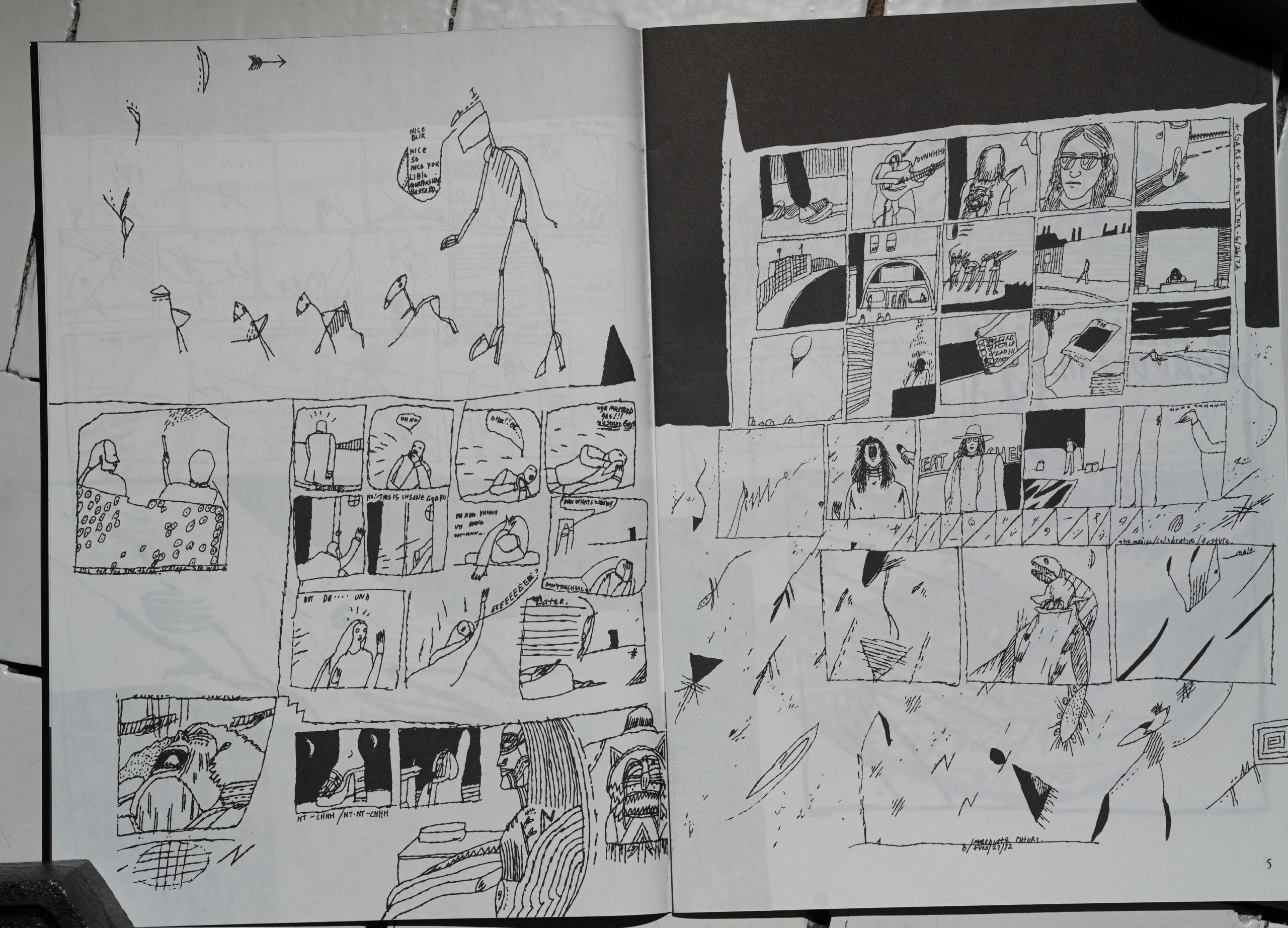
It’s mostly non narrative. It’s kinda interesting.
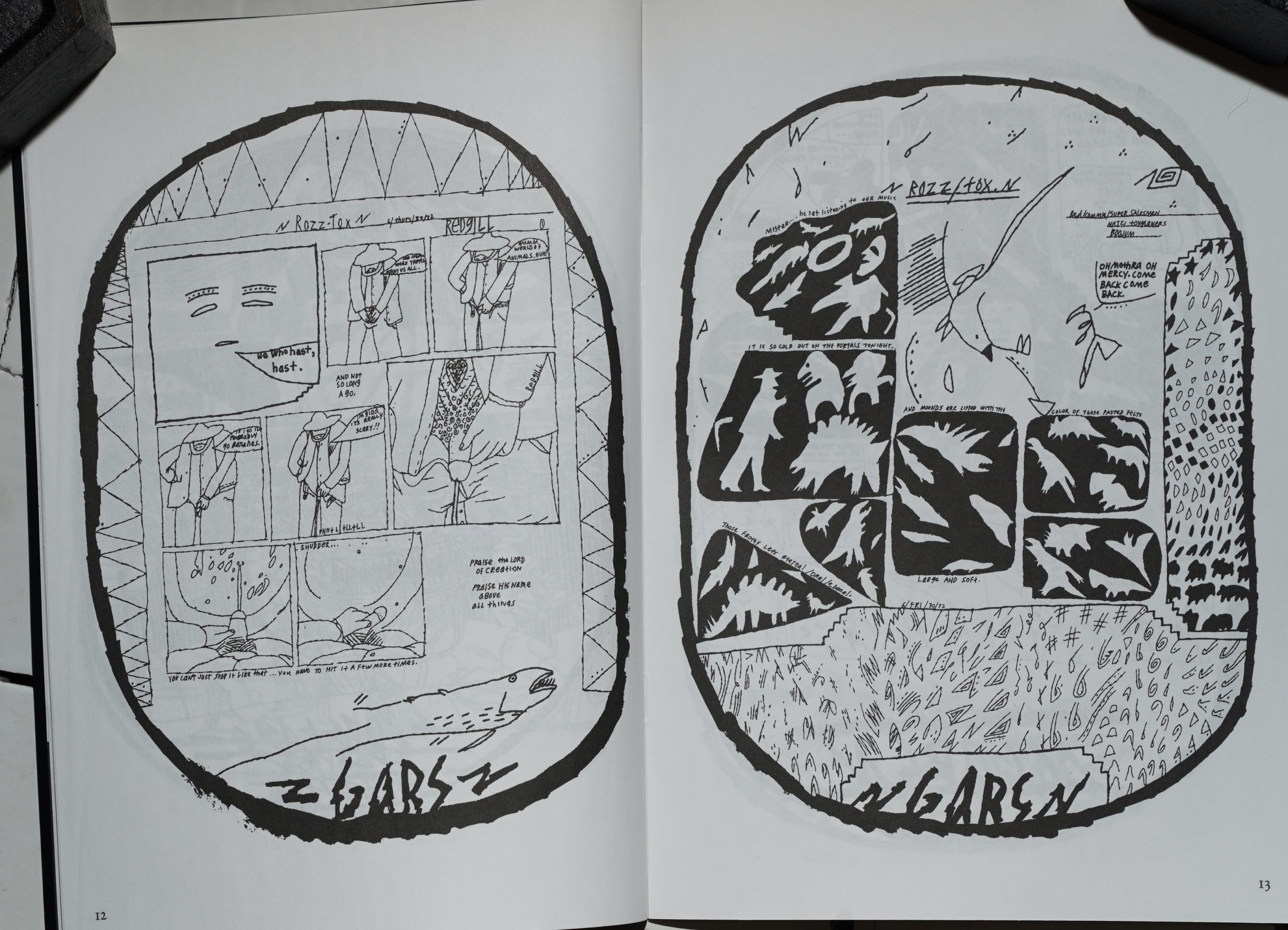
Some of these pages do seem to point forward to Panter’s later style, but it’s not … very evident.
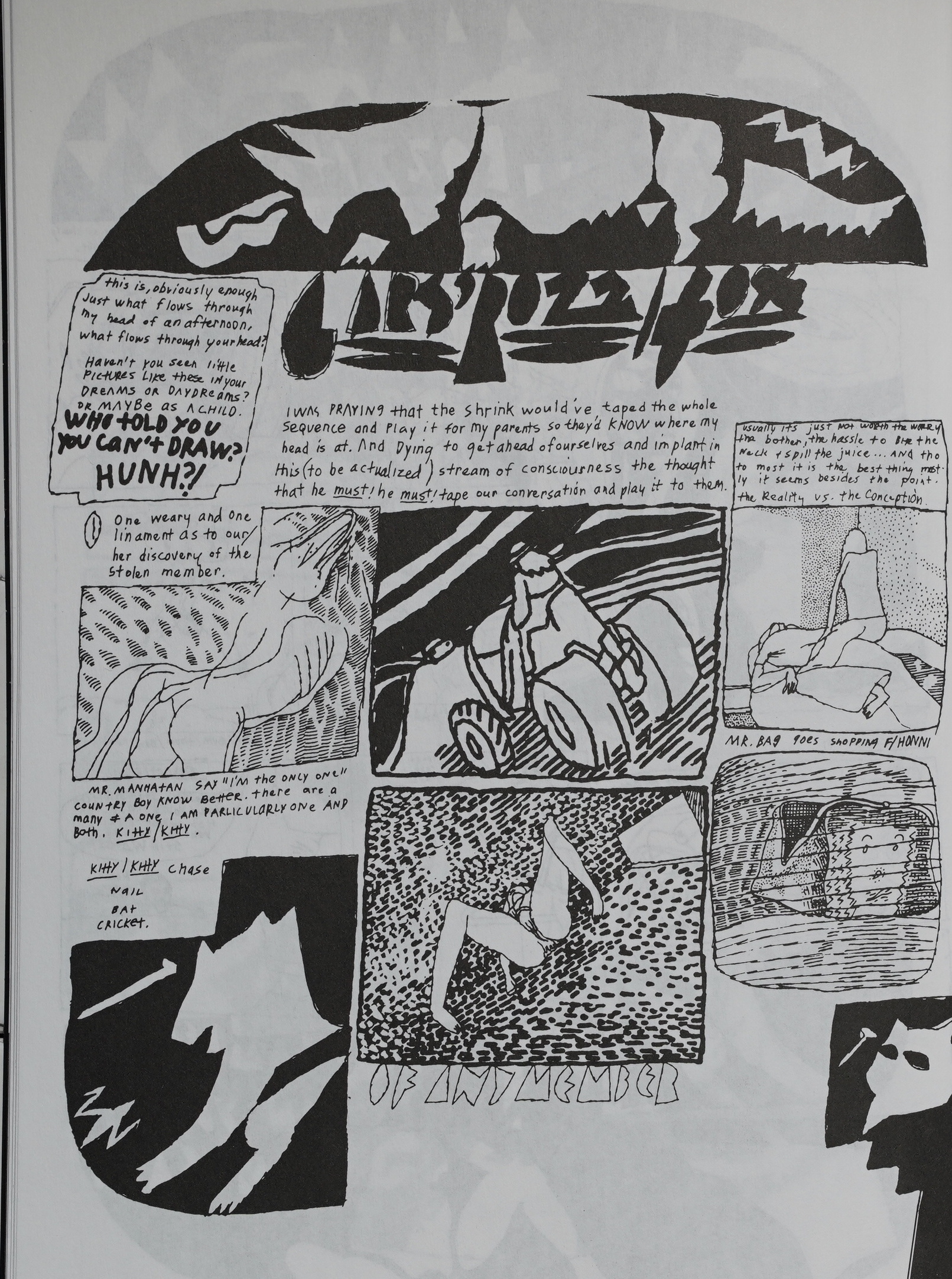
Garsn/Rozz/Tox? “Who told you you can’t draw?”

Heh heh. Panter was selling a $500 painted bed set? I should have ordered one! I sleep!
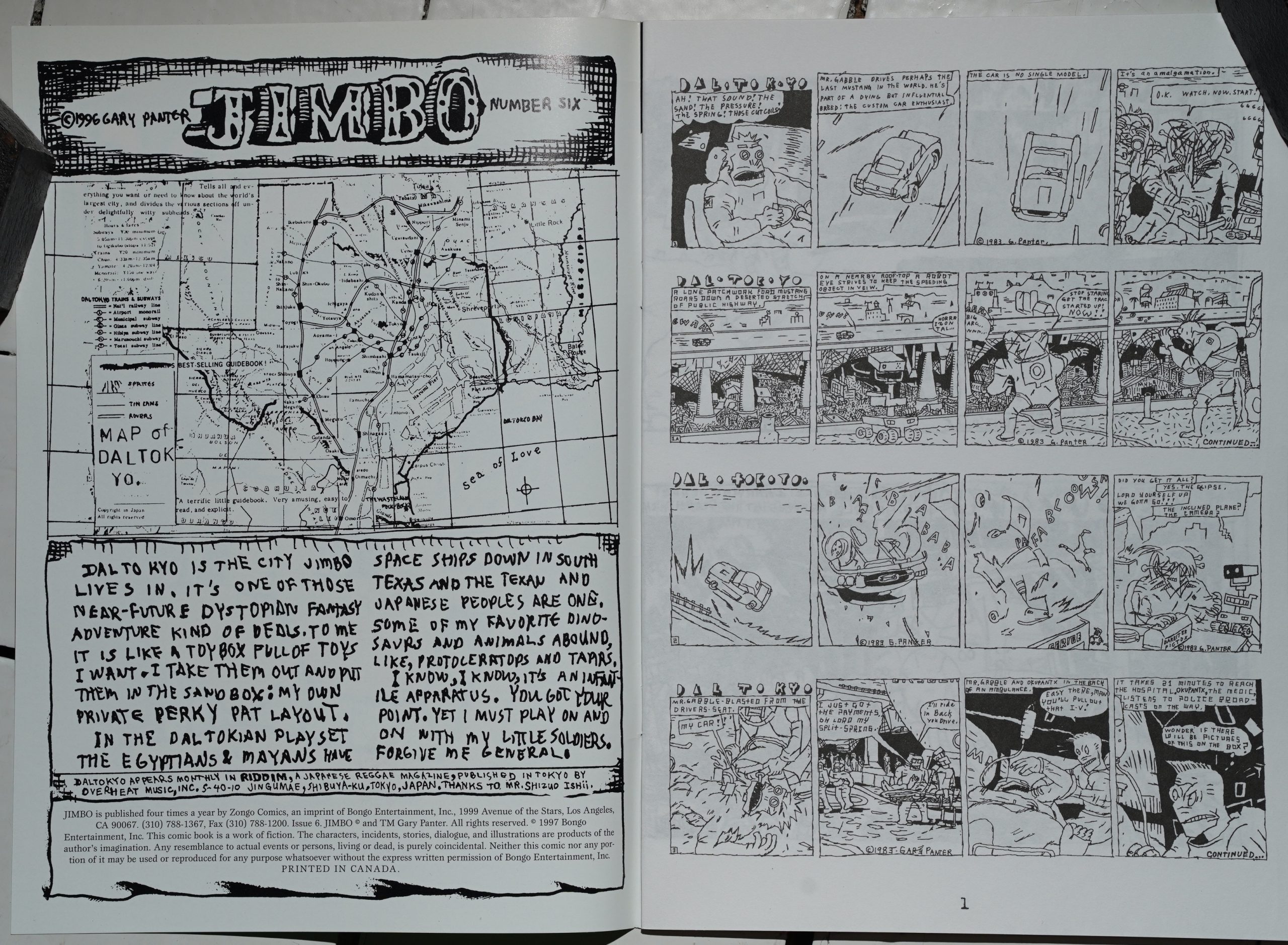
The sixth issue is the Daltokyo strips that Fantagraphics would later reprint in a much larger format, so I didn’t re-read these now — I’ll save that to when I cover the Daltokyo book.
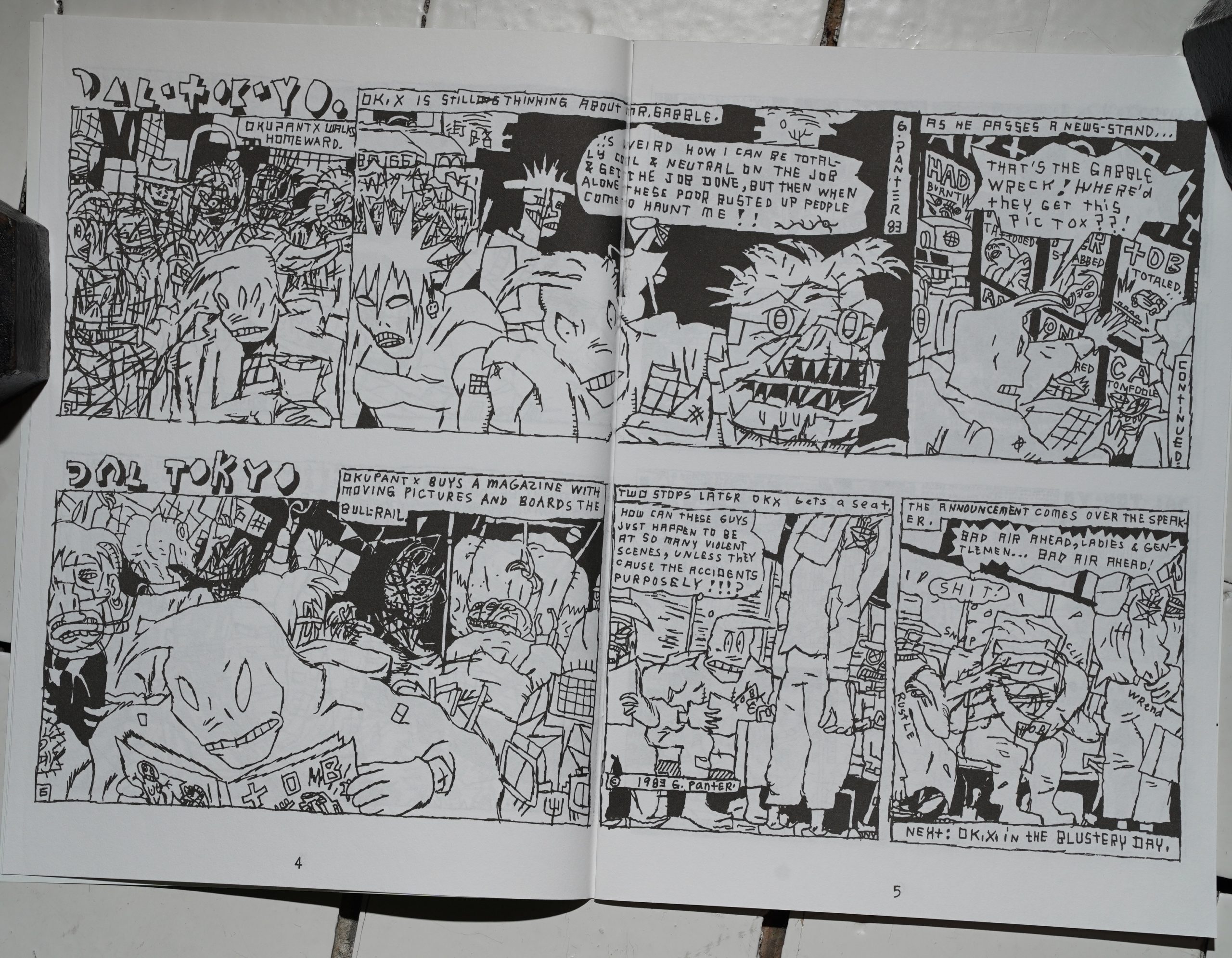
The strips look pretty cool printed in this format…
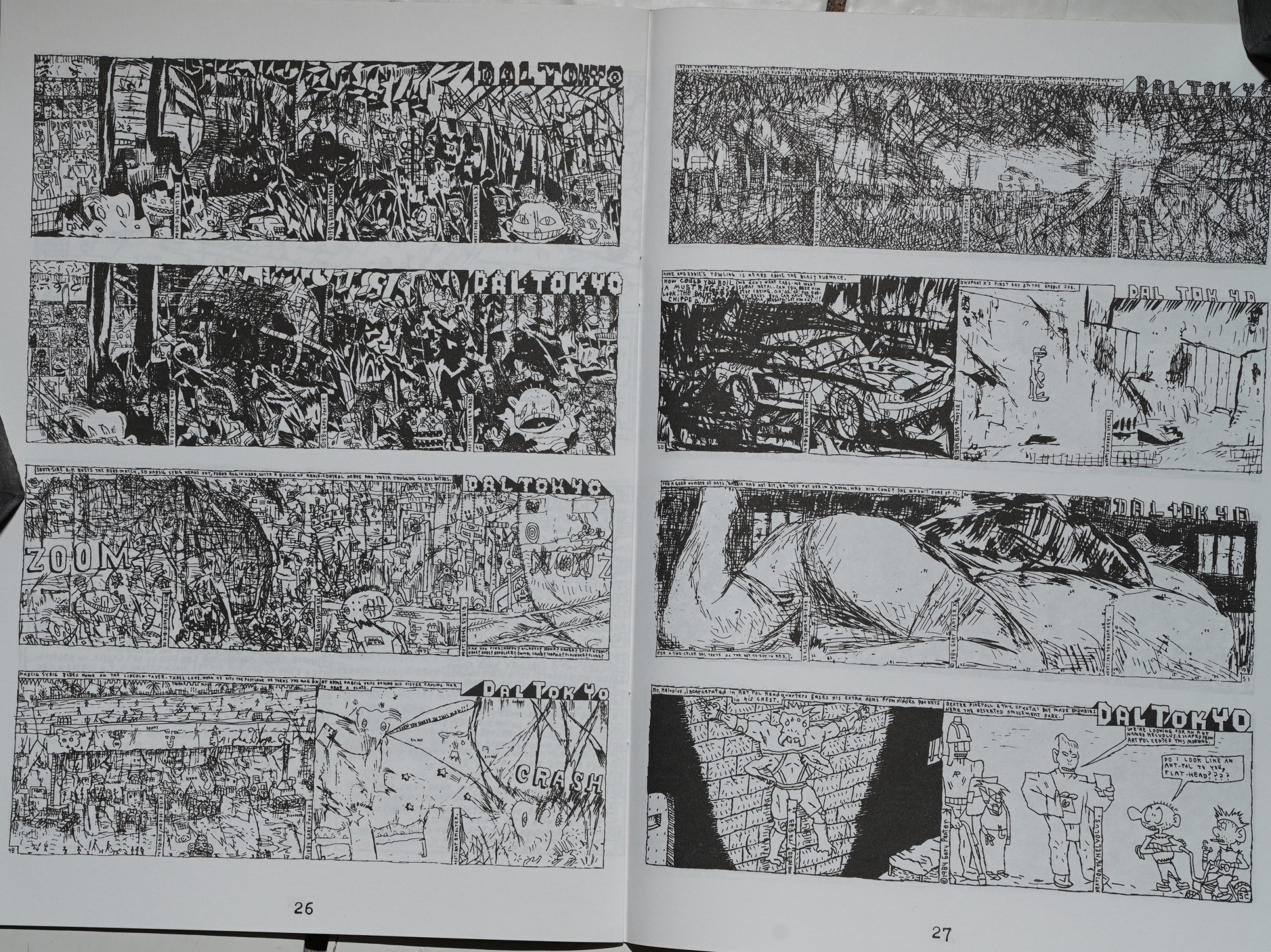
… but cramming them into the pages like this makes them pretty unreadable. But it does have a certain graphical overwhelming quality, eh?

Such merchandising. Cuddly Jimbo. Made in “San Francisco” by hippies. With an unusual ‘squeeky penis’? I should have gotten one of those, too, but I was a poor student in 1996, so…
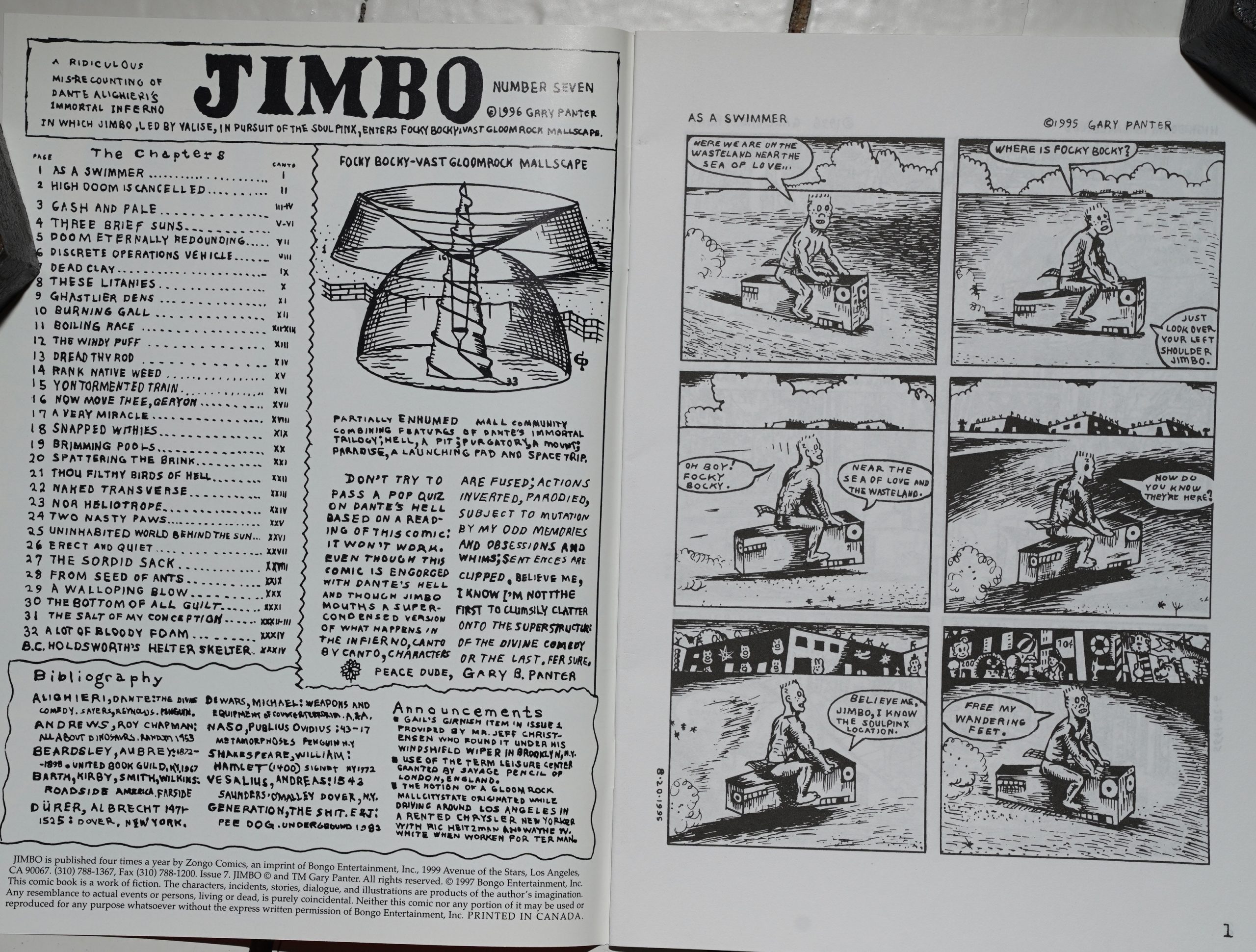
Finally, we have the seventh issue — the Jimbo’s Inferno issue, which (again) was later reprinted by Fantagraphics in a much larger format, so I’m skipping re-reading this one too for now.
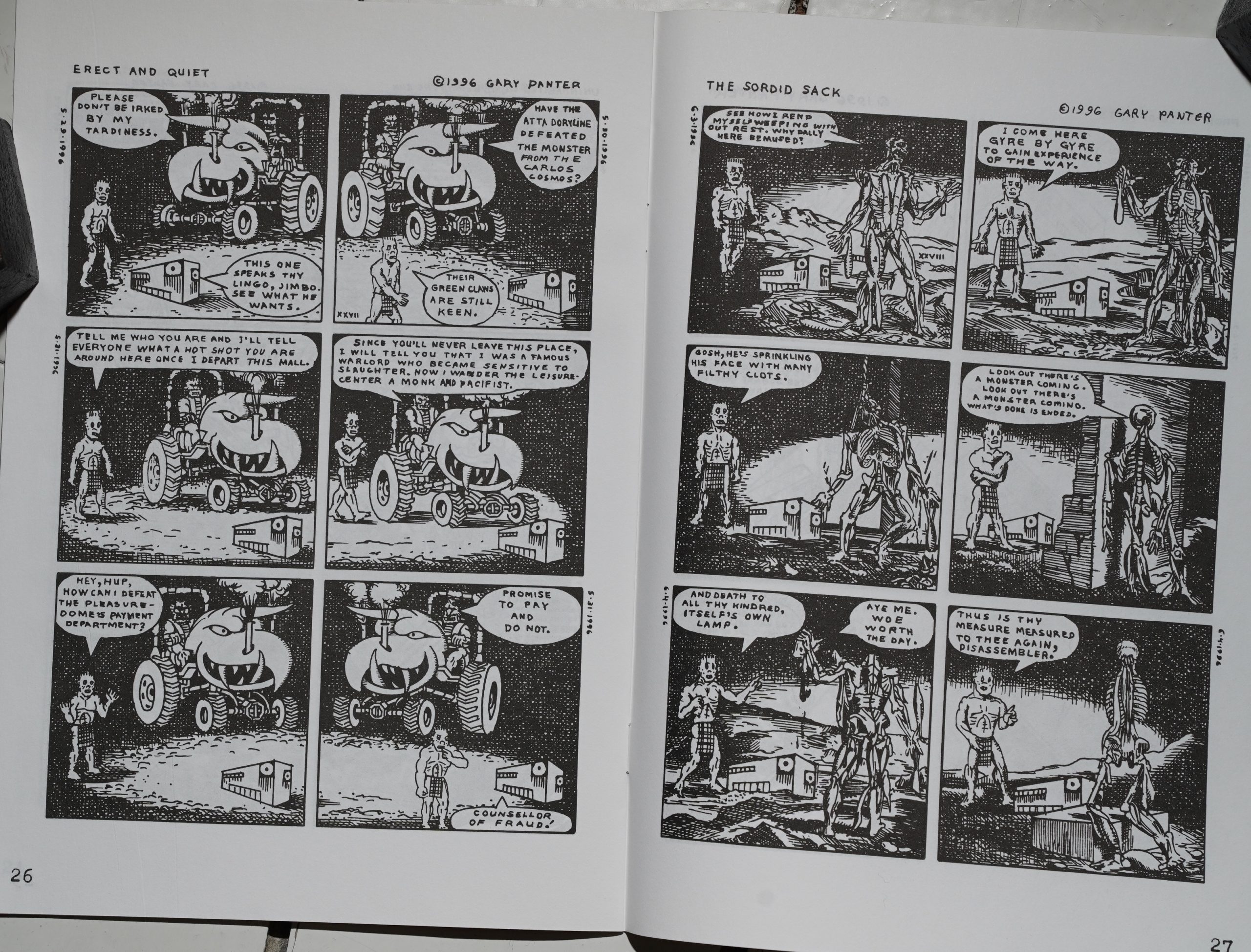
But it does look pretty good here.
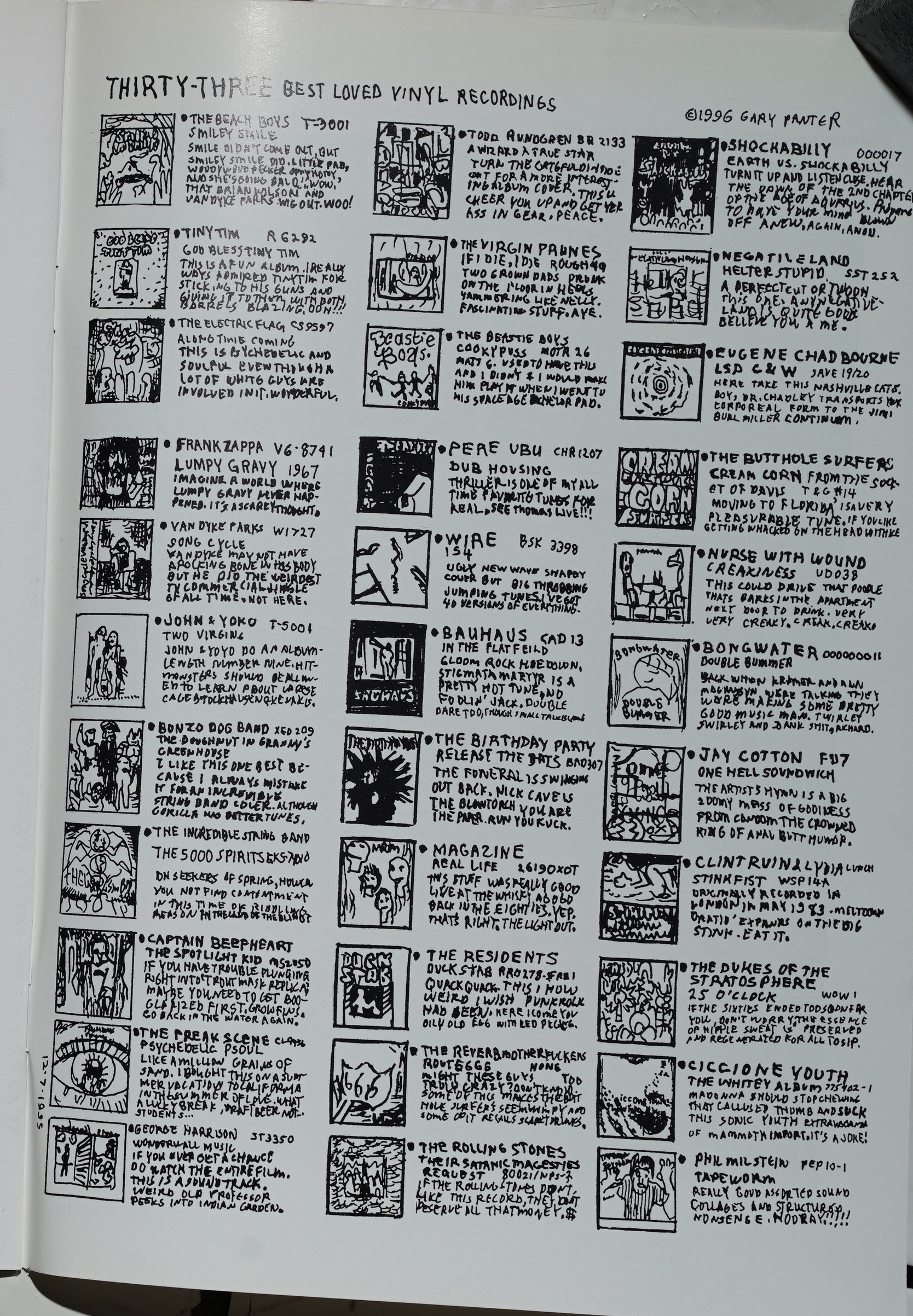
Panter’s favourite music… Hm… yeah, that’s a pretty consistent taste in music.
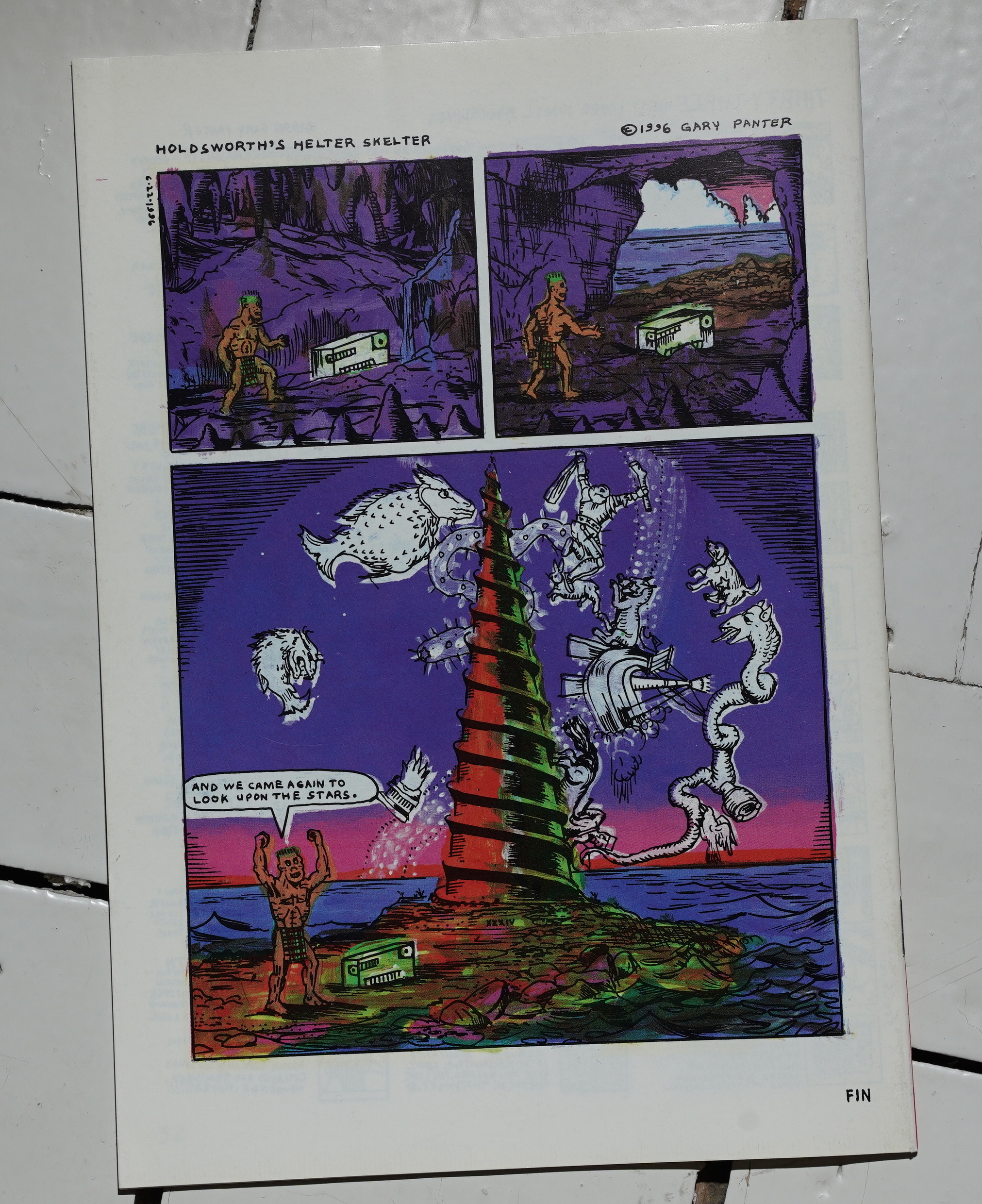
Colour back page! Nice.
Now then — I got these comics back when they were published, but googling them now is pretty weird, because:
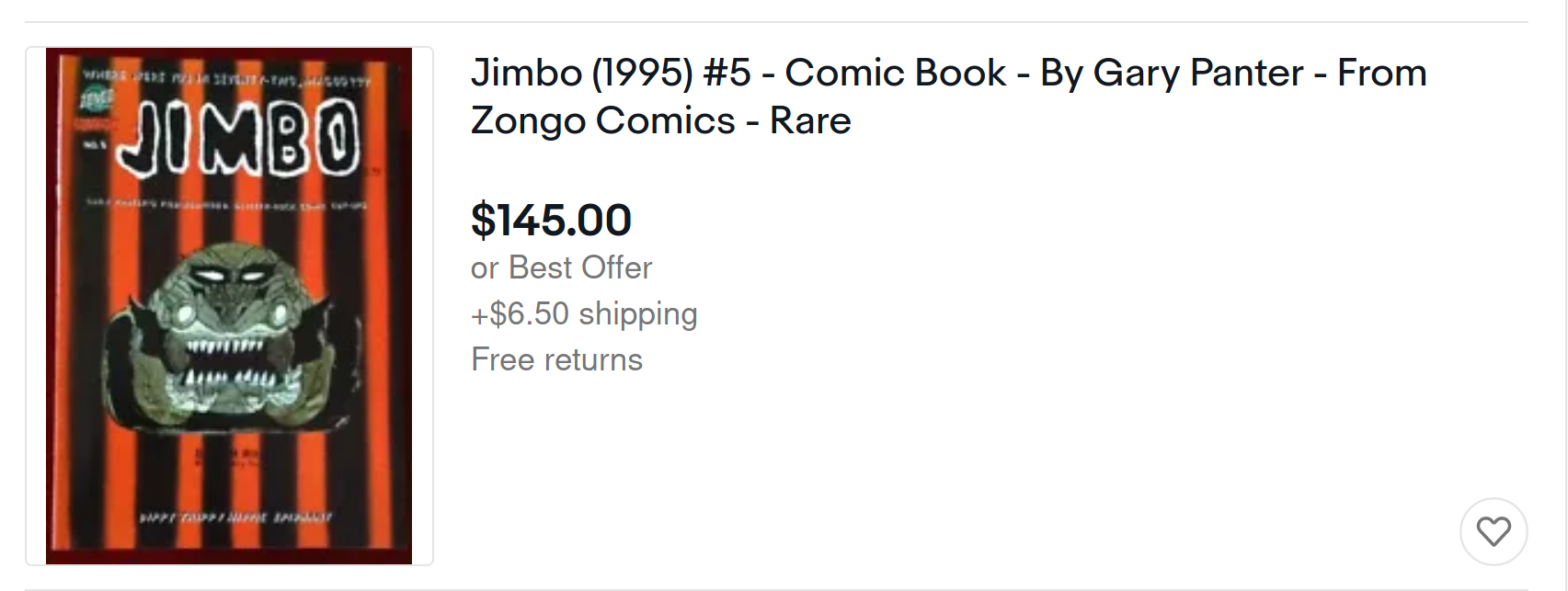
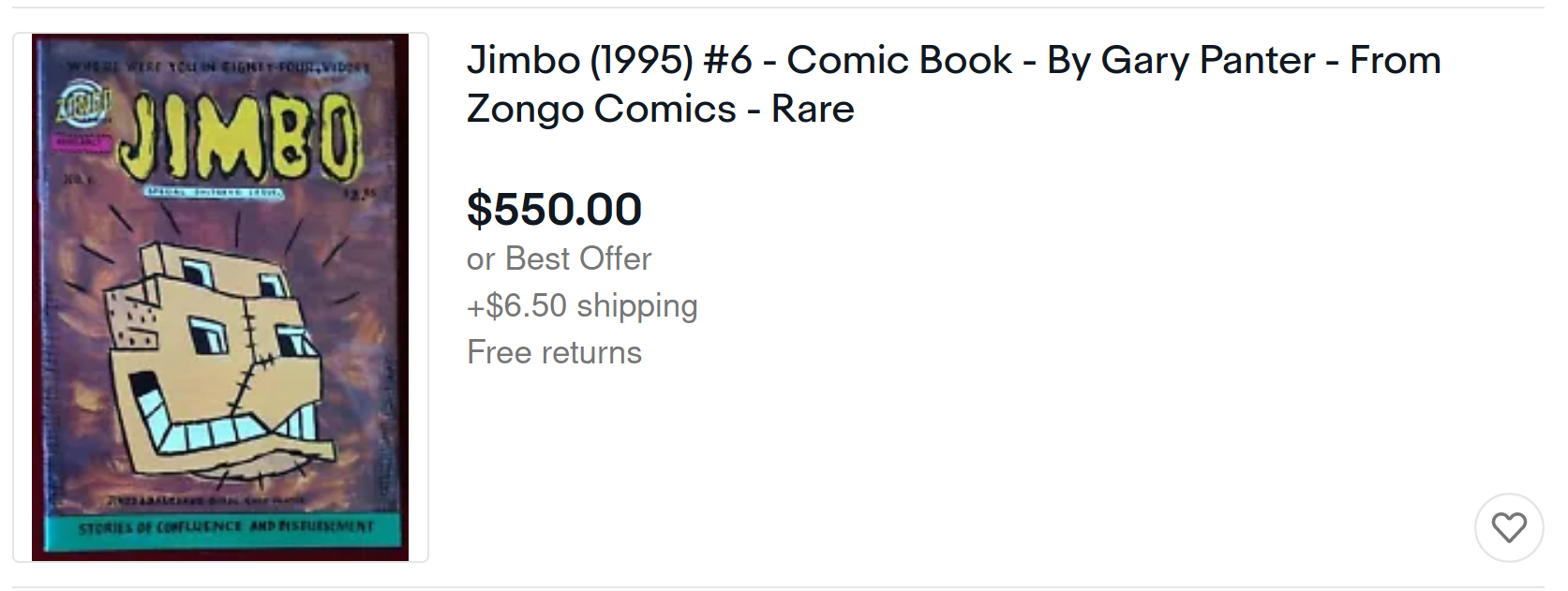
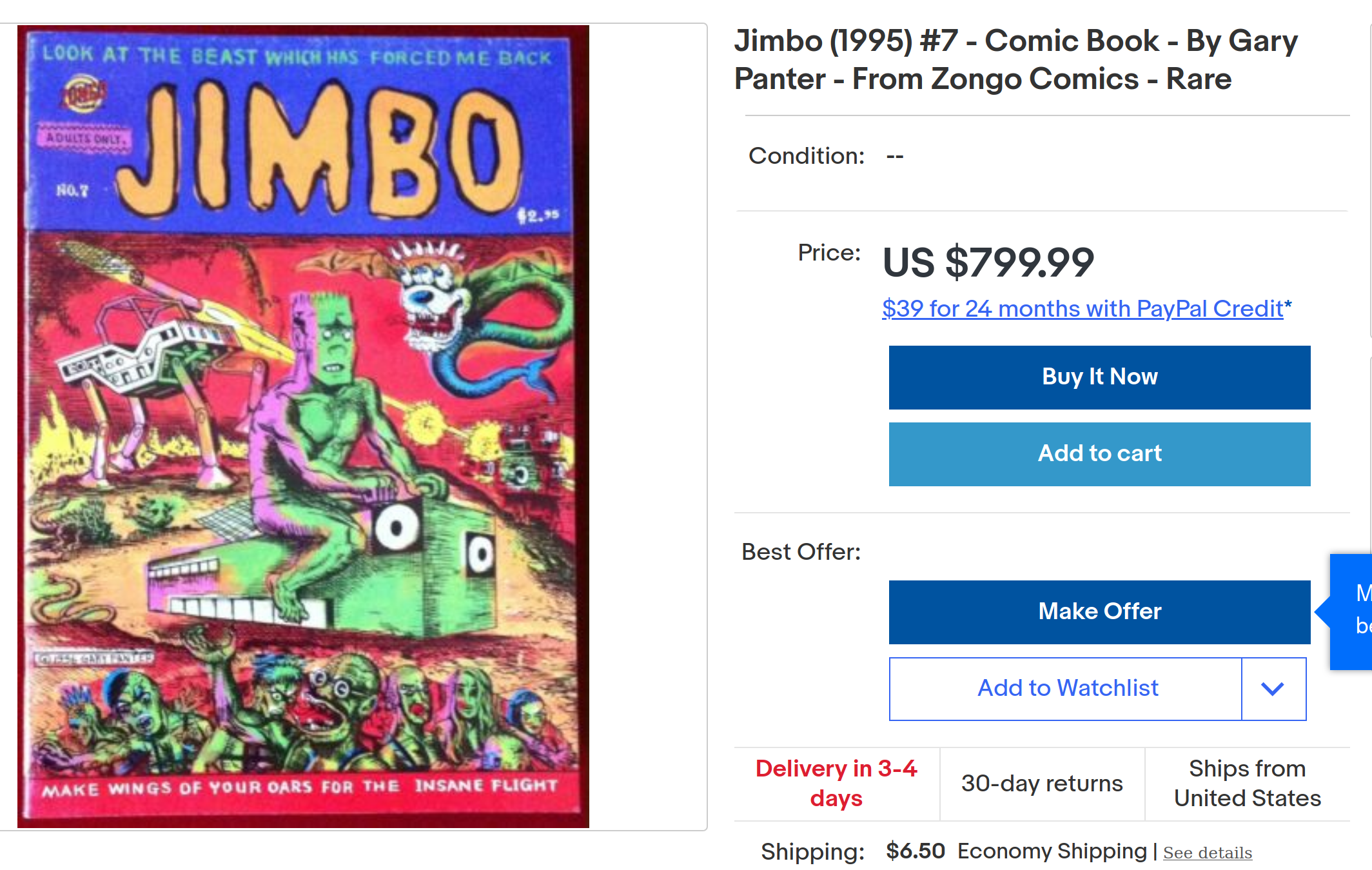
Now, people on ebay trying to sell something for absurd amounts doesn’t mean that anybody’s actually buying them for that price. But perhaps it’s true:
Here’s a Jimbo (1995) #7 – Comic Book – By Gary Panter – From Zongo Comics. Less than 500 made.
That’s not a lot of copies.
I’ve linked to ebay prices for stuff in this blog series before, and I’m not really that comfortable doing so, because I’m not really the collecting type — I buy stuff to read it. But this is kinda mind boggling. Are there really people that are such fanatic Panter fans that they’ll pay $800 for Jimbo #7 — a book that has been reprinted, in full, in a much nicer edition later?
Is it the rabid Simpsons fans? That have to have everything published by Bongo?
It’s just weird.
(I also find it delicious that the best “comics investing advice” you could have given somebody in 1995 would be to buy Jimbo; not those holographic foil variant editions from Image Comics. Tee hee.)
But I also want to say that I really admire Groening (and Bongo) for sticking to their guns and going ahead with publishing Jimbo even though nobody in the Direct Market wanted to buy them. At 500 copies, it had to be a money sink. On the other hand, with Simpsons money…
And that first issue of this series wasn’t exactly confidence inspiring — it was easily the least interesting issue, and I’m guessing virtually all comics shops stopped ordering the series after seeing that one.
Jay Sullivan is interviewed in The Comics Journal #212, page 92:
STERENS: The Atomic City story is a sad one.
SULLIVAN: Tell it.
STERENS: les a long, drawn-out story. les almost a
tragedy from the beginning.
SULLIVAN: Why?
STE*ENS: I begged Michel to do it, then I had to insist
he pay me, which was a new thing at the time, and then
it didn’t really sell. Let it be known, though, that
publishing-wise, everything Ive done has been at the
worst possible time. I mean, Tragedy Strikes entered
publishing right at the beginning of the glut, and by
the time I was doing Atomic City Tales there were
thousands of new crappy superhero comics out there.
The competition on the rack was unbelievable. m not
making excuses, m just saying it had something to do
with it.
so it was a really hard go, and I think Michel
became embarrassed that he “‘as doing Atomic City
Tales. He was focusing on more and more so-called
highbrow material, and was very proud of it. Even
though my stuff was selling better than that stuff, I
think he was kind of nervous that he was doing this
book that was more rooted in pop. We were both
happy when I decided to shop it around elsewhere. So
we left on amicable terms, and I began negotiations
with Matt Groening’s Bongo Comics. Actually, Zongo
Comics was supposed to do it, because rd met Matt at
San Diego in ’94, and gave him copies. He very
interested in picking it up, and promptly passed it over
to the people at Zongo, who rm sure he believes are
very capable [laughs] individuals. Maybe theyre more
capable now, but it was a nerve-wracking experience.
They wanted more than they should have been asking
for. They were a new company. It was a terrible
contract.
SULLIVAN: Were they frying toget control wer the tharac-
ters?
STERENS: Theywanted all control. They wanted to be
able to make movies and cartoons and not pay me
anything for it. Embarrassing, ridiculous control. And
what was worse was that the negotiations dragged on
for almost a year.
The contract came in two parts. The first part was
the publishing agreement, which mentioned that there
was a media agreement shortly to follow. We spent
months hammering out the publishing thing. They
had no provisions for return of artwork, for crying out
loud. We finally worked that out, and then got the
media one and were just blown away. I had to get an
agent, because I was dealing with these people. This is
when I first met Jean-Marc L’Officier at Starwatcher,
who is a saint, and has become oneof my closest friends
in the comics business. Anyway, he got the contract in
San Diego the year I didn’t go, which was ’95. Right
there at the convention, he called me and said, “Listen,
this is terrible, and I have to ad-
vise you not to sign it, even though
we’ve spent time and money try-
ing to do this.” So I didn’t have
anything come Out in those ten
months. It was a terrible, terrible
time for me — at the same time,
my marnage was over.
We pulled the contract from
them, went straight to Kitchen
Sink and signed it. It took me
awhile to realize that by the time
I’d signed that contract, my inter-
est in Atomic City Tales had been
sincerely dampened by the whole
experience. It was hard for me to
get motivated about doing it for
Kitchen Sink. I’m proud of the
issues I did at Kitchen Sink, but it
was a very different project by
that time.
Wow. Well, OK, that’s pretty much what I’d expect from Bongo Comics, but I didn’t think they’d be that way for the Zongo stuff…
Ray Mescallado writes in The Comics Journal #178, page 53:
I’VE ALWAYS had a problem with Gary
Panter’s work. His ratty aesthetic Of second-
childhood-by-way-of-psychosis often seems to
portend more than it actually delivers — the sly
primiti vism hints at profound complexity while
refusing to say anything definite. As a result, I
sometimes can’t tell when Panter is provoking
the reader for a reason, or simply indulging
himself at the audience’s expense. On the one
hand, the Jimbo strips from Raw Vol. I #’s 6
and 8 remain vivid proof of how fine art can
enter comics in a radically different way.
Throwing his infamous punk protagonist into a
nuclear holocaust, Panter’s blend Of painterly
and cartooning effects border on the horrific
and hallucinatory, a perfect complement to the
pathos the star character experienced.
In contrast, much Of Jimbo #1 — the first
title from Bongo Comics’ “mature” Zongo im-
print — is a sterile effort, void of substantial
pleasure or provocation. And while it’ s perhaps
unfair to compare an artist’ s early work to more
recent ones, I still feel like a chance was some-
how missed here… and worse, missed on pur-
Like Mark Beyer and Matt Groening, there
are frequent points Of disturbing insight in
Panter’s vision, treading the thin line between
fantastical child-like imagination and neuroti-
cally creative morbidity. That comes through
only occasionally in Jimbo The narrative
format doesn’t help: each page is a discrete
comic strip with the names of that page’s char-
acters as a “title,” and the “story” is really two
separate plot lines and some single-strip
randomness. Like others from the Raw
school Of comix creators, Panter shows a
fondness for hollow delivery and unfunny
punchlines; however, his use of these de-
vices isn’t as effective as, say, the more
antagonistic non-humor Of Mark
Newgarden, or the existential blankness
Ben Katchorevokes. The majority of strips
in#l deal with Henry’s visit to his hillbilly
cousins, Songy and Yoyo: when he first
arrives, Henry finds the pair in the out-
house, “lookin’ at pictures of pretty girls
in the catalogs.” I hoped it wouldn’t sink
any lower, and there’ s a flash Of true — if
overplayed — humor when the country
cousins are dismayed about chicken-kill-
ing season on their farm, only to have
Henry volunteer for the task. Songy and
Yoyo freak at their cousin’s sudden
bloodthirst, but the Story takes a ludicrous
turn with an unexpected amputation and
an ensuing sub-sitcom frenzy.
Well, that not a totally unfair reaction to the first issue.
Eric Reynolds (I think) writes in The Comics Journal #177, page 10:
At one of Marvel Comics’ re-
cent “Marvelution” meetings;
a company rep gave an edito-
rial preview of Bongo Comics,
which is being distributed by
Heroes World. After running
down the various Simpsons-re-
lated comics, the rep added
somethingtotheeffectof, “Oh,
-and there’s also this thing
called Zongo Comics, which is
basically Matt Groening’s
avant-garde pals. The first
comic from that is, uh… Oh
yeah. um,Jimb0. by Gary Ban-
ter? No… Gary Panter.
That’s it.”
A quick look at Jimbo #1,
due in June from Bongo’s new
creator-owned imprint, and it’s
not hard to figure out why a
Marvel Comics representative
would have a hard time com-
prehending Panter’s talent.
Panter proudly describes his
drawing as “ratty” — a word
which certainly applies
though it’s hard to imagine
Spider-Man fans using the
word as anything other than
a perprative.
Ignorance is bliss. or so the
saying goes. The fact is, Panter
has very much revolutionized
both comics and commercial
art in the last 20 years, some-
thing thatnoSpider-Man artist
can claim. From Frank Zappa
albums to Time magazine cov
ers, from Pee- Wee’s Playhouse to
hischildren’scomicKaÆrusVa/-
ley, Panter’s expressionistic,
style and D-l-Y ethic has ins
fluenced a generation Of artt
Ists.
Jimbo #1 is hilarious. Join
Jimbo, Percy, Fluke, Fish-Car-
rot-Eye, Lady and Baby, Songy
and many others as they con-
template the meaning of fax
machines and ch icken killings.
The covcrsays it all: “Hillbilly
punkers explore the world un-
known.” Buy several copies
and watch the fanboys run for
cover.. ER
Somebody writes in The Comics Journal #210, page 53:
Even in the series’ latest
incarnation, a line of poor-selling
comic books from Groening’s
Zongo line of creator-
owned comics, Jimbo
fascinates. There, seem-
ingly tossed-offpanels and
cartoons are slowly re-
vealed to be a vast,
complex, and eminently
logical epic work, shock-
ing in the artistic bravado
of several beautifully
drawn sequences. And bo-
nus ofall bonuses, that epic
is a hilarious, wonderfully
loose and insightful story
about the awful world in
which we live — a fitting
vehicle for the last great
everyman character of the
20th Century.
Eric Reynolds (again) writes in The Comics Journal #188, page 148:
“Z ongo
Comics
are swell
comics.” as
the company
line goes. and yes, there is truth in advertising.
Jimbo #1 got an inordinate amount of hype for an
alternative comic because of its publisher, and I
StJSr*Ct this may have been to the book’S detriment.
For the collectible-tyrrs who bought Jimbo out Of a
desire to have all-things-Groening and were unfa-
miliar with Panter, the first issue must have been a
confusing and frustrating read. With pages that
look like they were drawn at a rate of four a day
(many were) and all of the seemingly unrelated and
loopy things going on. I’m sure more than a few
Simpsons fans felt ripped off.
It’s their loss if they gave up that easily. With
the recently released fourth issue. Panter
brings everything together, and hon-
estly, all four issues make sense. Jimbo
is reunited with Bob War and the bus
guys after his incarceration at the Time
Motel (although it is still unrevealed as
to why the pupface provoked the
friendcatcher — an upcoming Story
are?). Henry, Songy, & Yoyo escaCE
the really big chicken and their
connection to Fluke and Groty
is revealed. Although one
must assume the Soulpink
girls will yet again
meet up with
Jimbo. and there’s
still Henry’s
cret plans for 0
Songy & Yoyo to deal
with. but I’m Sure all
Of this Will be re-
vealed in later issues, and Panter does a remarkable
job Of pulling a cohesive and engaging narrative
out of what originally seemed to be unrelated
scrawlings. It’s somewhat reminiscent of Chester
Brown’s “Ed the Happy Clown” in terms of
story structure. and is just rewarding once every-
thing together.
Read Jimbo 1-4 all at once. It’s fun. It’s punk.
It’s hillbilly existentialism. What more could you
ask for? There’s even an anagram for you gaming
fans on the front cover Of #3, which as far as I
could tell reads, “Gary Panter and NPR berate
traps,” although persistent readers may extrapolate•
further enlightenment from the jarbled letters.
Between Jimbo and Fleener. Zongo is a wel-
come addition to the world of alternative comics —
let the fylboys be damned. If superheroes are in-
deed on the outs. then new heroes will have to rise
in there place, and Jimbo seems as good a place as
any to Start.
Panter is interviewed in The Comics Journal #250, page 241:
KELLY: NO, think it’s interesting. If you
could briefly break it down ..
PANTER: It’s going to sound totally pre-
tentious, but really it’s just a real natural
thing: It started with the Zongo comics.
I thought I was going to do a quarterly
comic, so I wanted to make it very expe-
dient, so I started drawing it as simple as
I could, because you would have to draw
a comic page every other day to do a
quarterly comic. I was reading Joyce,
who has this theme of an embryonic
maturing. That’s what I wanted to do
with that series of comics: Start it real
simple and every issue would get tighter
and tighter, within my spastic range. By
the seventh issue, it was pretty tight and
things were anatomically closer to being
correct, and it has more 19th-century
crosshatching and stuff. Thanks to Matt
for that. He Was a real pal, publishing
those comics. Jimbo In Purgatory contin-
ues the narrative begun in the seven
Zongo comics, which follows Jimbo to a
giant mall call Focky Bocky in pursuit of
some bald-headed girls.
Looks like my guesses were pretty wrong.
1000?
So hey, new Panter! But “Jimbo”, the pamphlet series released by Zongo, only lasted seven issues. Indeed, according to Panter himself (scroll down a bit), the book was “completely, terribly unpopular,” and by the end, only about 1000 copies of each issue were being printed.
[…]
Go hunt for these comics.
At least the first five.
This blog post is part of the Punk Comix series.
